

How Much Do Boats Weigh? (Ultimate Data Chart)
The weight of a boat can vary a lot mostly depending on the length of the boat and the materials used for the boat. There are also many other factors such as size/amount of engines, size of the fuel tank, amount of gear on board, size of the cabin, and much more.
However, if we generalize based on length: small boats that are 17-22 feet weigh around 1,600-3,200 pounds. Boats 23-27 feet weigh around 3,600-4,800 pounds. Medium-sized boats 28-35 feet weigh around 5,800-13,500 pounds. And large boats 36-45 feet weigh around 15,500-29,000 pounds.
These calculations were found by taking many examples of boats within each boat category. However, If you want a more precise answer that considers lengths and material, continue reading to the “ Boat and trailer weight based on the type and length of a boat ” sub-heading.
It’s important to note that boats made from aluminum tend to be around 300-1,500 pounds lighter than similarly sized fiberglass boats.
Table of Contents
Knowing boat weight terms
Before getting specific with all the different boat types, knowing these terms will help you understand the data better.
If you’ve ever tried finding the weight of a boat, you’ll notice that manufacturers use a lot of different wordings. These may include dry weight, wet weight, curb weight, package weight, gross trailer weight, actual boat weight, and more.
Understanding the difference between these is important, especially if you plan on reading the rest of the article. So let’s get into it:
Dry weight is the most common weight statistic you will find on a manufacturer’s website that states the weight of their boats. It means the weight of a boat without any engines, fuel, water, or accessories. In other words, the weight of a boat straight from the factory.
Some manufacturers may include engines in dry weight, but if they do so, they will usually tell you.
Unfortunately, this number isn’t the number boat owners need; however, it’s usually the only number provided. I usually assume that the wet weight of a boat is around 300-1,500+ pounds more, mostly depending on the amount/size of the engines and the size of the fuel tank.
Wet weight/curb weight
Wet weight, also known as curb weight, is the weight of a boat including engines, accessories, fuel, oil, and any other liquids. It does not include the weight of passengers or cargo.
This is one of the most important terms you’ll need to know for your boat as it will help you find your needed vehicle towing capacity, boat lift weight capacity, and other miscellanies things.
Package weight/gross trailer weight
Package weight, also known as gross trailer weight (GTW), is the wet weight of your boat plus the weight of your trailer. This is the weight you need to know for towing.
Most trailers weigh around 600 pounds for small 17′ boats to 1,900 pounds for larger 26′ boats. Most boats over 30′ are not trailerable unless you opt for an oversized load.
Actual boat weight
Actual boat weight means the wet weight of your boat plus any equipment, people, or cargo on board your boat. If a lot of people are on board or if you have a lot of heavy fishing equipment, it will significantly raise the weight of your boat.
Factors that go into how much a boat weighs
Besides the size of a boat, there are some other factors that go into how much it will weigh including:
- Material used
- Size of engine(s)
- Amount of equipment
- Amount of batteries
- Size of the fuel tank
- Amount of fuel in the fuel tank
- Amount of water within the boat
- Amount of gear you have on-board
Most of these are accounted for in the averages I’ve provided, but if you are trying to estimate the weight of your boat and you know you have an abnormally heavy or high quantity of these things, make sure to account for it.
Boat and trailer weight based on the type and length of a boat
There are many different boat types, all of which have different weights. Below I’ve listed the weights, trailer weights, and gross trailer weights (wet weight of boat plus trailer weight) of many different boat types. Click on the boat type below to be directed to which one you want to see.
There are two popular materials used to build bass boats, fiberglass and aluminum. Fiberglass is much heavier than aluminum, so I decided to split up the two in order to give more precise averages. So:
On average, fiberglass bass boats weigh around 1,400-2,200 pounds. Aluminum bass boats weigh around 700-2,000 pounds. Their gear, fuel, and engines generally add another 400-700 pounds and their trailers generally weigh around 500-1,200 pounds.
Average fiberglass bass boat weight by length
Average aluminum bass boat weight by length.
Related Article: How Much Do Bass Boats Weigh? (17+ Examples)
On average, Bowrider boats weigh around 1,500-8,750 pounds mostly depending on their length. Their gear and fuel generally add another 500-1,600 pounds and their trailers generally weigh around 800-2,300 pounds.
On average, pontoon boats weigh between 1,600-2,400 pounds (726-1,089 kg), including the motor. However, some weigh up to 5,000 pounds (2268 kg). Pontoon boat trailers weigh between 1,000-1,700 (454-771 kg) pounds on average. Other weight factors to consider include gas, passengers, and gear.
Related Article: Pontoon Boat Weight: Can You Tow Them? (75+ Examples)
Sit-down jet skis weigh around 650-1,000 pounds, and stand-up jet skis weigh around 300-550 pounds. This includes the jet ski’s weight plus the weight for fuel and gear. Jet ski trailers weigh around 200-300 pounds, and double trailers weigh around 350-500 pounds.
Check out the weights of every new jet ski on the market in this article: How Much Do Jet Skis Weigh? (Plus Trailer Weight)
On average, ski boats weigh around 3,100 pounds. Their gear and fuel generally add another 250-600 pounds and their trailers generally weigh around 1,100-1,900 pounds.
There aren’t many true ski boats on the market anymore as they are being taken over by wake boats, however here are the weights of the top 3 on the market.
Related article: How Much Do Ski Boats Weigh? (17+ Examples)
On average, wake ski boats weigh around 4,000-6,700 pounds. Their gear and fuel generally add another 250-600 pounds, and their trailers weigh around 1100-1,900 pounds.
On average, aluminum deep V fishing boats weigh around 1,000 to 2,100 pounds. Their engines, gear, and fuel generally add another 350-700 pounds, and their trailers weigh around 500-1,100 pounds. Fiberglass equivalents generally weigh 400 more pounds.
In general, center console boats weigh between 1,100 and 8,500 pounds depending mostly on their size. Their engine, gear, and fuel add another 470 to 2,000 pounds, and their trailers weigh around 500 to 2,000 pounds.
Related Article: How Much Do Center Console Boats Weigh? (10+ Examples)
There are many different lengths and types of sailboats including both single-hull sailboats and catamarans. So their weight of them changes drastically depending on the exact make and model. However, According to Lifeofsailing.com , here are the general statistics:
On average, cuddy cabin boats weigh around 1,500-4,500 pounds mostly depending on their length. Their gear and fuel generally add another 500-800 pounds and their trailers generally weigh around 800-1,800 pounds.
Small cabin cruiser boats (30-40 feet long) weigh around 10,000-22,000 pounds. Larger ones (41-50 feet long weigh around 24,000-42,000 pounds. Their gear and fuel generally add another 1,100-4,800 pounds .
There isn’t an exact standard that defines yachts; however, in this article, I am considering them to be any recreational vessel over 50 feet long. It’s hard to find averages of boats this big as they vary a lot depending on the make/model. However, my data below is an average of three different models within each length, so it should at least give you an idea of how much a boat around that length should weigh.
On average, yachts that are 55-65 feet long weigh around 75,000-100,000 pounds, yachts 66-75 feet long weigh around 105,000-128,000 pounds, and yachts 76-90 feet long weigh around 137,000-205,000 pounds. Their gear and fuel add another 12,000-30,500 pounds.
How to weigh a boat?
The most accurate way to weigh a boat is to take it to a truck scale. Make sure it has all the gear and equipment in it that you need to have and weigh it. Also, note the amount of fuel that is in the boat as well. Gas weighs about 6 pounds per gallon, and boat fuel tanks can hold anywhere from 15 to thousands of gallons. You can then subtract out the weight of the trailer (which can be found by either weighing the trailer separately or just estimating using my averages).
Here’s what a truck scale looks like:

You can find these by just searching truck scale near me. Then try to contact them in advance or just show up at a location and they will most likely be happy to assist you if it’s within working hours.
If you’re unable to do that, most manufacturers will have the weights listed on their website; however, you may still have to do some estimating for engine, gear, & fuel weight as well as trailer weight. The data I provided above should also help you out with that.
What are the best vehicles for towing boats?
Making sure you are using a capable towing vehicle is crucial for the safety of you and others on the road when you are towing a boat. You can see a vehicle’s towing capacity by searching the make and model of the vehicle and then typing “towing capacity” after in the search bar.
It’s generally recommended to have a vehicle that is capable of towing 1,000 more pounds than the total weight of what you are towing. So in this case, the GTW would be the total weight.
Depending on how much your boat weighs, there will be different vehicles that would fit you best. However, below are a few popular vehicles used for towing boats:
Here are some popular SUVs used for towing boats
- Can tow up to 5,000 pounds.
- 2- or 4-wheel options.
- Can tow up to 7,800 pounds (V8), or 6,200 pounds (V6).
- All-wheel drive.
- Can tow up to 7,400 pounds.
- Turbodiesel option available.
- Can tow up to 8,000+ pounds depending on the model.
- Can tow up to 9,300 pounds.
- Can tow up to 8,300 pounds.
And here are some popular trucks
- Can tow up to 6,700 pounds.
- Can tow up to 7,000 pounds with the gas engine, and the diesel model adds around 700 more pounds of towing capacity.
- Can tow anywhere from 8,000 to 9,000 pounds.
- Can tow anywhere from 9,700 to 10,900 pounds.
- Recent Posts
- What Is The Cheapest Way To Store A Boat? - February 28, 2023
- Do Boats Need Bottom Paint? (Uncovering the Truth) - February 2, 2023
- How Much Is Bass Boat Insurance? (Real Quotes) - January 18, 2023

How Much Do Boats Weigh? 11 Boat Types Explained
Boats come in all different sizes and weights.
This can make it tough for people trying to find out whether or not they have the ability to tow certain boats with their cars and trucks.
In this post, we’ll try to make it easier by showing you the average weight of a wide variety of boats in different classes and sizes.
Here’s How Much Boats Weigh on Average
Smaller aluminum fishing boats typically weigh around 400 pounds and a 14 feet cabin cruisers will often weigh around 14,000 pounds. A superyacht can weigh up to 100,000 pounds.
Table of Contents

Here are some general boat weights to consider before we get into the details:
Aluminum Fishing Boats

The average aluminum fishing boat is about 16 feet in length.
It generally consists of the hull, a set of benches or chairs, and a center console for steering the vessel.
In some cases, the center console might be traded out for a seat near the engine instead. At the rear is an outboard gas engine or a small electric motor . Boats with rear gas engines will often have an electric trolling motor at the front as well.
The boat might have a deep v, a modified v, or a flat bottom.
Boats with a deep v will have a larger hull and a larger engine and will, therefore, weigh more than flat bottom boats. A flat bottom boat can sometimes go by the name Jon boat.
Related Article: How Long Do Sailboats Last?
These boats are meant to be used for fishing, and they are usually lightweight. This is nice because it gives people with a wide range of vehicle types the opportunity to buy a fishing boat that they can safely tow.
In fact, most of these boats will weigh less than 500 pounds without an engine.
The tow weight will usually be less than 1,000 pounds.
Here are some quick examples:
The Lund WC-16
This boat has a small gas engine and bench seats. It’s a semi-v, and it is steered from the rear.
The weight is 325 pounds on this boat, without the engine.
Alumacraft 1648 Jon
The 1648 is a flat-bottom boat that does not come with an engine.
It has three benches and is meant to be steered from the rear.
The weight of this boat is 320 pounds.
Bowrider Boats

Bowrider boats are great for short cruises and are usually meant with seating comfort in mind.
They will often have an inboard motor at the rear but can also be equipped with an outboard motor instead.
These boats are steered from a console, and there is a windshield protecting the driver as well as the person next to the driver.
Related Article: How Much Gas Do Boats Use? 5 Boat Types Explained
Bowrider boats come in a lot of different lengths, but the most popular length seems to be 21 feet.
The main material used to make this boat is fiberglass.
Fiberglass is heavier than aluminum, so this adds some weight to the boat.
Here are some examples of bowrider boats:
Regal 21 OBX
The Regal 21 is a 21-foot fiberglass bowrider with an outboard motor. It can hold up to 10 passengers and has a large wrap-around windshield.
The dry weight on this boat is 3,250 pounds.
Yamaha Boats SX210
This boat is a 21-foot long boat with a fiberglass hull.
It has an inboard motor and a nice deck at the rear of the boat.
Additional features include a large windshield, wraparound seating near the steering console, and a set of lounge chairs at the bow. There is also a built-in ladder at the rear for boarding.
The weight on this boat is 3,172 pounds.
Cabin Cruisers

A cabin cruiser is essentially a small yacht that ranges in size between 25 – 45 feet.
These boats have large fuel tanks and will often feature more than one engine.
They’re meant for long distances and come equipped with everything one would need to travel for days or even weeks at a time.
Related Article: How Do You Find the Owner of a Boat? (With Examples)
Inside of a cabin cruiser, you’ll find a head, a berth, and usually a dinette and galley. The larger the cabin cruiser, the more living quarters you’ll find inside of it.
These boats vary in weight, but a 35 footer will usually range in weight from 12,000 to 16,000 pounds.
Here is an example of a cabin cruiser:
The Regal 35 Sport Coupe
This boat is a 37-foot long craft with sunbathing decks on the bow and the stern of the boat. It has an inboard motor with a fantastic deck built into the stern for getting in and out of the water.
The fuel tank on this boat is 158 gallons, and the freshwater capacity is 50 gallons.
There is also a waste tank that can hold up to 30 gallons.
This boat weighs 13,300 pounds.
Cuddy Cabins

Cuddy cabin boats are a cross between bowrider boats and cabin cruisers.
They have the short-term cruising capabilities of a bowrider, but they also have a small area to sleep or eat inside.
This area usually consists of nothing more than a berth or a berth that can be converted into a dinette. It is great for people looking to spend a night out on the water but not very good for people looking to spend an entire weekend out there.
Related Article: 13 Clever Ways to Get a Good Deal on (New) Boats
A cuddy cabin is somewhat larger than your average bowrider but smaller than a cabin cruiser. You can expect to find them in the 20 to 30-foot range.
These boats usually weigh between 3,000 and 5,000 pounds.
Stingray 208CR Cuddy Cabin
This cuddy cabin is 21 feet long and has a fuel capacity of 34 gallons.
The water capacity is only 6 gallons, so its wet weight wouldn’t differ much from its dry weight.
The boat has outside seating for about four people while in motion and seating inside the interior space for two to three people.
The stern of the boat has a padded deck that you could sit on, but I wouldn’t do so while in motion.

Deck boats are built for day cruises and family fun. Their design gives them a lot of deck space so that you can bring your large family or a bunch of friends out on the water with you.
These boats are similar to pontoon boats in that they offer a lot of room to move around. However, they are built with a traditional hull, so they stand up to rough water better than a pontoon boat.
The size of this boat usually ranges between 20 and 30 feet. Expect these boats to weigh between 3,000 to 5,000 pounds.
Here is an example of a deck boat:
The Bayliner 210 Deck Boat
The 210 is a 21-foot deck boat with an 8’6″ beam.
It weighs 3,468 pounds dry and 5,200 pounds dry if you include the trailer. This weight includes a 150HP outboard engine.
A large SUV or small truck should easily be able to pull this boat, and at 8’6″ wide, it is perfectly trailer-able.
Related Article: 33 Hilarious Boat Jokes To Make You Laugh
The boat is set up so that the only true chair on the boat is the captain’s chair. Next to this chair, you’ll find an L shaped bench that can be used for people to sit on or lounge on.
At the bow, you’ll find a set of two benches that could also be used as lounge chairs.
Fiberglass Fishing Boats

Fiberglass boats weigh more, but they are often more durable, and the hull designs on them can often be more complex.
As a result, you get a boat that handles better in the water, and that should last a lot longer.
These boats cost more to buy, but they also depreciate slower, so you generally don’t lose out financially when you buy one.
A fiberglass boat can come in all sorts of sizes, but in this post, we’ll be comparing this boat’s weight to that of the smaller aluminum fishing boats.
This puts the boat in the 16 to 20-foot length range.
The weight on these boats is usually between 1,500 and 2,500 pounds without the motor. With a larger engine and a trailer, you could be looking at a weight that is well over 5,000 pounds.
Here is an example of a fiberglass fishing boat:
The Grady White Fisherman 180
This fiberglass fishing boat is a center console fishing boat.
It has a reversible bench seat behind the console and a seat directly in front of the console.
There is a raised casting platform on the bow of the boat and a set of cushioned seats at the stern. A swim platform with a ladder also resides at the stern.
Pontoon Boats

A pontoon boat is basically a flat deck mounted over two or three pontoons.
These boats are a lot of fun to cruise on as there is plenty of space to move around on them.
Some of these boats even have built-in grills so that you can throw barbecues on them.
These boats will often weigh in the neighborhood of 5,000 pounds with the engine and the trailer, so they are towable, but you won’t be able to tow the larger ones with a car, crossover, or minivan.
You can find 9 examples of pontoon boats with our Pontoon Boat Weight Guide: 9 Examples (& Pictures)!
Sailboats Between 14 and 20 Feet

Sailboats come in all different lengths and weights, so we’ll break them into a couple of categories. A sailboat between 14 and 20 feet is usually known as a day sailboat.
These sailboats are primarily used in protected waters like bays and inlets or on lakes and rivers.
They can be made from wood or fiberglass, and you can buy mass production sailboats as well as a wide array of custom-made sailboats.
Small sailboats like this don’t weigh much as they don’t have gas engines or fuel tanks. They also lack living quarters so you won’t find heavy amenities or water tanks.
Expect them to weigh somewhere between 400 and 800 pounds.
Here are some examples of small sailboats:
The West Wight Potter 15
The Potter 15 is a 15-foot sailboat with a sloop design and a small cuddy area for sleeping. It has teak cabin top handrails and a stainless steel transom boarding ladder.
This boat doesn’t have much on it other than two places to sit, and a place to sleep. It weighs in at 473 pounds without the trailer and just under 1,000 with the trailer.
In fact, the West Wight website shows a mini-cooper pulling it.
The Catalina 16.5
The Catalina 16.5 is a 17-foot sailboat with a roomy seating area.
It does not have a sleeping area, but there is a large locker at the bow for storage.
This boat weighs in at 429 pounds.
Sailboats 20 to 30 feet in length

Sailboats between 20 and 30 feet can be used as day cruising boats, or they can be outfitted with cabins for weekend getaways.
They can weigh anywhere from 4,000 to 8,000 pounds.
Sailboats that are larger than 30 feet are generally considered to be yachts. At that point, you probably won’t be too worried about how much the boat weighs as you won’t be able to tow it anywhere anyway.
Here are a few examples of sailboats with lengths between 20 and 30 feet.
The Marine Concepts Sea Pearl 21
The Sea Pearl 21 is a no-frills sailboat that is built for day cruising.
It is wide open, and there isn’t any place to sleep, let alone to get shelter from the sun.
Without a motor or any extras, the Sea Pearl 21 weighs in at around 600 pounds. This is about the best you can expect from a boat this long.
The Stuart Knockabout
The Stuart Knockabout is marketed as an upgrade over a smaller daysailer but more simple in its build when compared to a large cruiser. It has a classic look to it, and if you dropped it onto the bay 40 years into the past, it probably wouldn’t look out of place.
This boat is 28 feet long, 8’6″ wide, and it weighs in at 4,000 pounds.
With these dimensions and this weight, it’s still easily towable.
The C&C 29 is made by Cuthbertson & Cassian, and it is a Canadian built sailboat.
This boat was originally designed for speed, but it functions perfectly well as a sailing yacht.
Inside there is a head, a galley, a berth, and a comfortable dining area.
This boat is just over 28 feet long, and it weighs in at 7,500.
Also, it is over 9 feet wide, so even if you have the truck to tow it, it will be considered an oversized load on the road.

A skiff is meant for shallow water.
Anglers love them because of their ability to get in and out of tight fishing spots.
These boats can be used with small motors, or they can be moved along with a long pole.
They’re typically under 20 feet, and they’re designed to be lightweight so that they can easily be poled through the water. The lighter the skiff, the easier it is to get it moving without an engine.
Here are some examples of skiffs:
Xpress Boats Skiff 185
This boat has a length of 18’5″ and a beam of 83″. It is made from 5052 gauge aluminum, and it has a bench seat behind a center console.
The weight of this boat is 950 pounds, so it is easy to tow, but it could be a little difficult to pole for long periods of time.
Hell’s Bay Boatworks Eldora
The Eldora is just over 16′ long, and it has a beam of 69″.
It is a shallow boat with a draft of only 3.5 inches. This makes it a perfect shallow-water boat.
On top of this, the Eldora weighs only 350 pounds, so it is easy to pole manually.
When not poling, it has a Yamaha 25 engine and a 6-gallon removable gas tank.

Wake boats are for watersport enthusiasts who want to wake surf. These boats are designed to create waves behind the boat for wake surfers to have fun on, so they’re definitely a niche item.
A wake boat is typically in the neighborhood of 20 feet long, and they generally have dry weights between 3,000 and 5,000 pounds.
Here are some examples of wake boats.
The Yamaha 212X
The 212X is a little over 21 feet, and it has a beam length of 8’6″.
It seats up to 10 people and can hold 50 gallons of fuel in its fuel tank.
This boat has a dry weight of 3,616 or 4,612, depending on whether or not you count the trailer. A small truck or large SUV could easily handle a boat of this size.
The Supra SR
The Supra SR is a 21′ boat with a beam width of 102″.
It can seat up to 14 people, and the engine has a 45-gallon fuel tank. This engine is either a 400HP engine or a 450HP engine.
This boat has a dry weight of 4,950 pounds, but when you add the trailer, it jumps up to 6,450 pounds.
As a result, you’ll need either a large SUV or a midsize truck to tow the boat comfortably.
Final Thoughts
Different types of boats and different boat models will all have different weights associated with them.
On top of this, different trailers and engines will have different weights that you’ll have to consider as well.
When buying a boat, make sure you consider the boat’s weight with the engine, the trailer’s weight, and even the weight of the fuel, water, and gear that you’ll have inside of the boat during transit.
Click to share...
Boat-Specs.com
Sailboat specifications.
How Much Do Boats Weigh? (Weight Chart)
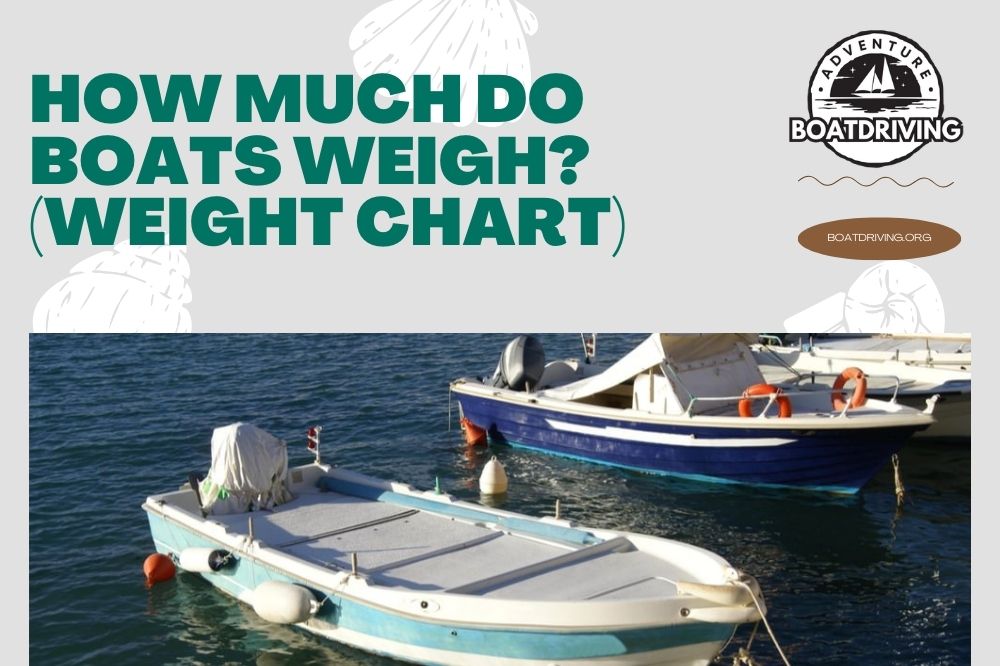
Boating is one of the favorite leisurely activities worldwide. If you can buy a boat , you should do so. However, you need to check a few crucial things before taking such a step. For instance, it is crucial to know how much do boats weigh and the appropriate length that will suit your needs.
This information is not crucial while your vessel is on the water but will help you find a way of transporting your boat. If you want a more sizable vessel model, you may need to change your vehicle because of its towing ability. Plus, its weight will affect the trailer type you need. Let’s see.
Table of Contents
Dry Weight vs. Wet Weight
The most towable boats, vehicle towing capacity.
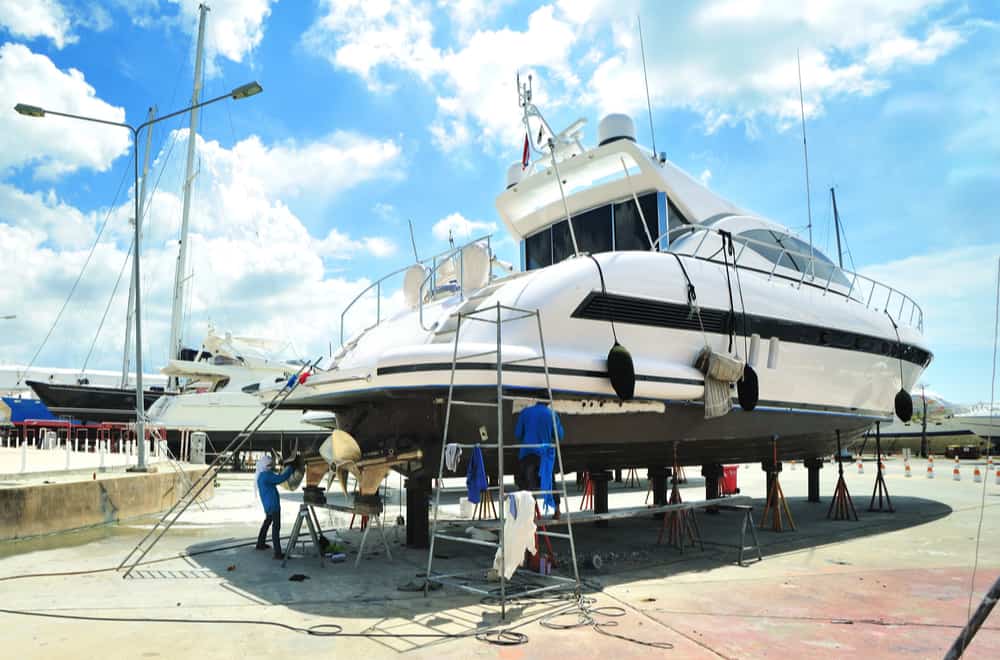
The primary thing before determining how much do boats weigh is to know what does it really mean.
This boat’s dry weight is its mass you can find on the manufacturer’s instructions. It includes only a vessel without an engine, fuel, equipment, passengers, and trailer .
This measure includes the weight of the boat with an engine and fuel. Be careful when determining it since motors are heavy and can carry gallons of gas.
Remember that each gallon (3.8 l) of fuel weighs 6 pounds (2.7 kg). In other words, an average tank with 60 gallons (227 l) capacity will add at least 360 pounds (163 kg) to the boat’s dry weight.
Package weight
This weight type includes a boat with an engine packed with fuel and trailer weight . It is the weight your car needs to tow once you decide to transport the boat. Remember that a trailer size directly depends on your vessel length and weight.
Actual boat weight
It is the weight of your fully-equipped vessel with a trailer . It includes a boat with a fully fuel-filled engine, passengers, and gear, like:
- Fishing gear
When these things add up, they significantly increase the final boat’s weight. Unfortunately, it is impossible to precisely calculate this measurement since the equipment is not standard and depends on your needs and boat type.
However, you can check the weights of gear most people typically carry on their vessels. Then, you can pick out things you plan to load on your boat and make a calculation.
- The trailer is approximately 1,000 to 1,600 pounds (455 – 725 kg) heavy
- Fuel weighs 240 to 450 pounds (110 – 205 kg), depending on the gas tank size
- Tower weighs 70 to 300 pounds (30 – 136 kg)
- Standard gear, like life vests and coolers, can reach 100 to 500 pounds (45.5 – 225 kg)
- Stereo with speakers and amps are about 50 to 250 pounds (22.5 – 115 kg) in weight
- Accessories, including ballast tanks and heater, will add 50 to 450 pounds (22.5 – 205 kg)
As you can see, you will potentially add an extra 1,500 to 2,200 pounds (680 – 1,000 kg) to the dry boat weight. Plus, you also need to calculate the number of people coming to your boat and their average weight.
Even though it is only a rough estimate, you can get an idea of things that impact your vessel’s weight . Plus, you will know what to expect before picking out a vehicle to tow it and determine the load your boat can carry while sailing.
The boat’s weight will directly affect its towing capability. Therefore, you should check all possibilities before choosing the model you want to buy.
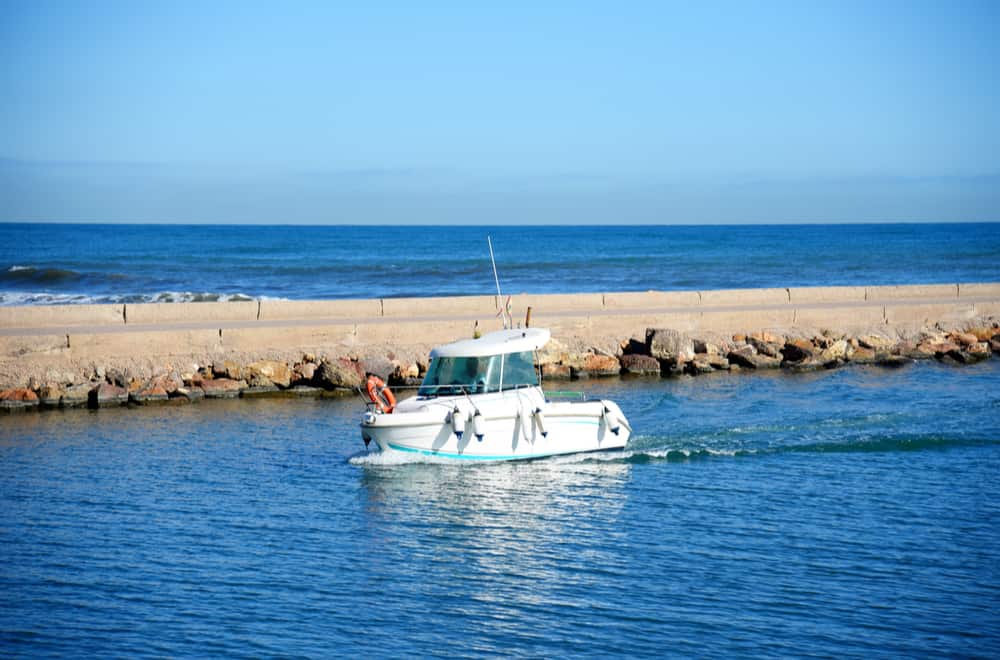
A skiff is a mini, under 20 feet (6 m) long boat suitable for shallow water and tight fishing spots. It is typically 300 to 900 pounds (135 – 410 kg) heavy and comes with a small light motor .
You can move this vessel made of light materials like aluminum or fiberglass with a long pole. It is also practical for towing, and you only need a car or crossover for such an activity.
Fishing boat
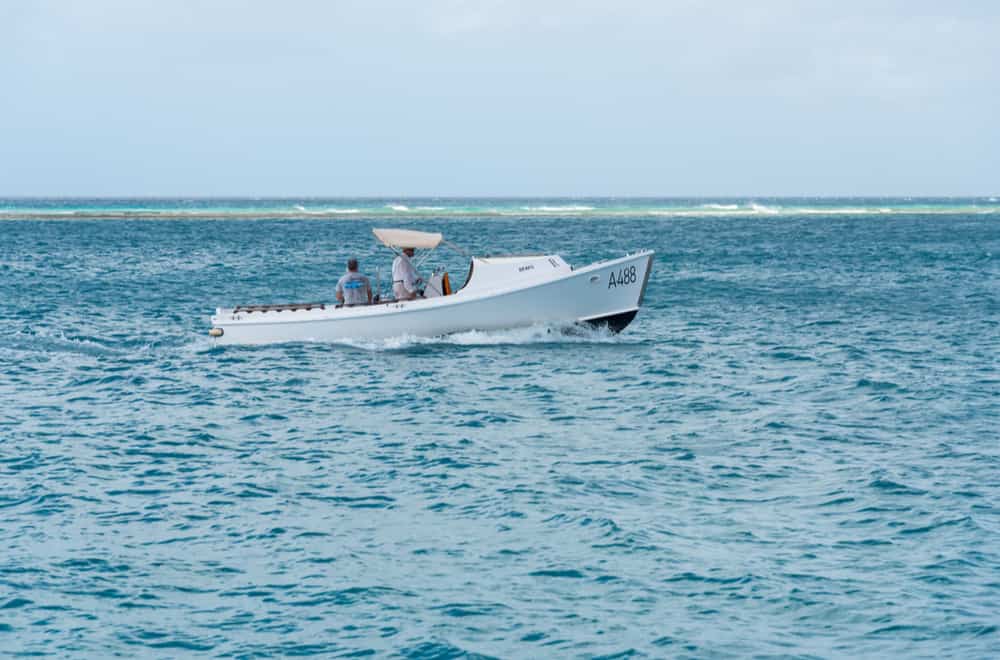
An average fishing boat can weigh 300 to 2,500 pounds (135 – 1,100 kg), depending on the material used for its making. Most people pick out one of the standard models weighing approximately 1,700 pounds (770 kg).
The excellent thing is that you can tow it effortlessly, but the type of vehicle you need directly depends on your vessel type and weight. You can tow smaller models with your car, crossover, or SUV, but you need a truck for towing heavier boats.
Aluminum fishing boat
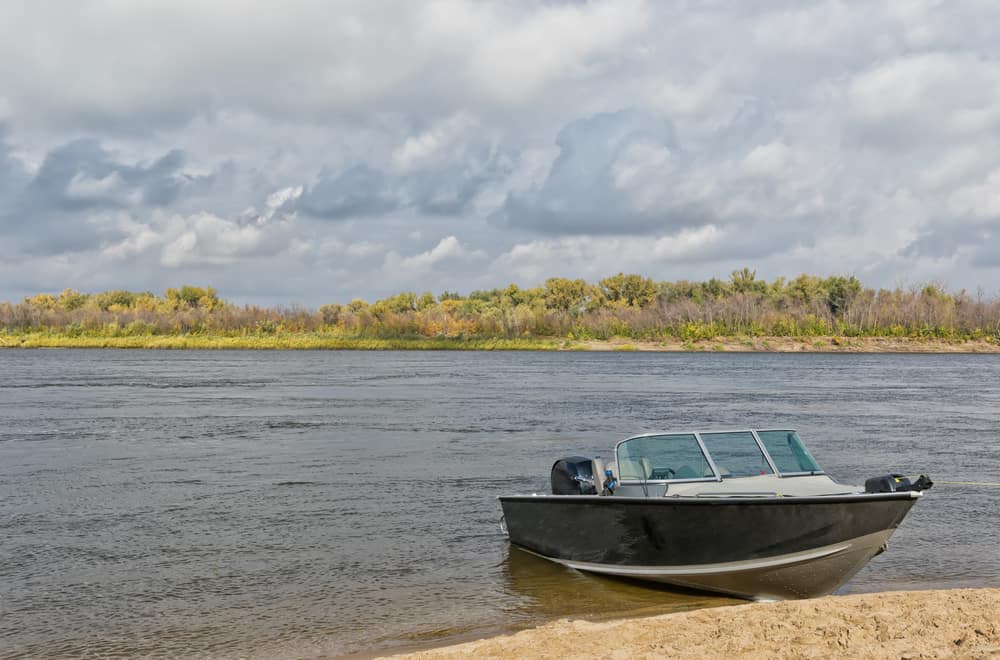
An aluminum fishing boat is 16 feet (4.9 m) long and 300 to 500 pounds (135 – 225kg) heavy on average. It comes with a flat or a deep V bottom and uses a small electric or outboard gas engine . All in all, its weight is almost always under 1,000 pounds (453.5 kg).
If you have a fishing boat with a small motor , that weight will be about 650 pounds (295 kg). A sizable engine increases that value to about 900 pounds (410 kg).
Fiberglass fishing boat
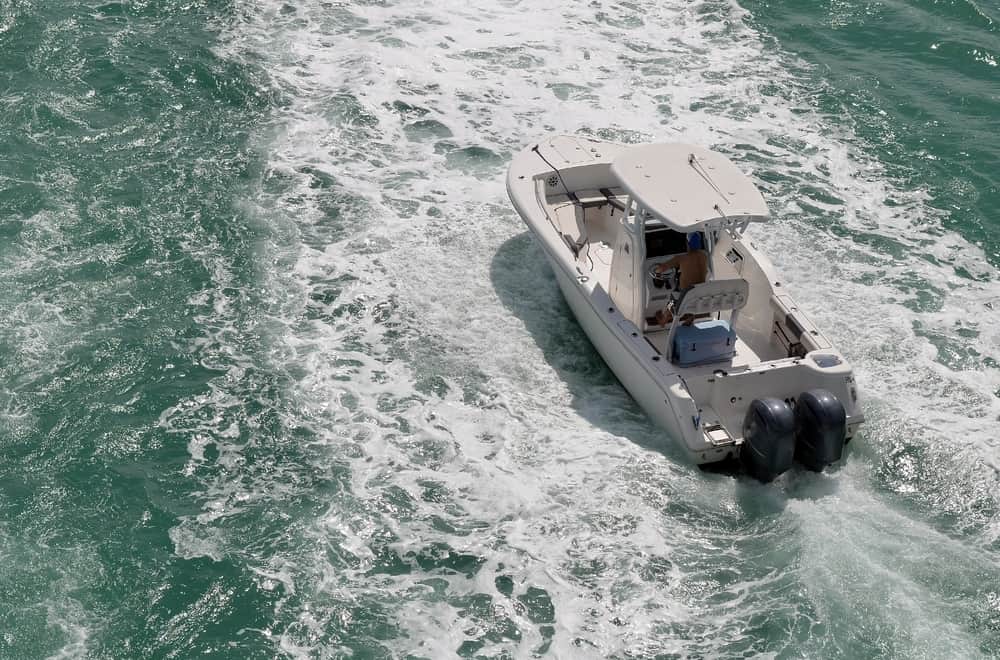
This durable, 16 to 20 feet (4.9 – 6 m) long fishing boat is typically 1,500 to 2,500 pounds (680 – 1,100 kg) heavy. Some sizable models can weigh 2,900 pounds (1,315 kg). You can expect it to reach at least 5,000 pounds (2,270 kg) with an engine and trailer.
Personal watercraft
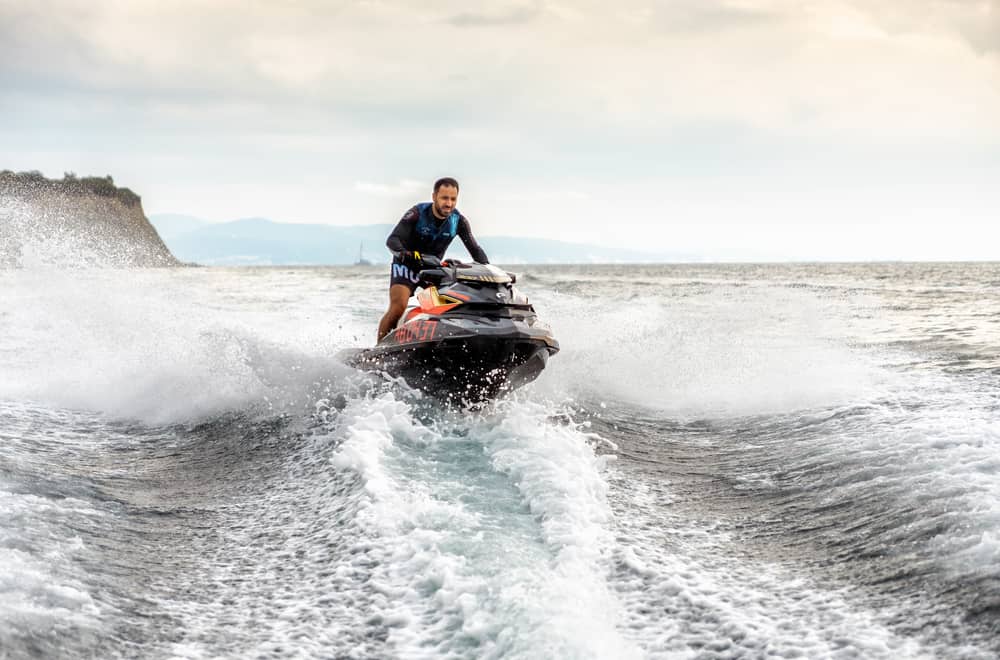
PWC (personal watercraft) is often known as Jet Ski and Wave Runner. It is technically not a boat, but people who enjoy fun water activities consider it a one-person boat. With a weight of only 800 to 850 pounds (363 – 385 kg), it is in a group of lightweight vessels you can carry with a car, SUV, van, or truck.
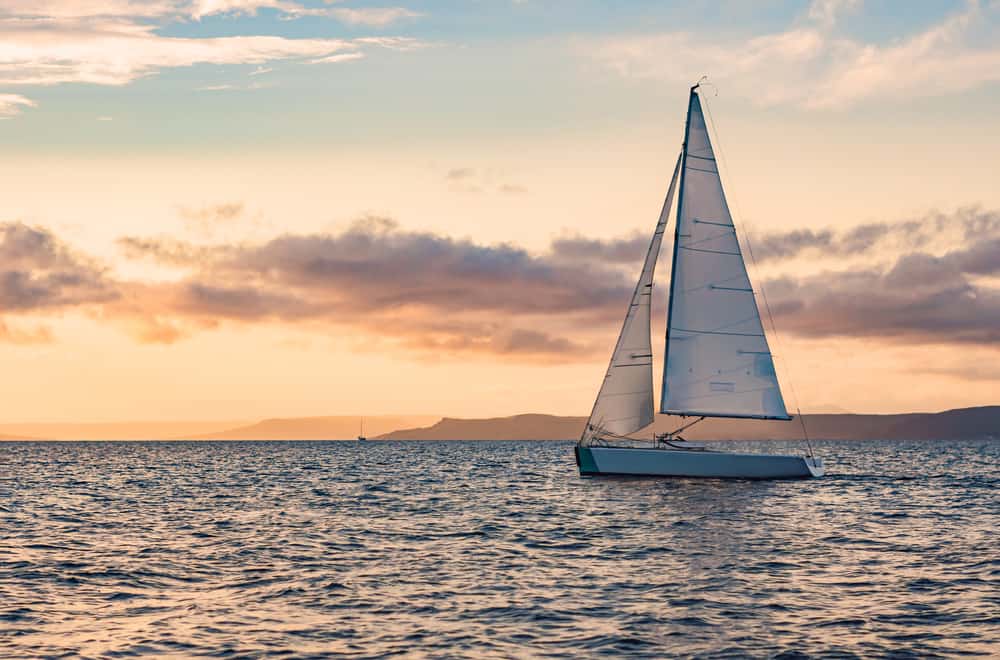
Sailboats are vessels you need to propel by sails. They come in wide weight ranges, and you can find models weighing 120 to 36,000 pounds (54.5 – 16,330 kg).
In other words, it can be tricky to transport if it is hard to tow it. You should have a car or crossover for smaller models, but even trucks can’t tow the most sizable ones weighing over 12,000 pounds (5,443 kg).
You can roughly divide sailboats into two groups, depending on their measures:
14 to 18 feet (4.3 – 5.5 m) long sailboats
So-called day sailboats without onboard overnight accommodation are typically 14 to 18 feet (4 – 5.5 m) long. Most models weigh 400 to 800 pounds (180 – 360 kg) in total. It primarily depends on the material they are made of, including aluminum , fiberglass, or wood .
You can pick out this model to sail on calm waters like lakes and bays. A car and crossover are typically strong enough to tow this boat even long distances.
20 to 30 feet (6 – 9 m) long sailboats
You can use 20 to 30 feet (6 – 9 m) long sailboat for family cruising, but some models include cabins for sleeping. Vessels over that length are considered yachts. The expected weight is 4,000 to 8,800 pounds (1,800 – 4,000 kg), and you can have difficulties carrying your boat even with a truck.
Bowrider boat
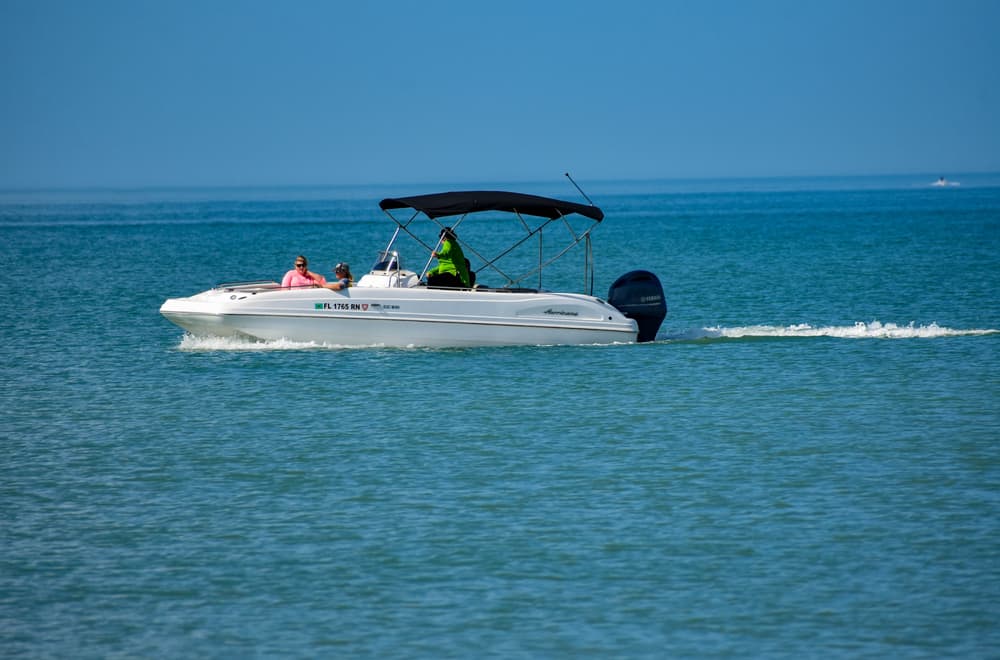
This boat type made of fiberglass is a desirable option for comfortable short cruises. You can find 16 feet to 25 feet (4.9 – 7.6 m) models with an inboard or outboard engine . Their total weight is 3,000 to 3,500 pounds (1,350 – 1,600 kg) on average, so you need an SUV or truck to tow it.
Pontoon boat
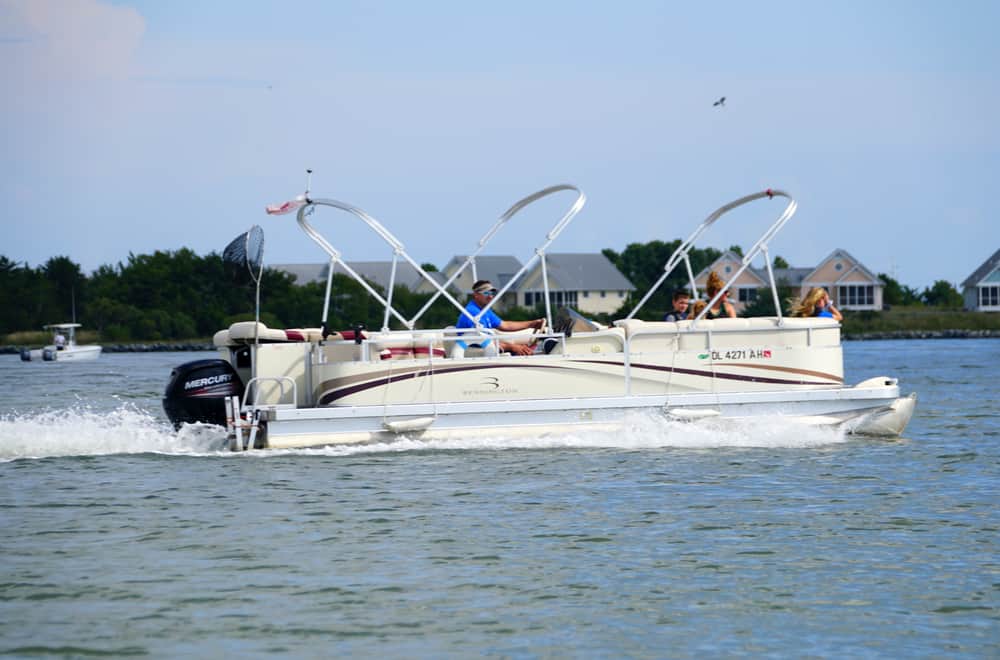
Most pontoon boats with two or even three hulls weigh 3,000 to 5,000 pounds (1,350 – 2,300 kg). As you can guess, only an SUV or truck can tow such a sizable vessel.
Be careful if you have a small SUV since some models can’t deal with such a weight. Pus, always check this boat’s width to prevent possible problems with towing it along the road.
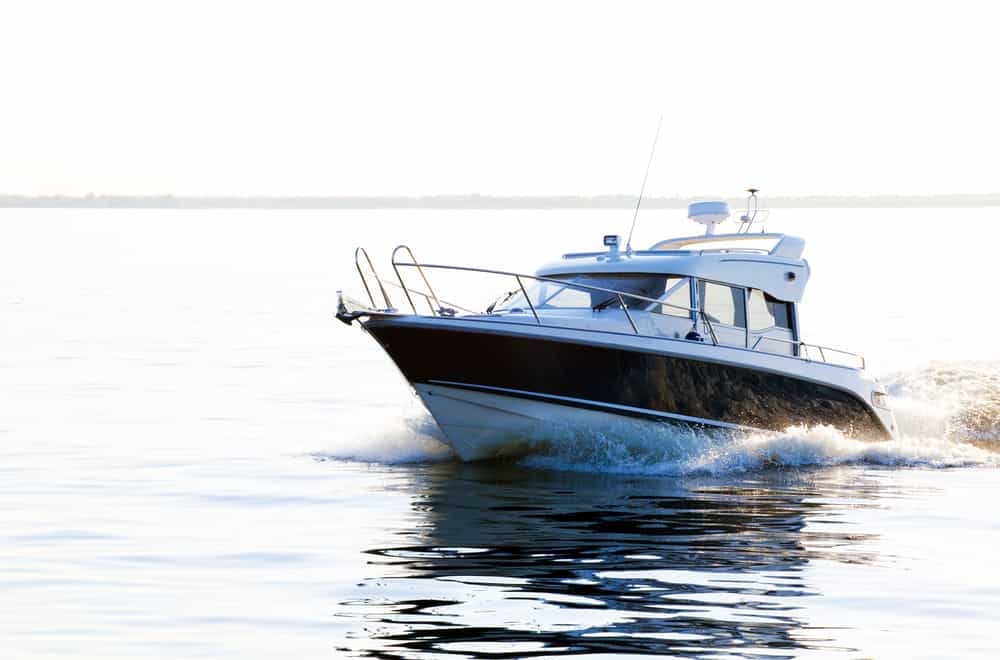
Thanks to enough deck space, a deck boat is an excellent 20 to 30 feet (6 – 9 m) long option for family day cruises. They are similar to pontoon boats but with only one hull. Since most models are 3,000 to 5,000 pounds (1,350 – 2,300 kg) heavy, you will need an SUV or truck for transportation.
Cuddy cabin
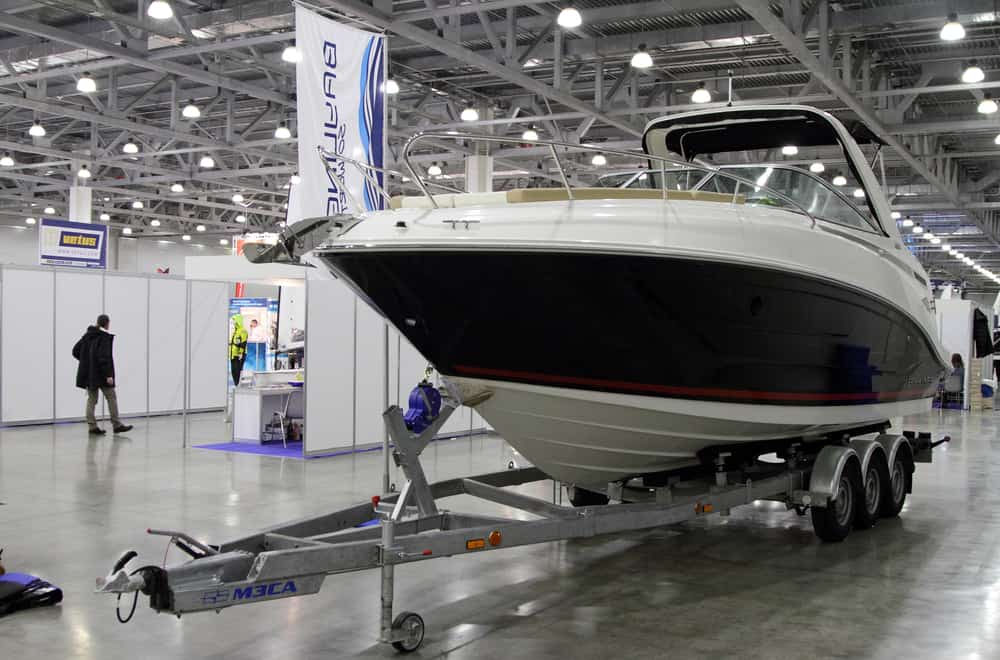
With a small sleeping area and short-term cruising capability, this boat combines a bowrider boat and cabin cruiser. You can find it in the 20 to 30 feet (6 – 9 m) length range.
Its weight is 3,000 to 5,000 pounds (1,350 – 2,300 kg) on average. Considering these measures, you can see that only a sizable SUV and truck are options for towing.
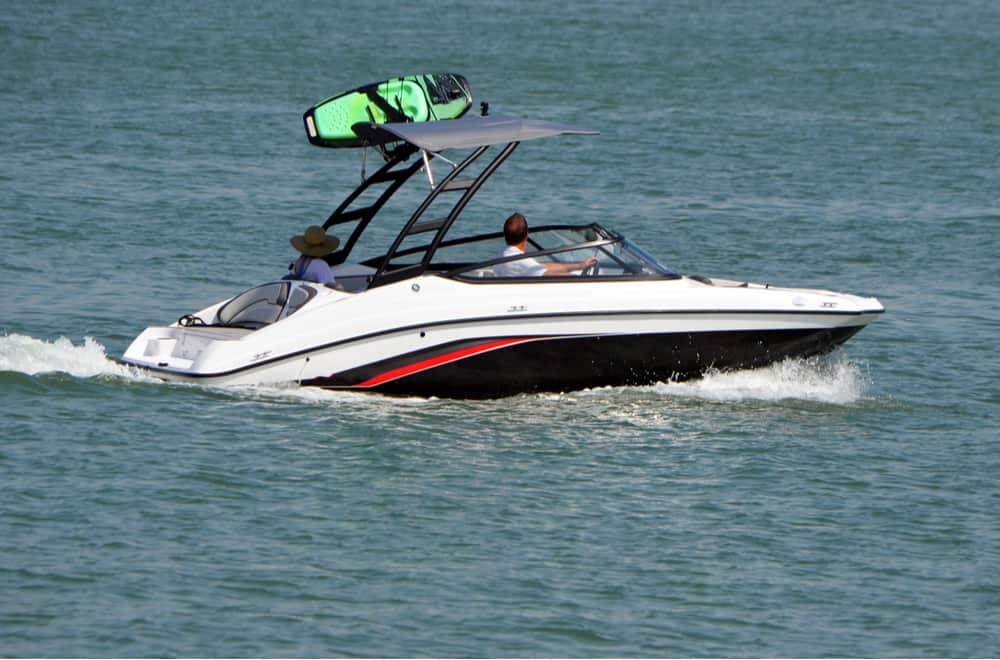
This vessel is an excellent option for watersport enthusiasts and surfers, thanks to its ability to make waves behind the hull. Most models are 20 feet (6 m) long with 3,000 to 5,000 pounds (1,350 – 2,300 kg) of dry weight .
Since you need to add an engine and tailor weight to this number, you will need an SUV or truck for safe transportation.
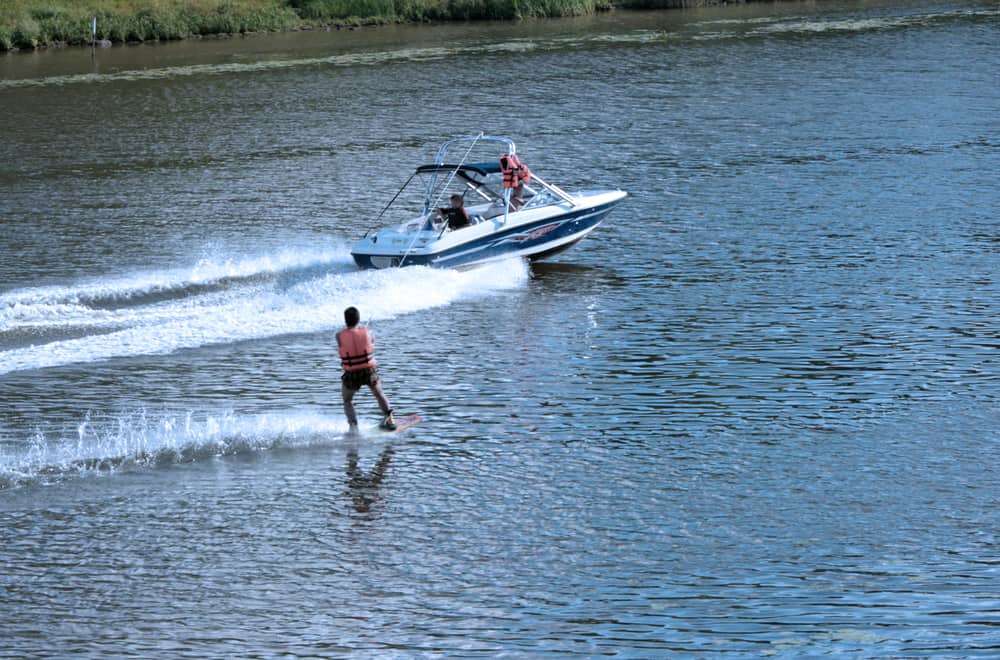
An average ski boat will weigh 3,500 pounds (1,600 kg), but you can find them in a weight range of 2,000 to 6,000 pounds (910 – 2,700 kg).
This vessel model has become highly popular in recent years because of activities you can use it for, like water skiing and wakeboarding . The only way to effortlessly tow this boat is to have a middle-sized SUV or truck.
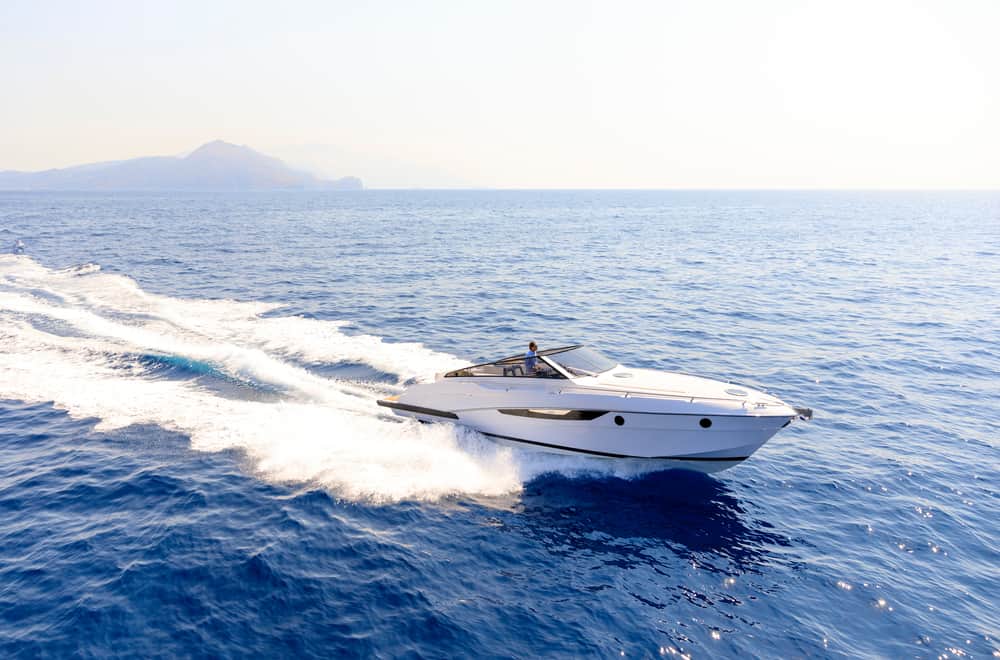
The so-called cigarette boat has a slim and stylish outer design that can vary depending on the model and make. Its purpose is to be fast and provide the thrill of the ride.
This sleek and stylish boat typically comes with an average weight of 8,000 pounds (3,600 kg). However, you can find drastic weight differences because of robust engines.
Even though this vessel is not challenging to tow, you need to have a sizable SUV or truck for this purpose.
Cabin cruiser boat
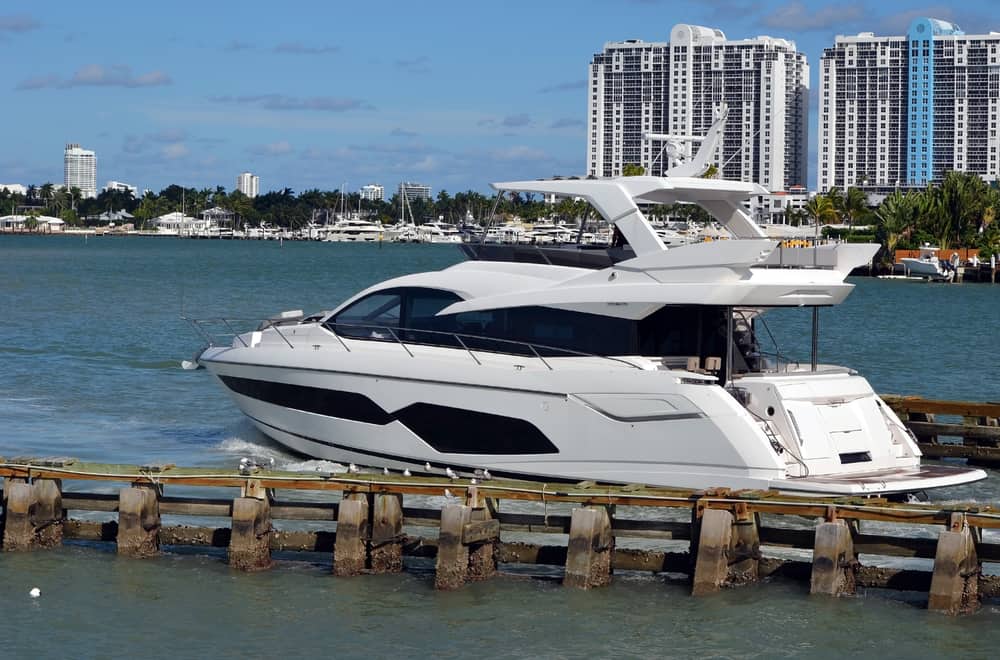
A cabin cruiser is actually a small, 25 to 45 feet (7.6 – 13.7 m) long yacht weighing 9,000 to 16,000 pounds (4,000 – 7,250 kg) on average. It is like a mini portable house you can use on the water with enough inside space for sleeping when necessary.
Keep in mind that the sleeping accommodation size will directly affect its weight. You can consider buying this vessel only if you have an appropriate truck for towing.
Before buying a boat , you need to determine its weight with complete equipment and trailer to determine the vehicle type you need to tow it. If you pair the wrong car with a too heavy boat, you will probably cause irreparable damage and lose money instead of enjoying sailing.
The only option you can make is to think of purchasing an adequate vehicle before considering a heavier boat type.
The boat weight is a vital deciding factor you should keep in your mind before purchasing one. You should check both dry and wet weight to ensure your safety while on the open waters. Plus, this measurement will help you pick out the proper trailer and match it with the vehicle you own.
Related posts:
- 21 Types of Recreational Boat
- 19 Boat Party & Sailing Outfit Ideas
- 8 Best LED Boat Lights of 2023 – Marine Led Lights Reviews
- What Size Boat Do I Need? (Family size Chart)
Leave a Comment Cancel reply
Save my name, email, and website in this browser for the next time I comment.

How Much Does A Sailboat Weigh?

Last Updated by
Daniel Wade
June 15, 2022
While it may seem counterintuitive, there's more than one weight measurement for sailboats. In this article, we'll go over three ways of determining the weight of a sailboat.
Consumer sailboats usually weigh between 120 and 30,000 pounds, with the average sailboat weighing 8,845 pounds. This average sailboat weight is without taking into account additional gear, fuel, people, and more that are on a sailboat out on the water. To accurately weigh a boat isn't as simple as dropping it on a scale. Besides the logistical problems you'd face, it wouldn't give you all the information you need to know.
That's why there are a few types of weight measurement for boats. These are dry weight, displacement, and tonnage. Don't confuse these subtypes; while displacement and dry weight are closely related, tonnage is a different type of measurement.
Table of contents
Dry weight is closely related to displacement, and it’s the number you’d get if you hung an empty boat from a scale. Dry weight isn’t always included on specification sheets, but it’s vital if you intend to tow or transport your boat.
To give you a better idea of the dry weight of different vessels, we’ll use a short list of common boat sizes by LOA (length overall) in feet. Keep in mind, the weight of a boat differs based on hull material , mast type, and many other factors.
- Dinghies (less than 12’): 100 to 200 pounds
- Small Sailboats (15’ to 20’): 400 to 2,500 pounds
- Medium Sailboats (21’ to 25’): 2,500 to 5,000 pounds
- Cruising Sailboats (27’ to 32’): 7,000 to 12,000 pounds
- Large Sailboats (35’ to 40’): 12,000 to 30,000 pounds
What factors contribute to the weight of a sailboat? Hull material makes a huge difference in dry weight. Older wooden cruising vessels with deep keels often weigh thousands of pounds more than an equivalent-sized fiberglass boat. Also, sport and racing sailboats sometimes weigh a fraction of an average consumer cruiser.
A sailboat’s mast and rigging contribute to the weight as well. Solid hardwood masts sometimes weigh hundreds of pounds more than hollow masts, and heavy brass deck equipment adds up. It doesn’t take long for equipment to increase the weight of a boat.
Displacement
How is displacement different than dry weight? First of all, you can only calculate dry weight when a boat is empty and dry. Displacement is equal to the weight of a boat, along with everything (and everyone) aboard at the time of measurement. This includes water, fuel, deck equipment, interior cushions—you get the picture.
The most common measurement of weight for sailboats is displacement, and it reflects the weight of a loaded sailboat in the water. We measure displacement by calculating the weight of the water volume a boat displaces. This unit is vital in boat design. A vessel will sink if it weighs more than the water it displaces.
There’s a simple way of picturing the concept of displacement. Imagine a cup of water filled to the very top. Now drop in a coin and measure the amount of water that spills out. The weight of the spilled liquid is the displacement of the coin.
Oddly, the displacement value of a boat means slightly different things in salt and freshwater. Saltwater weighs 64.1 pounds per cubic foot, while fresh water weighs 62.4 pounds per cubic foot. That means a boat will displace more freshwater because saltwater essentially ‘pushes harder’ upward on the craft.
So, how does displacement translate to weight? You can get a general idea of how ‘heavy’ a boat is using a simple calculation, shown below.
(Displacement/2,240) / (LWL x 0.02)^3
1) First, you’ll need to convert the displacement (in pounds) to long tons . Simply divide the displacement by 2,240 to get your answer. Put this number aside for a moment.
2) Next, find the length at waterline ( LWL ) of your boat, and multiply it by 0.01 . Take this value and raise it to the power of 3 . It should look something like this: (LWL x 0.01) ^3
3) Finally, divide your first number (in long tons) by the result of the previous calculation to get your displacement to length ratio .
The displacement to length ratio is useful for a number of reasons. Using this simple number allows you to determine the weight class of a boat, so you’ll know what it’s suitable for. Below, we put together a list to help you understand the differences using a D/L ratio of 40 to 400.
- Ultra-light (race boats): 40 to 89
- Light (race or trailer-sailboat): 90-179
- Medium (day boat/light cruiser): 180-269
- Heavy ( cruising sailboat /offshore cruiser): 270-359
- Very Heavy (heavy offshore cruiser): 360-400+
Generally speaking, sailboats built before 1950 typically have a heavy D/L ratio. A boat with a ratio over 300 handles much differently than a light vessel, and many consider heavier boats to be more ‘seaworthy.’ Of course, it’s not always that simple, but the general rule still applies. Using what we know about displacement, it’s time to go over our final weight measurement.
Tonnage represents the volume of the enclosed space on a boat, using the same concept as displacement. Salt and freshwater tonnage differ for the same reasons as well. Tonnage and size are directly related, and this unit gives you an idea of how much cargo you can carry before overloading. Cargo tonnage is measured in long tons, similar to displacement. Simply divide the tonnage (in pounds) by 2,240 to get your cargo tonnage value.
Why Weight Matters
While we haven’t mentioned every way of weighing a sailboat, you can gain a lot from understanding dry weight, displacement, and tonnage. For example, you’ll need to know the dry weight of a boat to determine if your vehicle can actually tow it. If a vessel weighs 15,000 pounds, you’ll probably want to avoid it unless you have a permanent mooring or a heavy-duty pickup truck.
Displacement and dry weight are closely related. Displacement is equally crucial for determining a boat’s capabilities. Heavy, deep-keel sailboats generally handle well in rough seas, but you probably won’t be racing with a high D/L ratio. If you understand what your intentions for a boat, it’s imperative to comprehend displacement and D/L ratio.
Tonnage is essential to understand, especially for offshore cruising. Using this value, you can calculate how much food, water, supplies, and how many people you can take aboard. Ignoring any of these values can spell disaster for any captain but understanding sailboat weight ahead of time ensures you’ll know what you’re doing.
Now that you have a grasp of sailboat weight measurements, it’s time for some real-world examples. We found the specifications of three common sailboats so you can get an idea of what to expect.
How Much Does A Catalina 30 Weigh?
This 30-foot sloop is one of the most successful production fiberglass sailboats in history. It was built by Catalina Yachts between 1972 and 2008, with over 6,000 units. We chose the Catalina 30 because it’s an ideal example of a medium-sized all-purpose cruising sailboat . This versatile sloop is well suited for coastal cruising and some offshore passages.
Dry weight clocks in at 10,200 pounds, with a D/L ratio of 291.43. This sailboat is an ideal general-purpose cruising vessel.
How Much Does An O’Day 25 Weigh?
Despite being only a few feet shorter than the Catalina 30, the O’Day 25 is a much different boat. This popular day cruiser has a displacement of only 4,007 pounds, which is less than half of the Catalina 30. The O’Day 25 falls into the medium weight category with a D/L ratio of only 193.16. Comparatively, you can immediately see how these two common fiberglass boats differ. The O’Day 25 will be much easier to tow, yet less suitable for long offshore passages.
How Much Does An Atkin ‘Eric’ 32 Weigh?
This 32-foot wooden sailboat was designed decades ago for offshore sailing. While dimensionally similar to the Catalina 30, this boat is significantly heftier with a displacement of 19,500 pounds. Despite only being 2-feet longer than our Catalina at the waterline, the Atkin Eric has a D/L ratio of 418.81 making it an extremely heavy boat!
From a distance, all three of our examples would look similar in size and above-water characteristics. Below the surface, we find something very different. Each of these vessels is suitable for different things, and how much they weigh plays a vital role in their uses. Now that you know how to interpret the weight of a sailboat, you’ll be prepared to choose one that best fits your needs.
Related Articles
I've personally had thousands of questions about sailing and sailboats over the years. As I learn and experience sailing, and the community, I share the answers that work and make sense to me, here on Life of Sailing.
by this author
Learn About Sailboats
Most Recent

What Does "Sailing By The Lee" Mean?
October 3, 2023

The Best Sailing Schools And Programs: Reviews & Ratings
September 26, 2023
Important Legal Info
Lifeofsailing.com is a participant in the Amazon Services LLC Associates Program, an affiliate advertising program designed to provide a means for sites to earn advertising fees by advertising and linking to Amazon. This site also participates in other affiliate programs and is compensated for referring traffic and business to these companies.
Similar Posts

Affordable Sailboats You Can Build at Home
September 13, 2023

Best Small Sailboat Ornaments
September 12, 2023

Discover the Magic of Hydrofoil Sailboats
December 11, 2023
Popular Posts

Best Liveaboard Catamaran Sailboats
December 28, 2023

Can a Novice Sail Around the World?
Elizabeth O'Malley

4 Best Electric Outboard Motors

How Long Did It Take The Vikings To Sail To England?

10 Best Sailboat Brands (And Why)
December 20, 2023

7 Best Places To Liveaboard A Sailboat
Get the best sailing content.
Top Rated Posts
Lifeofsailing.com is a participant in the Amazon Services LLC Associates Program, an affiliate advertising program designed to provide a means for sites to earn advertising fees by advertising and linking to Amazon. This site also participates in other affiliate programs and is compensated for referring traffic and business to these companies. (866) 342-SAIL
© 2024 Life of Sailing Email: [email protected] Address: 11816 Inwood Rd #3024 Dallas, TX 75244 Disclaimer Privacy Policy
How Much Does a Boat Weigh? A Guide with Factors to Measure
Boats have always captivated human imagination, from ancient voyages of discovery to leisurely cruises on serene waters. Their elegance, versatility, and ability to take us to new horizons make them objects of fascination.
But have you ever wondered how much a boat weighs? Delving into a boat’s weight can unveil a world of insights, from performance and fuel efficiency to transportation and storage considerations.
In this comprehensive guide, we will explore the importance of knowing a boat’s weight and delve into the factors that influence it. Join us on this journey as we uncover the mysteries of boat weight and its implications.
By the end of this guide, you’ll have a solid understanding of why boat weight matters and how it impacts various aspects of boating. So, let’s set sail and discover the weighty secrets of boats!
Understanding Boat Weight
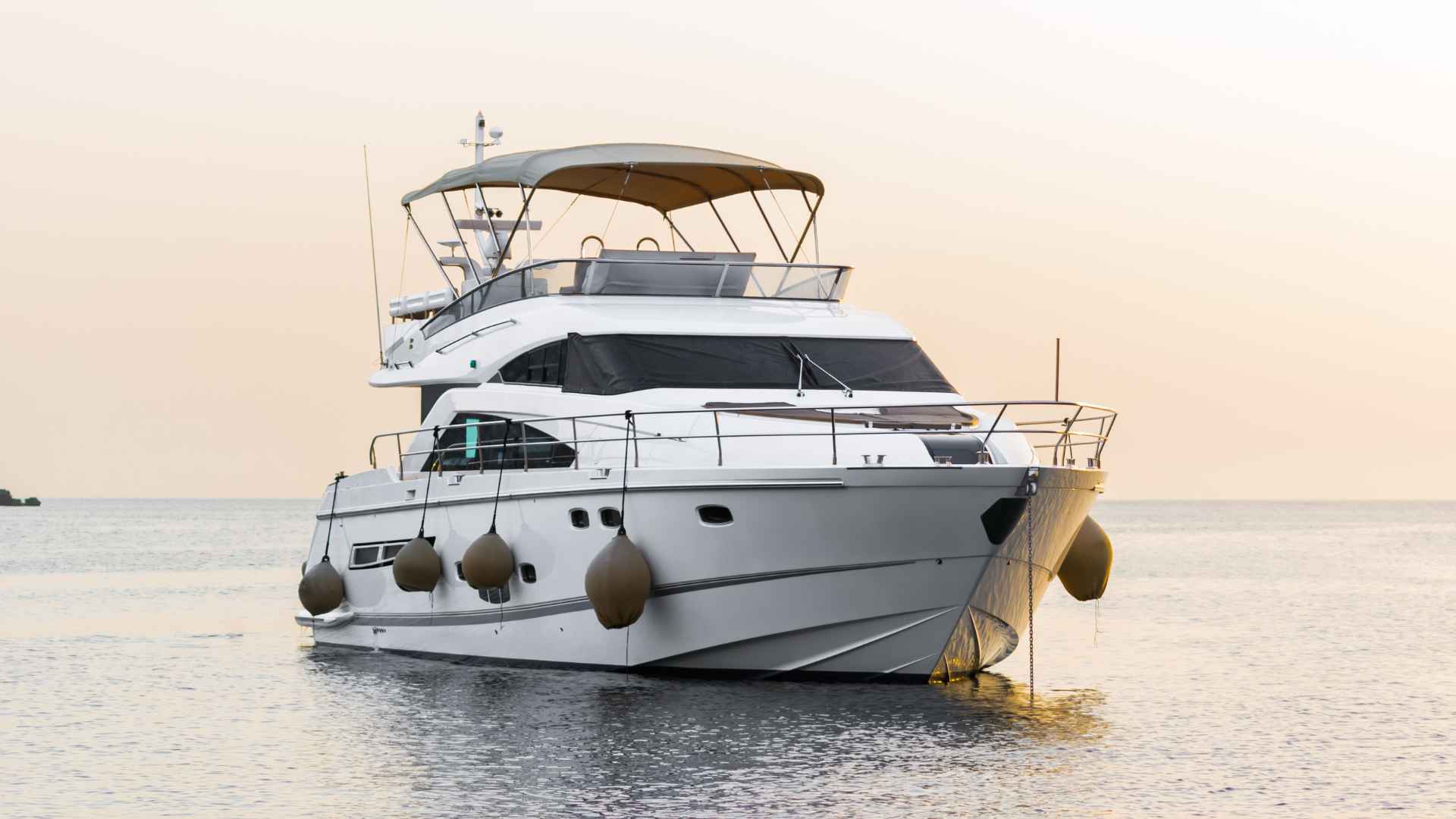
Boat weight refers to the total mass of a boat, including its structure, equipment, and any additional features. It plays a crucial role in determining a boat’s performance, fuel efficiency, and maneuverability. Understanding boat weight is essential for several reasons, such as:
Significance of boat weight:
Boat weight affects various aspects of boating, including safety, stability, speed, and handling. It influences how the boat interacts with water and how it responds to external forces like wind and waves. By knowing a boat’s weight, boaters can make informed decisions about equipment, passengers, and cargo capacity to ensure optimal performance.
Different components contributing to a boat’s overall weight:
Several components contribute to a boat’s overall weight. These include:
- Hull Material: Different hull materials, such as fiberglass, aluminum, wood, or composite materials, have varying weights. For example, fiberglass tends to be lighter than wood, while aluminum combines strength with relatively low weight.
- Engine(s), Fuel Tanks, and Mechanical Systems: The engines, fuel tanks, and other mechanical systems on board contribute significantly to the boat’s weight. Larger engines or additional fuel capacity can increase the overall weight.
- Interior Amenities: Cabins, bathrooms, kitchens, and other interior amenities add weight to a boat. Luxurious features and larger living spaces can significantly impact the overall weight.
- Onboard Equipment: Anchors, winches, navigation systems, communication equipment, and safety gear all add to the boat’s weight. The choice of equipment and its quality can influence the weight.
- Additional Features: Swim platforms, fishing gear, water toys, and other optional features contribute to the boat’s weight. These accessories enhance the boating experience but should be considered in terms of the added weight.
How boat weight affects performance, fuel efficiency, and maneuverability?
Boat weight directly influences performance factors such as speed, acceleration, and maneuverability. A heavier boat may have reduced speed and slower acceleration, requiring more power to reach desired velocities. Additionally, increased weight can affect the boat’s ability to turn, navigate tight spaces, or respond quickly to helm commands.
- Impact on Fuel Efficiency: Boat weight is closely tied to fuel efficiency. Heavier boats require more energy to propel through the water, leading to increased fuel consumption. Understanding the boat’s weight helps boaters estimate fuel requirements accurately, plan for longer trips, and optimize their fuel usage.
- Influence on Maneuverability and Handling: Boat weight affects how the vessel handles various water conditions. A heavier boat may have a higher resistance to wind and waves, making it more challenging to navigate in rough conditions. Lighter boats tend to be more responsive and agile, providing better maneuverability and ease of handling.
By comprehending the significance of boat weight and considering its various components, boaters can make informed decisions about their vessel’s performance, fuel efficiency, and maneuverability. In the next section, we will explore the weight ranges associated with different types of boats and how they can vary based on construction and purpose.
Different Types of Boats and Their Weight Ranges

Boats come in various types, each designed for different purposes and activities. Let’s explore some common types of boats and their typical weight ranges:
1. Sailboats:
Sailboats are propelled by the wind and typically have a lighter weight compared to powerboats. Their weight ranges can vary depending on the size, construction, and intended use. Small day-sailing sailboats can weigh anywhere from 500 to 5,000 pounds (227 to 2,268 kilograms), while larger cruising sailboats can range from 10,000 to 60,000 pounds (4,536 to 27,216 kilograms) or more.
Example: The popular Catalina 22, a small cruising sailboat, weighs around 2,500 pounds (1,134 kilograms), whereas the larger Beneteau Oceanis 45, a cruising sailboat, has an approximate weight of 23,000 pounds (10,433 kilograms).
2. Powerboats:
Powerboats are designed for speed, versatility, and various water activities. They can range from small recreational boats to large yachts. The weight of powerboats can vary significantly depending on their size, hull construction, and the number of engines. Smaller powerboats may weigh around 1,000 to 5,000 pounds (454 to 2,268 kilograms), while larger offshore powerboats can exceed 30,000 pounds (13,608 kilograms) or more.
Example: A popular small recreational powerboat like the Boston Whaler 170 Montauk weighs around 2,200 pounds (997 kilograms), while a larger offshore powerboat like the Formula 370 Super Sport can have an approximate weight of 16,500 pounds (7,484 kilograms).
3. Pontoon Boats:
Pontoon boats are known for their stability and spacious deck areas, making them popular for leisure activities and entertaining. The weight of pontoon boats can vary based on their size, construction materials, and additional features. Smaller pontoon boats may weigh around 1,500 to 2,500 pounds (680 to 1,134 kilograms), while larger and more luxurious models can range from 3,000 to 6,000 pounds (1,361 to 2,722 kilograms) or more.
Example: The Bennington 20 SLX, a smaller pontoon boat, weighs approximately 1,800 pounds (816 kilograms). On the other hand, the Harris Crowne SL 270, a larger and more luxurious pontoon boat, has an approximate weight of 4,600 pounds (2,087 kilograms).
4. Fishing Boats:
Fishing boats are designed specifically for angling and can vary widely in size and weight depending on their intended use. Smaller fishing boats, such as aluminum jon boats, can weigh around 500 to 1,500 pounds (227 to 680 kilograms). Larger offshore fishing boats, like center console or sportfishing boats, can weigh anywhere from 5,000 to 20,000 pounds (2,268 to 9,072 kilograms) or more.
Example: A popular small fishing boat like the Tracker Pro Team 175 TF weighs around 1,000 pounds (454 kilograms), while a larger offshore fishing boat like the Grady-White Canyon 456 can have an approximate weight of 38,000 pounds (17,237 kilograms).
The weight of a boat is influenced by several factors, including size, purpose, and construction materials. Larger boats tend to be heavier due to their increased dimensions and the need for additional structural support.
Purpose-built boats, such as offshore fishing boats, may have added reinforcements or equipment that contribute to their weight. Additionally, the choice of construction materials, such as fiberglass, aluminum, or wood, can impact a boat’s weight. Lightweight materials like fiberglass and advanced composites offer strength while keeping the weight down, while heavier materials like wood may add more mass.
Understanding the typical weight ranges for different types of boats helps boaters gauge their transportation needs, equipment requirements, and the necessary infrastructure to support the vessel. In the next section, we will explore the factors that can affect a boat’s weight beyond its initial construction.
What Are the Factors Affecting Boat Weight?
Boat weight is not a static characteristic and can be influenced by various factors beyond its initial construction. Let’s explore two significant factors that can affect a boat’s weight: weather and climate conditions, as well as customization and modifications.
1. Weather and Climate Conditions:
Boat weight can change due to exposure to different weather and climate conditions. Here’s how:
- Moisture Absorption: Boats that spend extended periods in the water may absorb moisture, especially if they have wood or certain types of fiberglass construction. Moisture absorption can lead to weight gain over time. It is crucial to regularly inspect and maintain the boat’s hull and address any signs of water infiltration to prevent weight fluctuations.
- Snow and Ice: Boats stored in regions with cold climates may accumulate snow or ice on their decks and structures during winter. The weight of accumulated snow and ice can significantly increase the overall weight of the boat, potentially exceeding its weight-bearing capacity. Proper removal of snow and ice buildup is essential to avoid structural damage or instability.
- Importance of Proper Maintenance: Regular maintenance is crucial to prevent weight fluctuations caused by weather and climate conditions. Implementing practices such as hull cleaning, drying out the boat thoroughly after use, and applying protective coatings can help mitigate moisture absorption and prevent unnecessary weight gain.
2. Customization and Modifications:
Boat owners often personalize their vessels by adding custom features or making modifications. While these alterations can enhance functionality and comfort, they can also impact a boat’s weight. Here are a few considerations:
- Personal Additions: Installing additional equipment, amenities, or accessories can increase a boat’s weight. Examples include added seating, sound systems, refrigeration units, or fishing equipment. It is essential to consider the cumulative weight of these additions and ensure that the boat remains stable and within its weight limits.
- Weight Distribution and Stability: When making changes to a boat’s weight distribution, it is crucial to consider stability. Altering weight distribution by adding heavy equipment or amenities in specific areas can affect a boat’s balance and handling characteristics. Maintaining proper weight distribution is essential for safe operation and optimal performance.
- Consulting Professionals: When planning significant modifications to a boat, it is advisable to consult with marine professionals, such as naval architects or boat manufacturers. They can provide guidance on weight implications, structural integrity, and stability considerations to ensure that modifications are carried out safely and effectively.
By being mindful of the potential weight fluctuations caused by weather and climate conditions and considering the impact of customization and modifications, boat owners can maintain the integrity of their vessels. This awareness contributes to both the safety and longevity of the boat. In the next section, we will explore methods to measure and estimate a boat’s weight accurately.
Measuring and Estimating Boat Weight

Accurately measuring a boat’s weight is essential for various reasons, including transportation logistics, determining load capacities, and ensuring safe operation. Let’s explore different methods for measuring a boat’s weight and provide tips for estimating weight when direct measurement is not possible.
Different methods to measure a boat’s weight:
- Trailer Scales: Many marinas or boatyards have trailer scales that can be used to weigh a boat while it is on its trailer. These scales provide a convenient and accurate method to measure the boat’s weight.
- Specialized Boat Lift Systems: Some marinas and boatyards have specialized boat lift systems that can accurately measure the weight of a boat while it is suspended in the air. These systems often incorporate load cells or hydraulic systems to determine the boat’s weight.
- Manufacturer Specifications: Boat manufacturers typically provide specifications that include the boat’s weight. These specifications can be found in owner’s manuals or on the manufacturer’s website. It is important to note that the specified weight may vary depending on the boat’s configuration and optional features.
Importance of accuracy and professional assistance for precise measurements.
When measuring a boat’s weight, accuracy is paramount. Even a small discrepancy in weight estimation can have significant consequences for transportation, stability, and safety. If precise measurements are crucial, it is advisable to seek professional assistance from marina operators, boatyards, or professionals experienced in weighing boats accurately.
Few tips for estimating boat weight:
In cases where direct measurement is not possible, there are alternative methods to estimate a boat’s weight:
- Researching Manufacturer Specifications and Model Information: Referencing the manufacturer’s specifications and model information can provide a general idea of the boat’s weight. Keep in mind that these figures are often approximate and may vary based on optional features and equipment.
- Consulting Boat Owners’ Forums or Industry Experts: Online forums or communities of boat owners can be a valuable resource for estimating boat weight. Experienced boat owners may have firsthand knowledge or similar boat models and can provide insights into weight ranges.
- Using Boat Weight Calculators: Several online tools and boat weight calculators are available that take into account the boat’s size, construction materials, and equipment. These calculators provide estimates based on common industry standards and can be helpful for rough weight approximations.
Remember that weight estimations are not as accurate as direct measurements, so it is important to exercise caution and consider a margin of error when relying on estimates. When precise weight measurements are essential, it is always best to consult professionals or use reliable weighing methods.
In the next section, we will explore the implications of boat weight, including transportation and storage considerations, as well as its impact on maintenance and upkeep.
Implications of Boat Weight
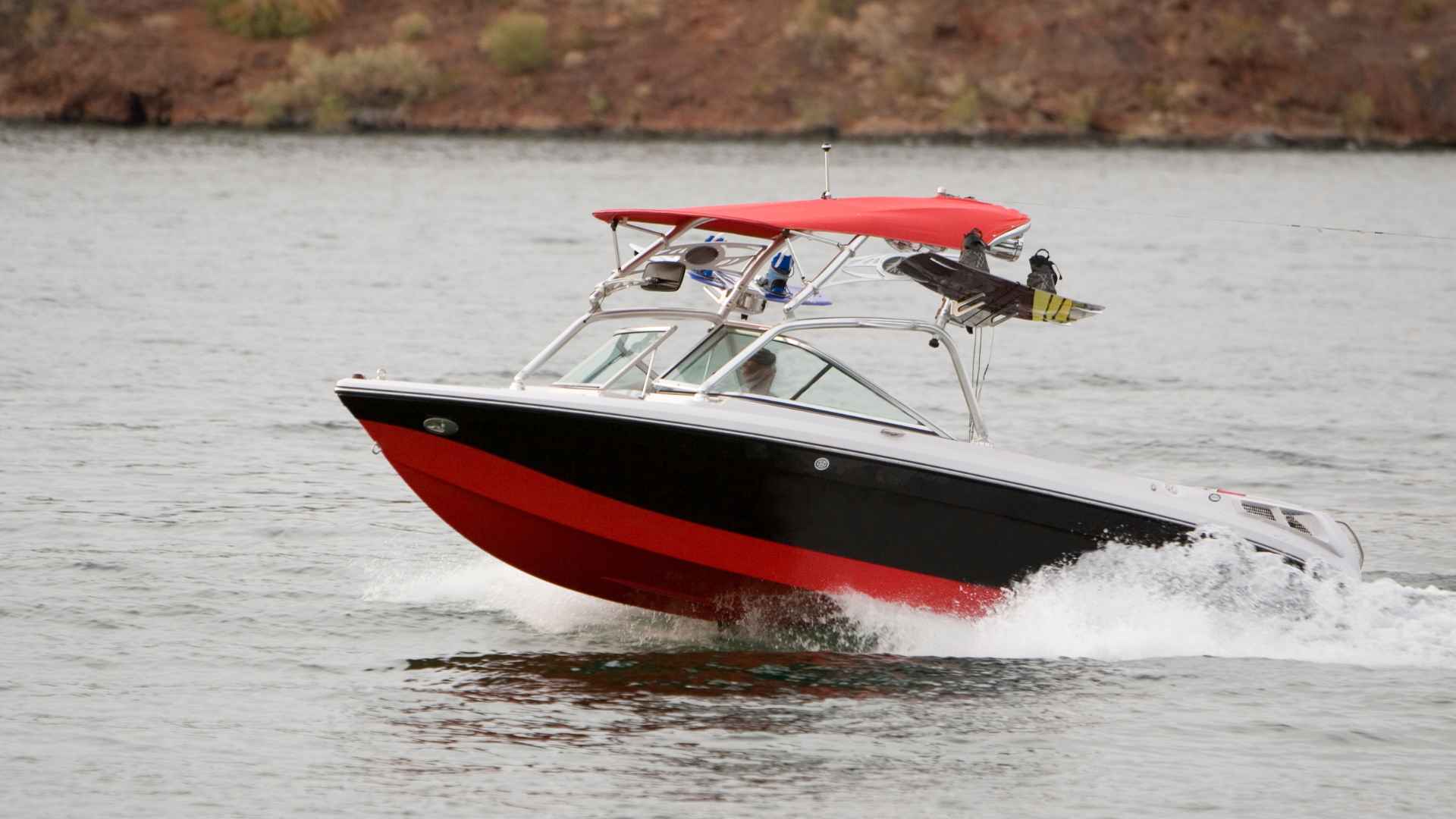
Boat weight has significant implications for both transportation and storage, as well as maintenance and upkeep. Let’s explore these implications in detail:
The impact of boat weight on transportation and storage:
- Trailer Weight Restrictions and Towing Capacity: Boat weight plays a crucial role in determining whether a trailer and towing vehicle can safely handle the load. It is essential to adhere to trailer weight restrictions and ensure that the towing vehicle has the necessary towing capacity to handle the boat’s weight. Exceeding these limits can compromise safety and result in accidents or damage.
- Docking Limitations and Requirements: Heavier boats may have specific docking requirements, such as deeper water or sturdier docking infrastructure. It is important to consider the boat’s weight when selecting a suitable docking location to ensure that it can safely and securely accommodate the vessel.
- Proper Boat Lifting and Launching Procedures: When lifting and launching a boat, its weight determines the type of lifting equipment required and the specific procedures to follow. It is crucial to use proper lifting methods and equipment that can handle the boat’s weight without causing damage or compromising safety.
- Storage Considerations and Weight-Bearing Capacity: Boat weight impacts storage options and considerations. Whether storing the boat on land or in the water, it is important to ensure that the storage facility or infrastructure can bear the weight of the vessel. Weight-bearing capacity should be considered to avoid structural damage or instability.
Significance of boat weight in terms of maintenance and upkeep:
- Antifouling Treatments and Hull Cleaning: Boat weight influences the growth of marine organisms on the hull , known as fouling. A heavier boat may experience faster fouling, leading to decreased performance and increased fuel consumption. Regular antifouling treatments and hull cleaning are necessary to maintain optimal performance and fuel efficiency.
- Engine and Mechanical System Maintenance: Heavier boats may put more strain on engines and mechanical systems. Regular maintenance, including oil changes, filter replacements, and inspections, becomes crucial to ensure that the engine and systems operate efficiently and reliably.
- Regular Inspections and Repairs: The weight of a boat can exacerbate wear and tear on various components. Regular inspections and repairs are necessary to identify and address any issues promptly. This includes checking for structural integrity, electrical systems, plumbing, and other critical components.
- Fuel Consumption and Efficiency: Boat weight directly impacts fuel consumption and efficiency. Heavier boats require more power to propel through the water, resulting in increased fuel consumption. It is important to consider the boat’s weight when planning trips and estimating fuel requirements.
Understanding the implications of boat weight allows boaters to make informed decisions regarding transportation, storage, and maintenance. By considering these factors, boaters can ensure safe and efficient operation of their vessels. In the concluding section, we will summarize the key points discussed and encourage further exploration of boat weight-related topics.
Watch Understanding Your Capacity Plate | Video
Top 5 FAQs and answers related to how much does a boat weigh
How much does an average boat weigh .
The weight of an average boat can vary significantly depending on its type, size, construction, and features. Small boats can weigh around 500 to 5,000 pounds (227 to 2,268 kilograms), while larger boats can range from 10,000 to 60,000 pounds (4,536 to 27,216 kilograms) or more.
How can I determine the weight of my boat?
There are several methods to determine a boat’s weight. You can use trailer scales, specialized boat lift systems, or refer to manufacturer specifications. Trailer scales and boat lift systems provide accurate measurements, while manufacturer specifications give approximate weights. For precise measurements, professional assistance or specialized equipment may be required.
Why is it important to know the weight of a boat?
Knowing a boat’s weight is crucial for various reasons. It helps ensure safe transportation, enables proper storage planning, and allows you to assess load capacities. Additionally, understanding the boat’s weight aids in determining performance, fuel efficiency, and maneuverability characteristics.
Can a boat’s weight change over time?
Yes, a boat’s weight can change over time due to factors like moisture absorption, additions of equipment or amenities, or modifications. Moisture absorption can lead to weight gain, while customization or modifications can increase the overall weight. Proper maintenance and regular inspections help prevent excessive weight fluctuations.
How can I estimate the weight of a boat if I don’t have access to direct measurement?
If direct measurement is not possible, you can estimate the boat’s weight by researching manufacturer specifications and model information. Boat owners’ forums and industry experts can provide insights into weight ranges. Additionally, there are online boat weight calculators that consider size, construction materials, and equipment to provide approximate weight estimates.
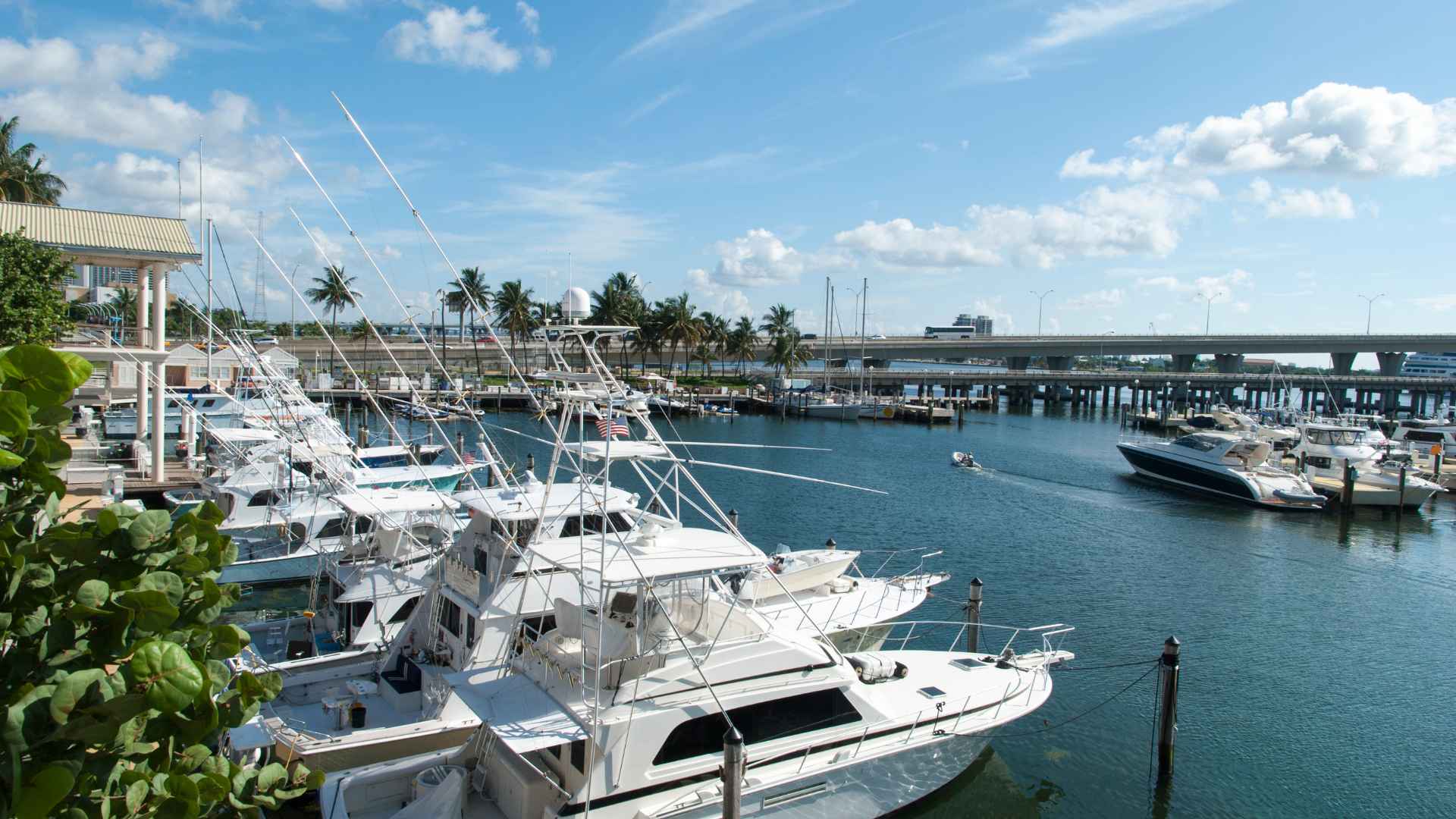
Throughout this comprehensive guide, we have explored the topic of boat weight and its significance. Let’s summarize the key points discussed:
- Boat weight encompasses the total mass of the boat, including its structure, equipment, and additional features. It plays a crucial role in performance, fuel efficiency, maneuverability, transportation, and storage considerations.
- Different components contribute to a boat’s weight, such as the hull material, engines, fuel tanks, interior amenities, onboard equipment, and additional features. Boat size, purpose, and construction materials influence its weight.
- Weather and climate conditions can affect a boat’s weight due to moisture absorption, snow, or ice. Proper maintenance is essential to prevent weight fluctuations caused by these factors.
- Customizations and modifications impact a boat’s weight. Weight distribution and stability should be considered when making changes to ensure safe and optimal operation.
- Measuring a boat’s weight can be done through trailer scales, specialized boat lift systems, or manufacturer specifications. Accuracy and professional assistance are crucial for precise measurements.
- If direct measurement is not possible, estimating a boat’s weight can be done through researching manufacturer specifications, consulting boat owners’ forums or industry experts, and using boat weight calculators based on size, construction materials, and equipment.
Understanding a boat’s weight is vital for various reasons, including safety, performance, fuel efficiency, transportation logistics, and maintenance planning. By being aware of the boat’s weight, boaters can make informed decisions and ensure the proper functioning and longevity of their vessels.
We encourage readers to explore further resources, such as manufacturer documentation, boating forums, and professional advice. There is a wealth of knowledge available to enhance your understanding of boat weight and its implications. If you have any questions or experiences to share, we invite you to join the conversation and engage with fellow boating enthusiasts.
So, set sail with confidence, armed with the knowledge of boat weight and its impact on your boating adventures!
Share How Much Does a Boat Weigh? A Guide with Factors to Measure with your friends and Leave a comment below with your thoughts.
Read Do Outboard Motors Have Alternators and Charge Batteries? until we meet in the next article.
Similar Posts
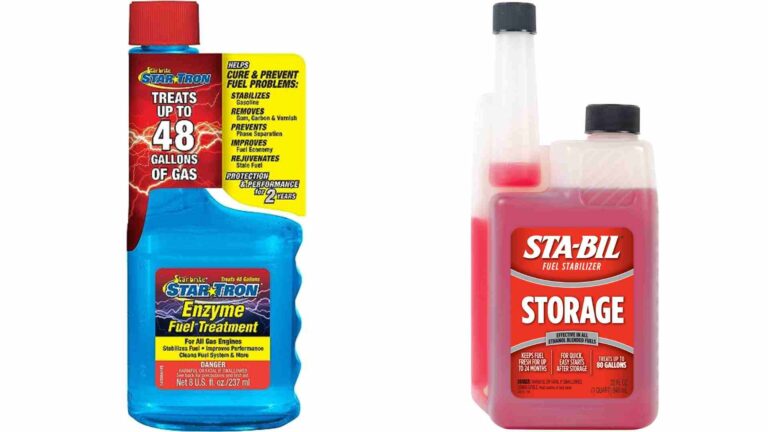
Star Tron vs. Sta-Bil Fuel Stabilizer: Detailed Comparison
Fuel stabilizers are essential for boat owners who want to prevent fuel-related issues during storage or periods of infrequent use. However, choosing the right fuel stabilizer can be confusing with so many options available. Two of the most popular brands are Star Tron and Sta-Bil, both boasting powerful benefits. Let’s delve into a detailed comparison…
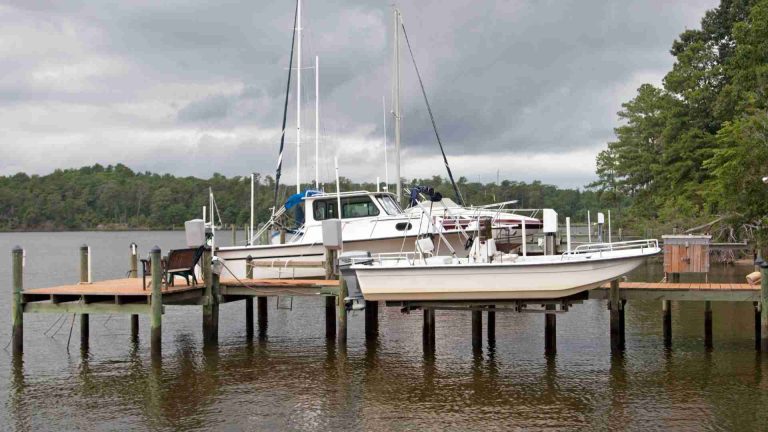
The Pros and Cons of Using a Boat Lift for Storage
Gently swaying in the tranquil waters, a boat embodies the epitome of adventure and leisure. Whether used for fishing, cruising, or watersports, boats provide an escape from the routine of life on land. Yet, beneath the surface of these aquatic excursions lies a crucial consideration: proper storage. Just as a well-maintained vessel promises endless possibilities,…
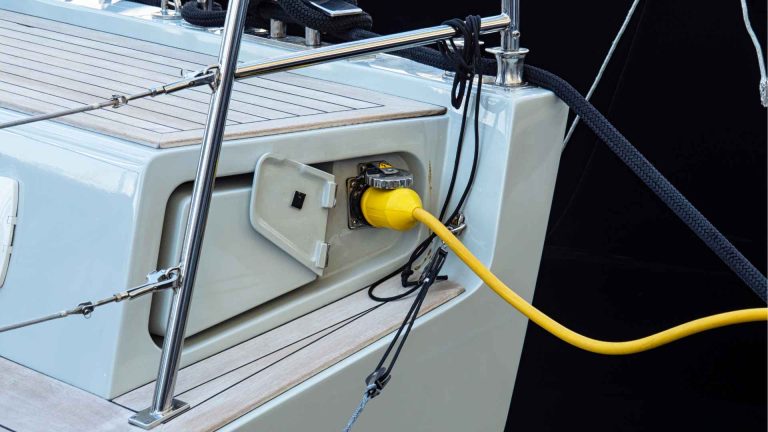
How Does Electricity Work on Boats? – Marine Power Guide
From powering navigation systems and lighting to running essential appliances, electricity is a vital aspect of boating. Whether you’re a seasoned sailor or a newbie setting sail for the first time, understanding marine electricity is crucial for safe and efficient boating experiences. In this article, we will delve into the fundamentals of how electricity works…
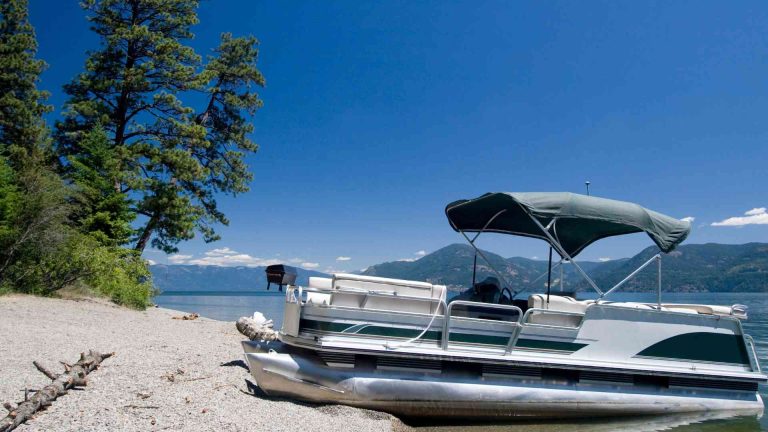
Benefits of Using a Bimini Top for Sun Protection on a Boat
Ah, the allure of the open waters, where the sun’s radiant embrace transforms each wave into a glistening dance. The joy of boating is a melody that resonates with adventure and serenity, a symphony composed by the soothing lull of the waves. Yet, amidst this aquatic reverie, a crucial note of caution beckons – the…

10 Steps to Properly Trailer a Boat and Launch It at a Ramp
Picture the sun glistening on the water’s surface, the gentle sway of the waves, and the thrill of embarking on a boating adventure. Yet, amidst this excitement, lies a crucial step that sets the tone for your nautical journey: the art of trailer launching and ramp maneuvering. As any seasoned boater knows, a successful launch…
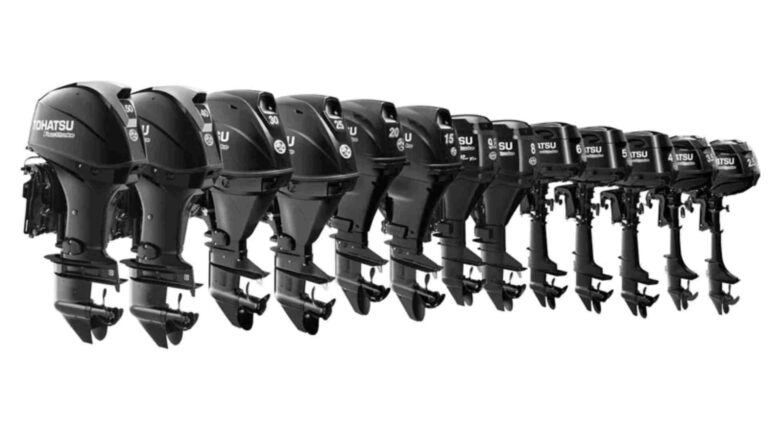
4 Most Common Problems with Tohatsu Outboards
Tohatsu outboards are known for their reliability and durability. However, like any mechanical device, they can experience problems from time to time. Here are some of the most common problems with Tohatsu outboards and how to fix them. 1. Fuel System Problems Fuel system problems are one of the most common causes of Tohatsu outboard…

Boat Weight Estimates For 7 Weight Boat Types
If a vehicle treads water, it’s a boat. That’s why boats can come in so many shapes, sizes, and types, each having its own weights and weight capacities.
With so many varieties out there, we have created this page to explain the average boat weight for the most popular boat types available on the market.
Boat weight metrics can be difficult to understand, especially if you’re new to boating, so learning how it works with several boat types can help.
While each individual boat will weigh differently, we can estimate the dry weight of each boat to some success. We have included examples of boat models throughout the page to show that these weights are found in the wild.
Side note: the weights mentioned in this guide are dry weights – the weight of the boat without having fuel and leisure gear stored aboard.
This means that a fully-kitted boat will be heavier. With fuel, interior equipment, and a trailer attached, you can increase the total weight by approximately 2,000 pounds.
We have broken down each boat type and their average weights below, including details about the vehicles you’ll need to tow each boat category.
If you want a quick rundown, here’s a convenient table that should have the answers you seek:
Boat Weight Estimates
There’s only so much a table can communicate, so let’s go into more detail about each boat type and how much they weigh. We have seven different types of boats below, ranging from under 1,000 pounds to over 30,000 pounds!
1. Personal Watercrafts (PWCs) – 850 Pounds
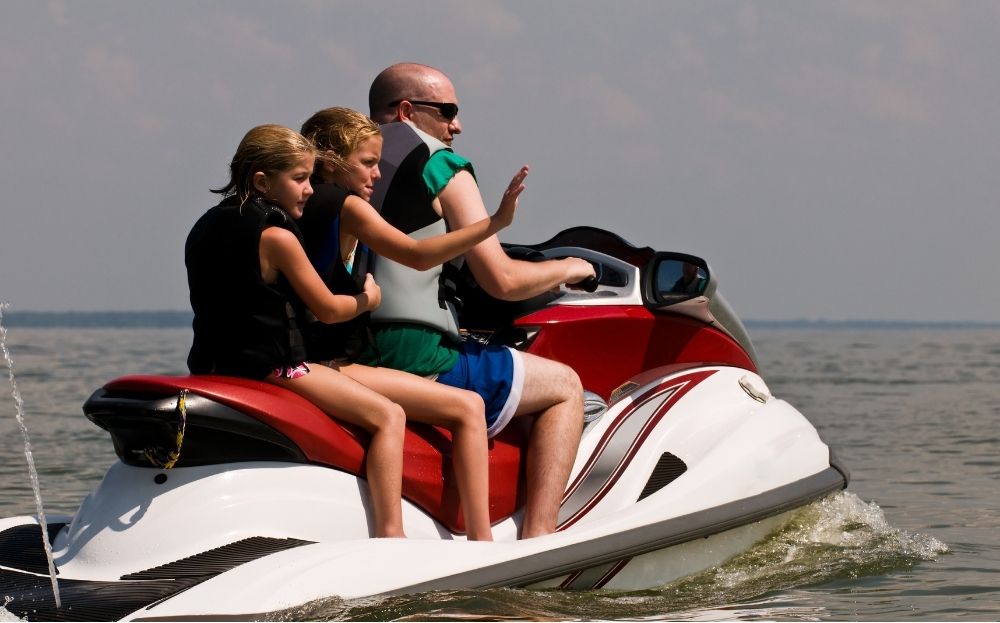
First, there are personal watercraft. PWCs are the smallest boats that we have covered on this page, though some would argue they aren’t boats at all.
They are also more affordable for the average person and so they are a very popular choice, so it’s better to include them for those that need weight information on PWCs .
Naturally, their small size means they have an average dry weight of just 850 pounds.
This can vary by a few hundred, as demonstrated by PWC models like the Sea-Doo Spark (450 pounds) and the Kawasaki Ultra 310 LX (1,074 pounds).
So, while the average PWC is 800-850 pounds, you can find many other small water-treading vehicles that weigh a little more or less.
In this case “a little” is a few hundred pounds but, when you see the hefty boats we’re covering on this page, that’s a relatively small difference.
Where towing is concerned, PWCs can be towed by cars, which is another reason that they are so accessible.
Some cars can even pull two personal watercraft at once, as can larger vehicles like SUVs and trucks for those who have families. Needless to say, anything larger and stronger than a car can also pull a PWC with ease.
2. Sailboats – 8,800 Pounds
Sailboats are the most varied kind of boat, being made up of personal vessels that don’t fit into other categories.
Go to your local port and scope out the marina, you’ll see that the boats there vary wildly in size, shape, and weight, and most of them will be sailboats with sails.
Our average sailboat was 8,000 to 8,800 pounds, though some popular boat models like the Sunfish are technically sailboats despite weighing just 120 pounds.
They look and weigh more like a dinghy boats or a kayak than the larger sailboats out there, and you’d probably mistake them for one at a glance, but they are the smallest sailboats.
As for the heavier boats, you have smaller models like the C&C 27 at approximately 5,000 pounds and then larger ones like the Swan 48, which is 36,000 pounds.
That makes the Swan 48 the single largest boat mentioned on today’s page.
With such variety between sailboats and how large they can be. Those smaller 120-pound sailboats are much easier to tow than a 30,000-pound monstrosity, for example.
An SUV can tackle smaller boats but you’ll obviously need something more substantial for larger boats, and some are so large that they just cannot be towed and are better off stored in the water, ready to go.
3. Ski Boats – 3,500 Pounds
Where personal boats don’t have sails, they are usually ski boats that use a motor to get around. Unlike sailboats, it’s much easier to estimate how heavy a ski boat will be.
The average is 3,500 pounds but it can be below 3,000 pounds in some cases and, with large boats like the Malibu Wakesetter 2017 24MXZ, up to 4,800 pounds. Larger models can touch 6,000 pounds, too.
Ski boats have become more popular in recent years, especially as water sports have become more popular.
You can wakeboard or water ski from a ski boat that can travel at faster speeds, not from a sailboat that gently follows the wind.
As such, ski boats tend to be the favorite of those in warmer climates where water sports are more accessible and fun to perform.
As for how towable they are, most ski boats can get towed by SUVs and trucks though you should always check beforehand.
It’ll vary between boat types and what vehicle you have, obviously, so maybe your vehicle isn’t up to it. In those cases, you can get a larger vehicle to cater to your needs.
4. Cabin Cruisers – 8,700 Pounds
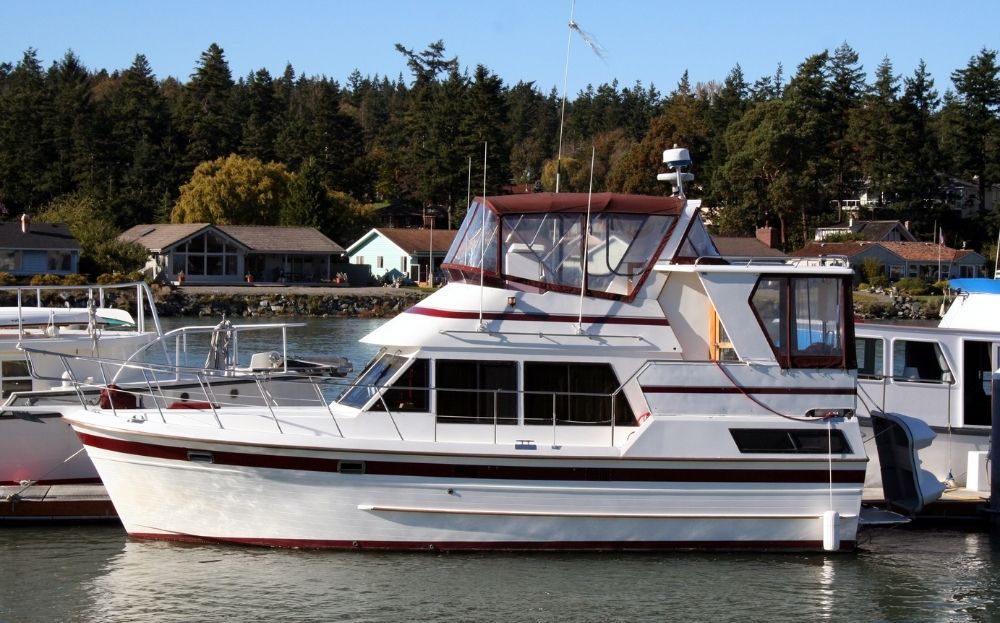
Cabin cruisers are another type of boat that’s pretty heavy, alongside the larger sailboats out there. This makes sense since cabin cruisers, as the name suggests, are boats that are better adapted for living in.
They have more beds and dining areas, like an RV contained in a boat, and so they need to be heavier to accommodate that. Cabin cruisers are sometimes described as mini yachts, which is the best way to think of them.
The average cabin cruiser is somewhere between 8,000 and 8,700 pounds.
Smaller models like the Larson Cabrio 274 are 2,000 pounds lighter (weighing in at approximately 6,000 pounds) while larger models like the Rinker Express Cruiser 301 can weigh 12,000 pounds.
Naturally, the capacity of the boat will play a large part in how heavy the vehicle is.
If the boat is just for you, you can get away with a much smaller model than a cabin cruiser that needs to house an entire family. Some cabin cruisers can comfortably accommodate ten people or more!
Just like with larger sailboats, heavy-duty vehicles will be needed to tow them. Some larger SUVs may be up to the task but a truck is the safest bet.
Smaller cabin cruisers can get towed by most SUVs but, as always, check first. The SUVs and trucks need to weigh more than the cabin cruiser they are trying to haul around.
5. Speed Boats – 8,000 Pounds
Speed boats are similar to ski boats and they are often conflated, though there is a difference between them.
Speed boats are sleek and fast – faster than any ski boat out there – and are instantly recognizable after decades of representation in pop culture.
While they are the height of fast-paced, sea-faring decadence – speed boats are too fast to safely perform water sports on them, so you’ll need a ski boat for that.
The average speed boat should weigh approximately 8,000 pounds, which is mostly from the powerful motor and mechanics inside the boat.
Lighter models, like the Thunder Cat 32, weigh around 5,000 pounds while boats like the Cigarette Top Gun 38 weigh 9,000 pounds.
Counterintuitively, the faster boats tend to weigh more since they need larger engines and motors to slice through the water and move faster.
Many SUVs and trucks can tow speed boats, with lighter models being more accessible for towing. If your boat is around 5,000 pounds, most SUVs should be up for the job, otherwise, a heftier truck may be ideal.
6. Pontoon Boats – 3,100 Pounds
Pontoon boats are large but light boats that have decks for people to hang out. They are very similar to deck boats, though they tend to be faster and pontoon boats are better for slower, chilled recreational activities.
The average pontoon boat weighs 3,100 pounds. An example of a lighter pontoon boat would be the 2,100-pound NauticStar Angler 193 SC. As for a heavier pontoon boat, the Hurricane 2690 SunDeck weighs over 4,400 pounds.
As you’d expect, the weight correlates with how large the deck is and how many people that deck can accommodate.
In the grand scheme of boating, 3,000 pounds isn’t that heavy. As such, pontoons and deck boats can be towed by larger SUVs and trucks with no trouble.
Smaller SUVs and trucks shouldn’t be used to haul them around, they may not be up for the task.
7. Small Fishing Boats – 1,700 Pounds
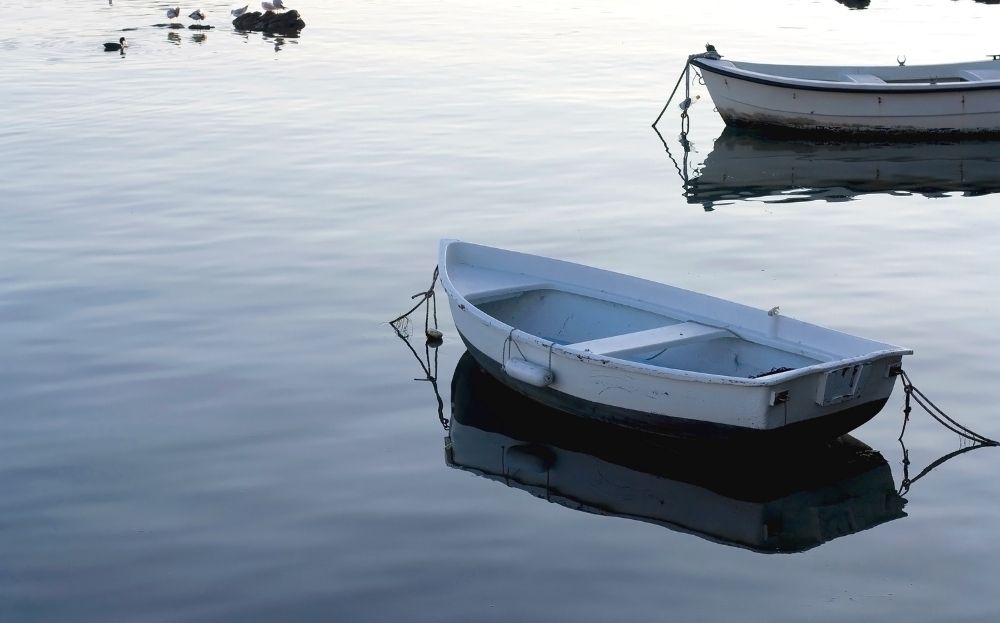
Our last boats are some of the most practical – fishing boats. You’re probably not looking to get an industrial-grade trawler, so we’re talking about small fishing boats that your average Joe can buy and enjoy.
These are sometimes called bass boats too, and their design accommodates equipment that can be as simple as fishing rods or as complex as a mini radar system.
For these boats, the average weight is 1,700 pounds. Some, like the Tracker Pro 2017 170, weigh under 1,000 pounds while others, like the Bass Cat Jaguar, weigh over 2,000 pounds.
The heaviest fishing boats weigh around 2,500 pounds.
Smaller fishing boats are some of the lightest, which makes sense considering they are designed for fishing trips.
This means they have been made with towing in mind, so the effort is made to keep them light and towable for the typical angler.
As such, many mid and heavy-sized SUVs can tow all fishing boats while smaller boats can be tackled by a smaller SUV as long as the SUV is heavier.
Factors That Affect Boat Weight
As we said at the start of this page, the weights we have discussed so far are dry weights.
This means it’s the weight of the boat itself, without many of the amenities or the fuel that it’ll get pumped full of, which adds extra weight.
Think of it as the minimum that the boat will ever weigh, which is why it’s useful for knowing how heavy the boat is and its ability to get towed when empty.
So, if you want to know the total weight of your boat, you’ll need to consider the other factors. Here are some of them:
- Fuel, which can add a minimum of 200 pounds to the boat. At most, 500 pounds can get added by a full gas tank on larger boats.
- General gear/amenities, which is everything from life vests to snacks and portable storage like coolers. These can weigh between 100 and 500 pounds depending on how kitted out your boat is.
- Electronics, particularly things like amps and speakers, and a TV if the boat can accommodate it. These electronics can weigh between 50 pounds and 300 pounds.
- Towers, which are usually optional but will be needed for activities like wakeboarding, can add as much as 50 to 300 pounds.
Using those numbers, outfitting your boat can add anywhere between 400 and 1,600 pounds. If you can think of other equipment that you’ll add to the boat, it can easily exceed 2,000 pounds added once the boat is ready to be at sea.
If all this estimating is frustrating for you, you wouldn’t be the first! Most boats are weighed through calculations and estimates since most boat owners don’t have access to industrial weighing scales.
That said, you can hook up your boat and use the same weighing scales that truckers use to measure the weight of their hauls. This will give you an accurate measurement, down to the ounce.
Then you don’t need to worry about estimating how much your boat weighs and you’ll always match it to the right vehicles for towing.
That should be everything you want to know about the different types of boats and how much they weigh.
We have covered seven of the most popular boat types and given you accurate readings on many different models, along with an average figure for that category.
Using those, you should be able to figure out how much your boat weighs if you have one already. If not, you can get the right boat for yourself.
Knowing the exact weight of your boat can also be useful, so you can always weigh your boat at an industrial weighing scale if you want more accurate readings.
As a rule, larger boats will weigh more than smaller ones.
The two most notable exceptions come with speed boats and pontoon/deck boats, where the smaller speed boats are packed with heavy machinery while the pontoons are mostly deck, so they are lighter.
About the author
I worked as an officer in the deck department on various types of vessels, including oil and chemical tankers, LPG carriers, and even reefer and TSHD in the early years. Currently employed as Marine Surveyor carrying cargo, draft, bunker, and warranty survey.
Latest posts

What Does a Longshoreman Do?
Longshoremen play a critical role in the global supply chain, bringing billions worth of cargo into the country. So what does a longshoreman do exactly?

The Ocean Warming Effects on Marine Life
The last few decades have seen ocean temperatures rise as climate change begins to affect maritime industries worldwide. Here are the ocean warming effects on marine life seen so far.
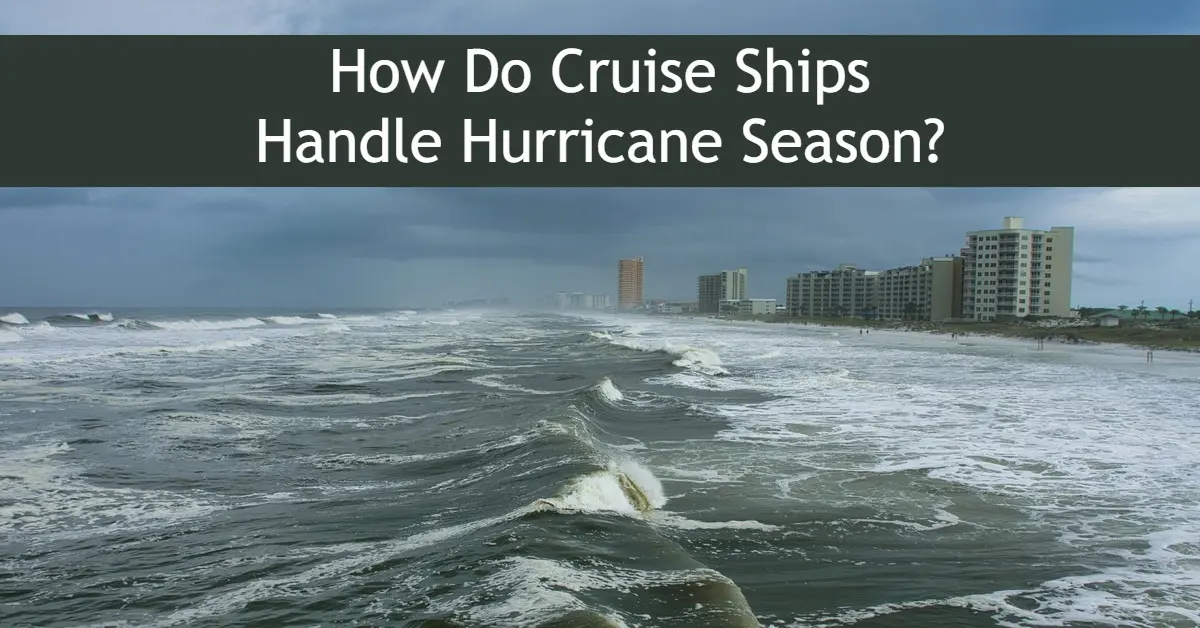
How Do Cruise Ships Handle Hurricane Season Cruises?
Thankfully, modern cruise ships can handle a hurricane season cruise. Due to past experiences and new advancements, crews prove these boats operate well no matter the weather.

The Ultimate Guide to Boat Weight: Dry vs Wet
Boat weight is an important factor to consider for any boat owner or captain. Knowing the total weight of your boat, including both the dry weight and wet weight, can have major implications for safety, performance, and legality. In this comprehensive guide, we will break down the differences between dry weight and wet weight, the major factors that affect boat weight, how to accurately calculate your boat’s weight, and why this measurement matters for successful boating.
What’s the Difference Between Dry Weight and Wet Weight?
When it comes to boat weight, there are two main measurements to understand:
- Dry weight – This refers to the weight of the boat itself without any fuel, water, gear or additional accessories loaded onboard. The dry weight includes just the boat and its factory-installed equipment.
- Wet weight – Also known as the “loaded weight,” this is the total weight of the boat with full fuel, water, and gear/accessories loaded onboard.
The wet weight is going to be significantly heavier than the dry weight, sometimes by thousands of pounds depending on the size and type of boat. The differential between the two weights is important to understand for safe trailering and ensuring your boat stays within its weight capacity.
To illustrate the difference, let’s look at a simple example. Consider a 25-foot center console fishing boat with a published dry weight of 5,000 pounds from the manufacturer. Once you fill up the 200-gallon fuel tank, 50-gallon livewell, onboard freshwater system, and load your gear for a full day of fishing, the total wet weight for this boat may be over 7,500 pounds – a full 2,500 pounds heavier than the dry weight!
Always refer to your owner’s manual to find the official dry and wet weight ratings from the manufacturer. The dry weight should stay constant over the life of the boat, while the wet weight will vary depending on the amount of fuel/water and total gear loaded.
Related: Explore The Beauty Of Innsdale Trail: A Comprehensive Guide
What Factors Affect a Boat’s Weight?
Many different characteristics contribute to a boat’s overall weight and the difference between the dry and wet measurements. Some key factors include:
Size/Length
In most cases, a longer boat will weigh more than a shorter boat of the same make/model. The greater the total surface area and internal capacity, the heavier the dry weight is likely to be. A 50-foot sport yacht will have a much higher dry weight than a 25-foot center console of the same manufacturer.

Type of Boat
Different boat types also cause major variances in weight due to their intended purpose and construction. For example, a heavy-duty aluminum bass boat will usually have a higher dry weight than a recreational pontoon of the same length because it requires thicker gauge aluminum for durability. Purpose-built offshore fishing boats also tend to have heavier dry weights than boats designed for calm inland waters.
Construction Materials
The materials used to construct the boat greatly impact its base dry weight. Aluminum, steel, and fiberglass are the most common modern boatbuilding materials, ordered from heaviest to lightest. Exotic wood boats also tend to be lighter than plastic/aluminum, but they are much less common today. The thickness of the chosen material also factors in.
Engine Size
The size of the engine(s) directly contributes to the dry weight. More powerful engines with greater displacement are heavier. Twin outboard motors will add more static weight than a similar single outboard. The transmission, fuel lines, control cables, gauges, and other components of larger engine packages also bulk up the dry weight.
Related: The Ultimate Guide To Kayak Transducers: Everything You Need To Know
Interior Options & Accessories
Add-ons like cabin furnishings, hardtops/Bimini tops, electronics packages, lighting, porcelain heads, high-end audio systems, and other optional accessories can really add up in terms of added poundage. Even small conveniences like a refrigerator, microwave, or electric windlass will bump up the factory dry weight specifications.
Onboard Systems
Functionality systems integrated into the boat like livewells, freshwater tanks, washdowns, pumps, macerators, and more also contribute to overall weight – even when empty. Their plumbing hardware, through-hull fittings, pumps, and storage tanks all factor into the base dry weight.
As you can see, the dry weight figure is more than just the shell of the boat – it also includes fully integrated systems and chosen accessories from the manufacturer. This is important to keep in mind when comparing the stats of different makes and models.
How to Calculate Your Boat’s Weight
Let’s move on to discussing how you can accurately calculate both your boat’s dry weight and wet weight. This requires weighing the actual vessel on a trailer to get real-world measurements.
Calculating Dry Weight
Measuring the dry weight of your boat is easiest when it is still new from the factory without any fuel, fluids, or accessories loaded. Simply take the boat on its trailer to a public weigh station or truck scale. Ensure the trailer is empty of any items like coolers, covers, or tie-downs which may affect the total weight. Also, double check the fuel tanks are dry.
Related: The Ultimate Guide To Portaging A Kayak: Techniques, Gear, And Safety Tips
Drive the boat and trailer slowly across the scale and get a base weight measurement. Next, unhook the trailer and pull the empty trailer across the scale to get its isolated weight. To determine the dry weight of just the boat, subtract the weight of the empty trailer from the combined gross weight. This simple calculation will tell you the actual dry weight, which you can compare against the manufacturer’s published specs.
If you no longer have an empty boat to weigh the dry mass, you can still get in the ballpark using a subtraction method. Start by weighing the entire loaded trailer at a scale. Then offload everything you can from the boat including all portable items, cargo, and fluids. Weigh the trailer again without the extra load to find the net weight of the stripped boat and trailer. Finally, subtract out the published weight of the empty trailer to derive an estimated dry weight of the bare vessel.
Calculating Wet Weight
Getting an accurate wet weight (loaded weight) measurement is crucial for understanding the maximum capacity of your boat and potential risks for overloading. Here is a safe process for determining an approximate wet weight:
- Load the boat as you would for a typical day of boating. This includes full fuel, gear, safety equipment, water/drinks, and the maximum number of passengers. Make sure everything is secured onboard.
- Drive the loaded boat and trailer slowly across a weigh station scale. Get a printed ticket with the total gross weight.
- Offload all passengers so only the loaded boat and trailer remain. Pull the trailer back across the scale to get the gross weight without people.
- Subtract the second gross weight from the first gross weight measurement. This will tell you the total passenger weight you just offloaded.
- Add the estimated total passenger weight back to the second gross weight measurement to get an approximate loaded boat weight.
- Compare your wet weight calculation to the maximum capacities listed on your boat’s NMMA or Coast Guard capacity plate. This will confirm whether your typical loaded condition exceeds the recommended limits.
To fine-tune this even further, you can also weigh all your removable gear and cargo off the boat on a separate scale. Then you can subtract those exact weights from the second gross figure in step 3 above to derive a very accurate wet weight number.
This process requires a bit more time and a few trips across the trailer scale, but the precise wet weight data is invaluable for onboard safety. You should re-weigh periodically before each season or anytime you add heavier gear.
Related: Discover The Charm Of Innsdale Drive: A Guide To Location, History, Attractions, And More
Why It’s Important to Know Your Boat Weight
Now that you understand dry weight vs. wet weight and how to measure them, let’s discuss why this boat weight data is so important for any boating scenario:
Towing and Trailering
Knowing the total weight of your boat and the typical loaded condition is crucial for safe trailering. Exceeding your vehicle’s towing capacity or overloading the trailer can cause hazardous situations on the road. The trailer components like axles, tires, springs, and brakes also have weight limits you need to stay below. Checking the gross rig weight against your exact dry and wet weights will keep towing secure.
Launching and Retrieval
Boats quickly reach their maximum capacity limits when lifting from docks or ramps. Knowing the precise wet weight will tell you if you are risking overloading your lift, davit, or hoist during launching and retrieval. It also helps determine if you need to offload some gear beforehand. Trying to hoist thousands of pounds over the wet weight rating can cause equipment failure and serious accidents.
Performance Characteristics
The weight of your boat affects almost all aspects of its performance – speed, fuel efficiency, stability, and handling. With an accurate wet weight, you can better understand your boat’s cruise speed, range per tank of fuel, and carrying capacity for your usual boating activities. Tracking this over time can reveal if any heavy additions are impacting your boat’s performance.
Loading and Balance
Properly distributing weight aboard your boat is key for maintaining balance and flotation. With precise measurements of your total wet weight and individual gear/cargo items, you can strategically load and stow everything to keep the boat level athwartships and longitudinally. Poor weight distribution can make boats unstable, lower freeboard, or create listing concerns.
Related: Choosing The Right Canoe Weight: Factors, Options, And Benefits
Boat capacities, max weight ratings, and maximum horsepower limitations all depend on the measured weight. Overloading beyond these legal limits can put your boat registration and insurance at risk. If stopped by authorities like the Coast Guard or harbor patrol, you must be able to provide accurate weight figures and show you are not exceeding regulatory limits.
As you can see, being aware of your individual dry weight and wet weight at all times keeps your boating safe, performs optimally, and suitable for all needed conditions. Regularly tracking these weights is a wise habit for all boaters.
Whether you are shopping for a new boat, getting ready for a trip, or tuning performance, understanding the difference between dry weight and wet weight is critical. This guide breaks down all the key factors affecting boat weight, how to accurately calculate it for your specific watercraft, and the reasons it matters so much for successful boating.
The dry weight represents the bare bones of the boat straight from the factory, while the wet weight encompasses all the liquids, cargo, and extras you load up for time on the water. You can measure these weights on a trailer scale to get custom figures for your particular setup. Closely monitoring your boat’s weight distribution and total loaded condition will keep passengers safe, equipment secure, and performance ideal over the long run. Don’t skip this important step before any voyage!
About author
Benchmark your boat. Explore & Save
Search and compare multiple boats, performance ratios and much more. add your boat and benchmark it against others., explore by maker.
Aicon Yachts

Altima Yachts
Aquador boats.

Aquastar Yachts

Archambault

Arcona Yachts

Astus Boats

Azimut Yachts

Back Cove Yachts

Bavaria Yachts

Benetti Yachts
Explore by type.
Are you a Sail, Power or... SuperSailor?!
Explore by Hull type
...some say one is enough, others prefer two and some have even three! Where do you linger?
Do you love boats, have one already or plan for one? We got you covered!
Get TheBoatApp and have all of your boating life in one app, fully catalogued, organized and backed-up, accessible from anywhere on any device, online as well as offline.
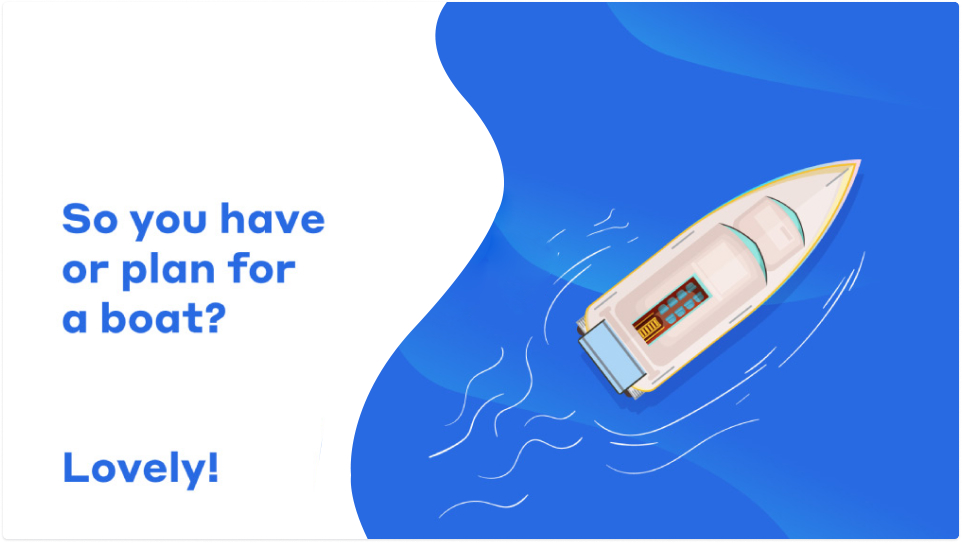
Available for
FREE Forever - No credit card required
Checklists from TheBoatApp community. Proven workflows to get things right!
A wide variety of checklists, available for you to pick and use out of the box! You like one, simply follow it and always have the latest version. You want to customize one, simply copy it and edit away to your liking!
From our blog
Dive into a sea of articles about boating, product news and marine personas.

Boat Comparison & Benchmarking made easy!
Benchmark your boat versus the “competition” or simply compare side-by-side. Spot differences easily among many boats and benchmark performance ratios!
Join our community
Fellow mariners and platform enthusiasts live here! Join in to make questions, exchange views and ideas about existing and future features, and much more!

How Much Does a Boat Weigh? Understanding Vessel Weight Averages
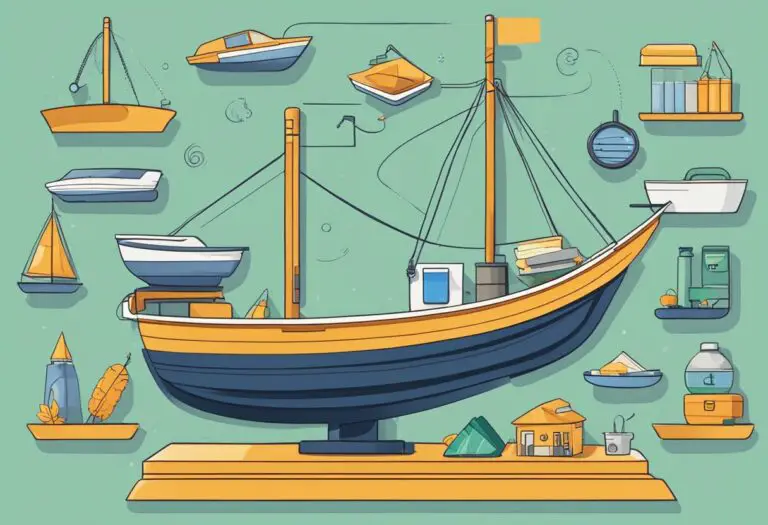
Here’s a basic breakdown of average weights by boat type:
- Aluminum Fishing Boats: Typically range from 300 – 500 pounds
- Bow Riders: Usually weigh around 3,000 – 3,500 pounds
- Cabin Cruisers: Often weigh between 12,000 – 16,000 pounds
For larger vessels, the weights can significantly increase. For instance, medium-sized boats ranging from 28-35 feet can weigh between 5,800-13,500 pounds . Even more substantial are large boats within the 36-45 feet category , boasting weights anywhere from 15,500-29,000 pounds .
Each type of boat serves a different purpose, and understanding their weight is essential for handling , transport , and storage . Boat owners and potential buyers must recognize how these weights may impact the boat’s performance, the capacity of their vehicle for trailering, and ultimately, the safety of their journeys on the water.
Types of Boats and Average Weights
When considering the purchase of a boat or preparing to transport one, knowing the average weight is essential. This weight impacts the necessary trailer , storage options, and potential restrictions on use.
Dinghies and Skiffs
Dinghies and skiffs are small, lightweight boats often used for short-distance travel and fishing in calm waters. Typically, skiffs vary in weight from 300 to 1,000 pounds , depending on materials and length.
Fishing Boats
Fishing boats come in a variety of shapes and sizes, each designed for the specific needs of anglers. Small aluminum fishing boats can be as light as 400 pounds , while larger, more equipped models, like a 20-foot center console boat, might weigh approximately 1,600 to 2,500 pounds . Average weights for different types of fishing boats can guide buyers and owners in logistical planning.
The weight of sailboats can significantly vary based upon size, design, and the materials used in construction. A small day sailer might weigh around 700 pounds , while a large keelboat can exceed 10,000 pounds . Sailors must consider this when assessing mooring requirements and dry dock storage.
Pontoon Boats
Pontoon boats are known for their flat, stable platforms and lightweight construction. An average 22-foot pontoon boat may weigh about 2,200 pounds without the added weight of the engine, fuel, and gear. Pontoons are popular for leisurely trips on calm lakes and rivers.
Speedboats, designed for higher speeds and agility on the water, have a broader weight range. A typical 20-foot speedboat weighs between 2,500 to 3,500 pounds , influenced by the hull material and additional features for performance.
Cabin Cruisers
Cabin cruisers provide comfort and amenities for extended stays on the water and are consequently heavier. On average, a 14-foot cabin cruiser will typically weigh in the ballpark of 14,000 pounds , with larger models increasingly heavier. Detailed statistics on cabin cruiser weights offer insight into the robust infrastructure required for docking and maintenance.
Factors Influencing Boat Weight

Several variables contribute to the overall weight of boats, each component playing a pivotal role in determining the final measurement. Understanding these factors can assist in anticipating the weight range of a vessel.
Material Construction
The materials used to build a boat significantly affect its weight. For instance, boats constructed from fiberglass tend to be lighter than those made of wood. On the other hand, aluminum boats offer a balance between durability and weight, often being lighter than wood but heavier than fiberglass. Specific data on boat materials and their weights help illustrate these distinctions.
Boat Size and Dimensions
The overall length and width of a boat are directly proportional to its weight. Larger boats have more mass simply due to their size. A boat that falls within a 17-22 feet range might weigh around 1,600-3,200 pounds , whereas boats that are 23-27 feet long can weigh between 3,600-4,800 pounds . Dimensions play a crucial role in assessing weight, per details found on a boating data chart .
Engines and Equipment
The quantity and size of the engines , along with additional equipment such as electronics and fishing gear, also add to a boat’s weight. More powerful engines and extensive equipment result in a heavier vessel. A detailed weight calculator can be leveraged to evaluate the total weight considering such variables, as demonstrated by this Boat Weight Calculator .
Fuel Capacity
The capacity of the fuel tank influences a boat’s weight, as the weight of the fuel must be considered when calculating the total mass. Full fuel tanks can significantly increase the overall weight, which is essential for calculating transport and performance characteristics. Details on the impact of fuel capacity on weight are discussed in J.D. Power’s boating guide .
Boat Weight and Transportation
When considering transportation for boats, the weight of the boat and its associated gear is a critical factor in choosing the right trailer and tow vehicle.
Trailer Weight Considerations
The weight of the boat is often specified as dry weight , which does not include fuel, gear, or other items that might be on board during transport. A boat’s dry weight plus the weight of its engine, fuel, and equipment is referred to as the gross weight , and it’s important to know when selecting a trailer. For example, a skiff typically weighs between 300 to 900 pounds , which would necessitate a different trailer than a larger vessel such as a cabin cruiser.
The trailer itself also has a Gross Vehicle Weight Rating (GVWR) , which is the maximum weight the trailer can safely carry. This includes the boat’s weight, the trailer’s weight, and any additional cargo. Here is a simplified example of boat and trailer weight considerations:
Towing Vehicle Requirements
The tow vehicle must be capable of handling the combined weight of the boat and the trailer. This is referred to as the towing capacity . The vehicle’s owner’s manual will list the towing capacity which must exceed the combined weight to ensure safe transportation. Trucks and SUVs often have higher towing capacities, with some trucks being able to handle more than 5,000 pounds easily, including the boat and the trailer weight.
When selecting a vehicle for towing, one must consider the following factors:
- Engine Size : Larger engines generally provide more towing power.
- Transmission : A vehicle with a transmission cooler is preferable for towing, as it helps prevent overheating.
- Braking System : A robust braking system is vital, as it needs to stop the additional weight safely.
- Suspension : The vehicle should have a capable suspension system to handle the load and maintain stability.
Weight Capacities of Boats
When discussing the weight capacities of boats, one needs to closely examine not only the manufacturer’s specifications but also the safety compliance ratings to ensure a secure and enjoyable boating experience.
Manufacturer Specifications
Boat manufacturers typically provide a boat’s weight capacity in their specifications. For instance, small boats might have a weight capacity of several hundred pounds while larger boats can hold weights of several thousand pounds. Boat Weight Capacity Calculator – GEGCalculators provides estimated weight capacities for various boat lengths, but stresses that these can vary due to design and construction differences.
Safety Compliance Ratings
Safety compliance ratings, such as those established by the U.S. Coast Guard, are essential for determining how much weight a boat can safely carry. These ratings incorporate an average weight per person to calculate the maximum number of passengers. As per BOATERexam.com® , many manufacturers use an average weight of 150 pounds per person for these calculations. However, if passengers are heavier than this average, the number of people on the boat may need to be reduced to stay within safe operational limits.
Measuring Boat Weight
Assessing a boat’s weight involves understanding the distinctions between dry weight and wet weight, as well as utilizing specific tools to determine the mass accurately.
Dry Weight Vs. Wet Weight
Dry Weight refers to the boat’s mass without any consumables or gear. This includes only the hull and installed equipment such as the engine and built-in fixtures. It is the base weight of the boat when it’s not in use and is crucial for transportation and storage considerations.
- Fluids (e.g., fuel, oil, freshwater)
- Equipment and safety gear
- Personal belongings and provisions
Wet weight is most relevant for operational purposes, such as compliance with safety regulations and determining the boat’s performance and fuel efficiency.
Tools for Weighing Boats
To measure a boat’s weight, marine scales or crane scales are typically employed.
- Marine Scales : These are specialized scales designed to accommodate a boat’s size and shape. They are often found at marinas and boatyards.
- Crane Scales : For larger vessels, crane scales may be used. These are attached to a crane that lifts the boat, measuring its weight through tension.
It is essential to consult the boat’s manufacturer or a professional weighmaster to ensure accurate measurements, particularly when the data will be used for legal or commercial purposes.
Frequently Asked Questions

Understanding the weight of different types of boats and the factors that contribute to it is essential for safe operation and transportation. This section addresses common queries related to boat weight.
What is the average weight range for fiberglass boats?
The average weight range for fiberglass boats can vary widely, but generally, a mid-sized fiberglass boat can weigh anywhere from 2,500 to 15,000 pounds.
How can you calculate the weight of a boat including its trailer?
To calculate the weight of a boat including its trailer, one must first determine the boat’s dry weight and then add the weight of the trailer, which is typically between 300 to 1,500 pounds. The weight of any additional gear or fuel should also be included in the calculation.
What are the typical weight considerations for towing a boat?
When towing a boat, weight considerations include the boat’s dry weight, the weight of the trailer, and the weight of gear, fuel, and any other items aboard. The towing vehicle’s maximum towing capacity must not be exceeded.
What’s the approximate weight of a small (12-16 foot) boat?
A small boat measuring between 12 to 16 feet can weigh between 100 to 1,200 pounds, depending on the design and materials used.
How does boat length impact the overall weight?
Boat length significantly impacts overall weight. Generally, as a boat’s length increases, so does its weight, due to larger hulls, bigger engines, and extra features or equipment.
Where can one find a reliable boat weight calculator?
A reliable boat weight calculator can help estimate the total weight of a boat including gear and fuel. One can find this tool on boating websites or by contacting manufacturers directly.
Leave a Comment Cancel reply
Save my name, email, and website in this browser for the next time I comment.
Keep in mind that we may receive commissions when you click our links and make purchases. However, this does not impact our reviews and comparisons. We try our best to keep things fair and balanced, in order to help you make the best choice for you.
As an Amazon Associate, I earn from qualifying purchases.
Vanquish Boats
500 Lewis Drive Carolina Beach, NC
+1 910-707-3599
© Vanquish Boats

Boat Weights & Trailers: Types & Towing Tips
Ahoy, matey! Let’s dive into the fascinating world of boat weights, including 12 boat types, their lengths, and matching them with the appropriate trailers and towing vehicles.
You might be wondering, “How much does a boat weigh?”
Well, the answer isn’t quite as simple as you might think. Boats come in all shapes and sizes, and their weights can vary significantly depending on the type, size, and materials used.
In this article, we’ll explore the wide range of boat weights and discuss the types of trailers and vehicles you’ll need to tow your aquatic adventure machine. So, grab your life vest and let’s set sail!
How Much Do Boats Weight by Type
- Dinghies and Small Sailboats (100-1,000 lbs, 8-20 feet) These lightweight boats are perfect for beginners or casual boating enthusiasts. Due to their minimal weight, you can easily tow them with a small car or SUV. No need for a beefy truck or specialized trailer here! A simple single-axle trailer will suffice.
- Aluminum Row Boats (100-500 lbs, 10-20 feet) Aluminum row boats are durable and lightweight, making them easy to transport. A small car or SUV can handle towing these boats with a basic single-axle trailer.
- Personal Watercraft (PWC) (400-1,000 lbs, 8-12 feet) Jet skis and other personal watercraft are popular choices for those seeking a thrilling experience on the water. They’re relatively light, so towing them shouldn’t be a problem for most vehicles. A simple PWC trailer should do the trick.
- Bass Boats (1,500-2,500 lbs, 16-22 feet) Bass boats are designed for fishing in shallow waters, and their sleek design allows for easy maneuverability. They typically weigh between 1,500 and 2,500 lbs, meaning a midsize SUV or truck can tow them with ease. A single-axle or tandem-axle trailer will work well for these boats.
- Bowriders (3,000-5,000 lbs, 18-30 feet) Bowriders are versatile boats with an open bow area for seating. They’re perfect for a day of fun with family and friends. Weighing between 3,000 and 5,000 lbs, you’ll need a larger SUV or truck to tow these boats. A tandem-axle trailer will be the best choice for these vessels.
- Cuddy Cabin Boats (2,500-4,000 lbs, 18-25 feet) Cuddy cabin boats offer a small sheltered area with limited sleeping accommodations, making them a popular choice for day trips and weekend getaways. They generally weigh between 2,500 and 4,000 lbs (dry), and a larger SUV or truck with a tandem-axle trailer is recommended for towing. Link leads to article dedicated solely to cuddy cabin boat weights.
- Pontoon Boats (1,500-5,000 lbs, 16-30 feet) Pontoon boats are known for their stability and spaciousness, making them excellent choices for leisurely cruises or parties on the water. Depending on the size, you may need anything from a midsize SUV to a full-size truck for towing. A tandem-axle trailer is commonly used for these boats.
- Cabin Cruisers (6,000-12,000 lbs, 25-40 feet ) Cabin cruisers offer a comfortable space for overnight stays and often come with amenities like a small kitchen and bathroom. Due to their size and weight, you’ll need a heavy-duty truck and a sturdy boat trailer with tandem or triple axles to tow these vessels.
- Sailboats (4,000-20,000+ lbs, 20-50+ feet) Sailboats can vary greatly in weight, depending on their size, hull material, and rigging. Smaller sailboats weighing 4,000-8,000 lbs can be towed with a full-size truck, while larger, heavier sailboats may require specialized transport. A tandem or triple-axle trailer is necessary for these boats.
- Yachts (30,000+ lbs, 40-100+ feet) Yachts are the epitome of luxury on the water. Due to their massive size and weight, they typically require professional transport, either by water or by specialized land trailers. Towing a yacht isn’t a job for your everyday vehicle!
- Speedboats (2,500-8,000 lbs, 20-35 feet) Built for speed and excitement, these boats can vary significantly in weight. Smaller speedboats might be towed by a midsize SUV, while larger, more powerful models will require a full-size truck or even a heavy-duty truck to handle the load.
- Houseboats (15,000-50,000+ lbs, 40-75+ feet) Houseboats are like floating homes, offering all the comforts of a house on the water. Due to their immense size and weight, houseboats usually require specialized equipment and professional services to transport them.
Understanding Dry Weight
When discussing boat weights, it’s essential to differentiate between a boat’s dry weight and its total weight when fully loaded.
The dry weight refers to the weight of the boat without any additional gear, fuel, or passengers. It’s the base weight of the boat, which includes the hull, engine, and essential onboard equipment.
However, dry weight does not account for the weight of items that are often added to the boat, such as personal belongings, provisions, or optional equipment.

Heaviest Items to Consider
When calculating the total weight of your boat, it’s crucial to consider the weight of all the items you’ll be bringing on board. Some of the heaviest items that can significantly impact the total weight of your boat include:
- Fuel: Gasoline and diesel fuel can weigh a lot, especially when you have large fuel tanks. Gasoline weighs roughly 6.1 lbs per gallon, while diesel weighs around 7.1 lbs per gallon. Take note of the capacity of your fuel tank and do the math.
- Water: Drinking water and water for onboard systems (such as sinks and showers) can add a significant amount of weight to your boat. Water weighs approximately 8.3 lbs per gallon . Take note of the capacity of your water storage on board and do the math.
- Waste Tanks: If your boat is equipped with a marine toilet and waste holding tank, the weight of the wastewater can also add up. This weight will vary depending on the size of your tank and how full it is.
- Batteries: Each marine battery on board will likely add an additional 60-75 pounds.
- Gear and Equipment: Items such as anchors, ropes, life jackets, coolers, ice, fishing gear, and other personal belongings can quickly add weight to your boat.
- Passengers: Don’t forget to account for the weight of passengers and pets when calculating your boat’s total weight.
When determining the towing capacity required for your boat, it’s important to consider the total weight, including all the additional items you’ll be carrying on board. By taking these factors into account, you’ll be better prepared to safely tow and operate your boat within its specified weight limits.
Boat Trailer Weight Ranges Based on Axles
Boat trailers come with different axle configurations that affect their weight capacities. The number of axles determines the overall weight a trailer can safely carry. Here’s a general overview of boat trailer weight ranges based on the number of axles:
- Single-Axle Trailers: Single-axle trailers are typically designed for smaller boats and have a weight capacity ranging from 1,500 to 3,500 pounds. They’re suitable for towing lightweight boats such as aluminum fishing boats, jet skis, or small sailboats. Single-axle trailers are generally more maneuverable, easier to handle, and more cost-effective than trailers with multiple axles.
- Tandem-Axle Trailers: Tandem-axle trailers, which have two axles, offer increased stability and can handle larger, heavier boats. These trailers can typically support boats weighing between 3,500 and 7,000 pounds. Tandem-axle trailers are ideal for towing medium-sized boats like ski boats, pontoon boats, or small to mid-sized cabin cruisers.
- Tri-Axle Trailers: Tri-axle trailers feature three axles, providing even more stability and support for larger, heavier boats. They can typically accommodate boats weighing between 8,000 and 18,000 pounds or more. These trailers are suitable for towing large boats such as houseboats, larger cabin cruisers, or yachts.
It’s essential to choose the right trailer for your boat based on its weight, including the additional weight of gear, fuel, and water. Always consult the trailer manufacturer’s specifications and recommendations to ensure safe and proper towing.

Common Vehicle Types and Their Towing Capacity Ranges
Different vehicles have varying towing capacities, which determine the maximum weight they can safely tow. Here’s a general breakdown of common vehicle types and their towing capacity weight ranges:
- Compact Cars: Most compact cars have a limited towing capacity of around 1,000 to 2,000 pounds . These vehicles are suitable for towing small boats, such as jet skis or aluminum rowboats.
- Sedans: Midsize and full-size sedans typically have a towing capacity ranging from 2,000 to 3,500 pounds . This allows them to tow small boats like aluminum fishing boats, small sailboats, or lightweight personal watercraft.
- Crossovers and Small SUVs: Crossovers and small SUVs usually have a towing capacity between 3,000 and 5,000 pounds . This capacity makes them suitable for towing small to medium-sized boats, such as bass boats, ski boats, or smaller speedboats.
- Midsize and Full-Size SUVs: These vehicles have a higher towing capacity, generally between 5,000 and 8,000 pounds . Midsize and full-size SUVs can tow larger boats, like cabin cruisers or cuddy cabin boats, and may even be able to handle some pontoons and wakeboarding boats.
- Pickup Trucks: Pickup trucks are known for their powerful engines and substantial towing capacities. Light-duty pickup trucks can tow between 5,000 and 12,000 pounds , while heavy-duty trucks can handle anywhere from 12,000 to 30,000 pounds or more . These trucks are capable of towing larger boats, such as larger cabin cruisers, houseboats, and even some yachts.
It’s crucial to consult your vehicle’s owner’s manual or contact the manufacturer to verify the specific towing capacity of your vehicle. Remember that towing a boat safely requires a combination of the right vehicle, proper trailer, and appropriate hitch.
Also remember that once you get to the water you’ll be backing up your vehicle down a ramp and into the water, so you’ll need the brakes and vehicle capability of dealing with that. It’s not just highway driving that you need to think about.
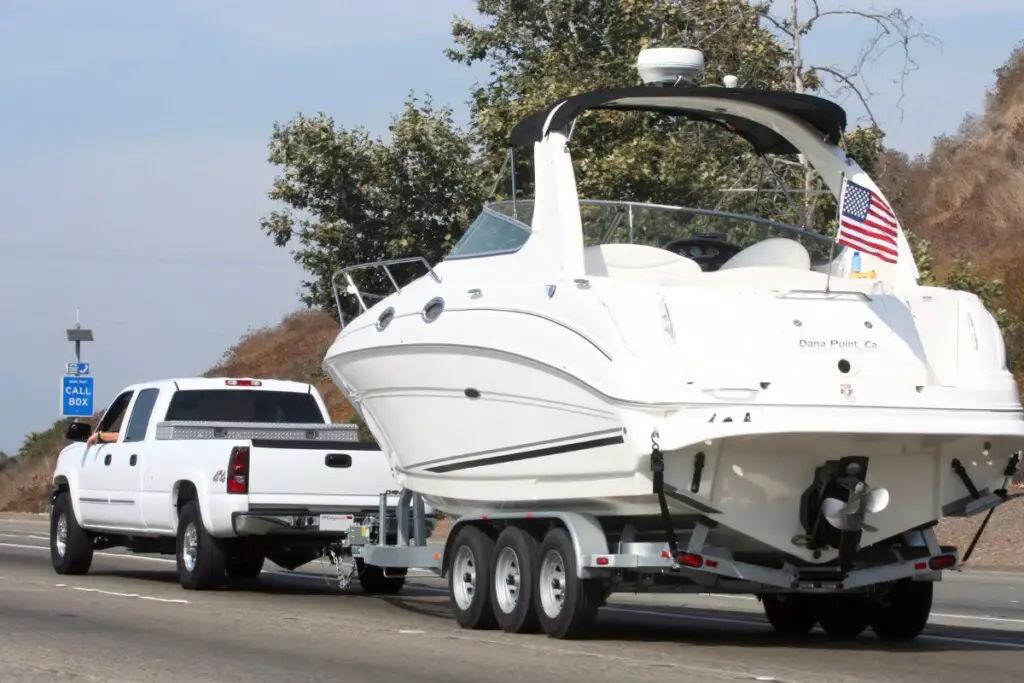
Final Takeaways
The weight of a boat can vary greatly depending on its type, size, and materials used in its construction. When towing a boat, it’s essential to have the appropriate trailer and vehicle to ensure safe and efficient transportation. By understanding the different boat weights and towing requirements, you’ll be better equipped to choose the perfect setup for your aquatic adventures.
Happy Boating!
Robert Van Nuck
Robert lives in central Michigan and enjoys running, woodworking, fixing up small engines, and getting out on the water with family, of course! He is also the owner and author of homebatterybank.com.
Recent Posts
Glare No More: Selecting the Perfect Boating Sunglasses
Sunglasses are a vital accessory for boaters that provide protection from the sun's harmful rays while enhancing visibility. Boating takes place in an environment where the sun reflects off the...
Aluminum vs. Fiberglass Boats: Which is Better for You?
In the world of boating, there are two materials that dominate the market: aluminum and fiberglass. Both have unique advantages and disadvantages that make them suitable for different types of...
- About High Seas
- Technical Articles
- If you need Hydraulics – visit High Seas Hydraulics.
- How Much Does My Boat Weigh?
53' Custom Catamaran about to be Accurately Weighed
Understanding the exact weight of your vessel can be an interesting exercise from time-to-time. In some cases, the vessels performance or speed might be dropping and it is important to understand the current weight. Most vessel owners are surprised to find out their boat has gained weight over the years and have become somewhat obese. Adding equipment, excessive ship stores, spare parts and extra “toys” (jet skis, large tenders…) can add up quickly.
If you are considering re-propping the vessel to gain additional speed, fuel economy or overall engine performance it is important to understand the vessel’s current weight.
If you are a racing sailor it may be necessary to weigh your boat for class rating certificates.
Travel lift scales are good for making sure the operator does not go over the lift’s limit but the accuracy can vary widely and often is not very accurate.
High Seas Yacht Service has the load cell scale equipment to weigh vessels up to 200,000 pounds. In order to weigh a boat it is necessary to haul with a travel lift to place the boat on a scale on hard ground. Once hauled the process is relatively simple – load cells are placed in the right location and the vessel is lowered until the full weight is on the scale. A quick look at the scale’s instrument produces instant results.
If you are interested in weighing your boat just give us a call. We are based at Lauderdale Marine Center with a 75, 100 and 300 ton lift or can travel to another yard of your choice.
Simple Readout in this case 27,000 kilos or 60,000 pounds
All in a day’s work for High Seas Yacht Service.
Poor engine and strut alignment leads to unwanted vibrations, loss of power, reduced fuel economy and accelerated wear on bearings and transmissions.
To schedule an inspection while you are in the Fort Lauderdale area or compare notes on a technical question, call or email Chris. 954-975-8220 [email protected].
- Watch this video of a High Seas technician performing a scope alignment on a 49 foot EastBay.
Good background reading
- Deck Targeting
- Shaft Weld-overs
- Optical Scope Alignment – the Basics
- Video Alignments
- In vs. Out of Water Alignments
- Strut Alignments
- Cutlass Bearing “Float” Alignment
Check out our recent work
- Overhauling the Running Gear on an Iconic Fort Lauderdale Riverboat Attraction
- Upgrading the Wartsila Shaft Seal System as Part of a Running Gear Overhaul
- When Time is of the Essence, High Seas Delivers Results
- Fort Lauderdale International Boat Show is Right Around the Corner.
- Re-powering the World’s Largest Sport Fishing Boats
- Strut Alignment using Cardan Shafts
- Aligning Struts After a Grounding
- Need Running Gear and Hydraulic Work Done on your Yacht – Work with Us
- Eliminating Engine Vibrations – Is a Strut Alignment the Answer?
- Taking Care of our Valued Customers
High Seas is a member of these marine organizations:
- American Boat Builders and Repairers Association, Inc.
- Florida Yacht Brokers Association
- Marine Industry Association of South Florida
- Mariners Club
Official Service Center for:
- Aquadrive anti-vibration systems
- Max Prop automatic feathering props
- Tides Marine SureSeal dripless shaft seals
Copyright 2024 High Seas Yacht Service LLC
© High Seas Yacht Service

All Boat Brands
Ab inflatables, abati yachts, abeking & rasmussen, action craft, active thunder, alfastreet marine, altinel shipyards, american marine, american tug, angler qwest, apex marine, arcadia yachts, archambault, argos nautic, arno leopard, atlas boat works, atx surf boats, austin parker, baha cruisers, beneteau america, benetti sail division, bentley pontoons, black pepper, black watch, bluewater sportfishing, bluewater yachts, boarncruiser, boston whaler, brix marine, bruce roberts, bruno abbate, buddy davis, californian, camper & nicholsons, canadian sailcraft, cantiere delle marche, cantieri di pisa, cantieri di sarnico, cantieri estensi, carolina classic, carolina skiff, carrera boats, cerri cantieri navali, chris-craft, christensen, classic craft, coastal craft, colin archer, cormorant yachts, cornish crabbers, correct craft, cruisers yachts, custom carolina, custom line, custom-craft, dalla pieta, dalpol yacht, de antonio yachts, de vries lentsch, deep impact, dellapasqua, delta powerboats, doggersbank, dubbel & jesse, dutch barge, enterprise marine, famic marine, ferretti yachts, forest river, fountaine pajot, fratelli aprea, front runner, glacier bay, grady-white, grand banks, grand soleil, gulf stream yachts, hallberg-rassy, hans christian, harbor master, harris flotebote, helmsman trawlers, hh catamarans, high performance, hinterhoeller, holiday mansion, hunt yachts, hydra-sports, ijlstervlet, innovazione e progetti, intercruiser, intermarine, international, island gypsy, island packet, jan van gent, jarrett bay, jersey cape, judel and vrolijk, kadey-krogen, laser boats, latini marine, latitude 46, laurent giles, lazzara yachts, legacy yachts, little harbor, lyman-morse, mano marine, marine projects, marine trader, marine yachting, marlow-hunter, mastercraft, maverick yachts costa rica, maxi dolphin, mediterranean, mestral marine works, midnight express, misty harbor, mochi craft, mondomarine, monte carlo, monte carlo yachts, motor yacht, motorsailer, mystic powerboats, naca marine, native watercraft, nautor swan, naval yachts, nordic tugs, north river, northern bay, nuova jolly, ocean alexander, ocean craft marine, ocean master, ocean sport, ocean yachts, offshore yachts, oldambtsloep, outback yachts, outer reef trident, outer reef yachts, outerlimits, pacific craft, pacific mariner, pacific seacraft, palm beach motor yachts, palmer johnson, performance, perini navi, pieter beeldsnijder, pikmeerkruiser, planus nautica, polar kraft, princecraft, queens yachts, quicksilver, ranger tugs, reichel/pugh, robert clark, royal denship, royal huisman, sasga yachts, sea-doo sport boats, seaswirl striper, selection boats, sessa marine, seven seas yachts, shallow sport, shallow stalker, silver wave, skipperliner, smoker craft, solaris power, southern cross, southern ocean, sparkman & stephens, sport-craft, stardust cruisers, steiger craft, stilecatalini, stumpnocker, sun tracker, sundeck yachts, super van craft, sweden yachts, tahoe pontoon, tecnomarine, terra nauta, terranova yachts, thunder jet, tiara sport, tiara yachts, trinity yachts, tullio abbate, valhalla boatworks, valkkruiser, van de stadt, van den hoven, van der heijden, van der valk, versilcraft, viking princess, volvo penta, voyage yachts, webbers cove, west marine, white shark, wide beam narrowboat, willard marine, william fife, williams jet tenders, wright performance, xplor boatworks, yachting france, yamaha boats, yamaha waverunner, zar formenti.

Boat Weight Calculator
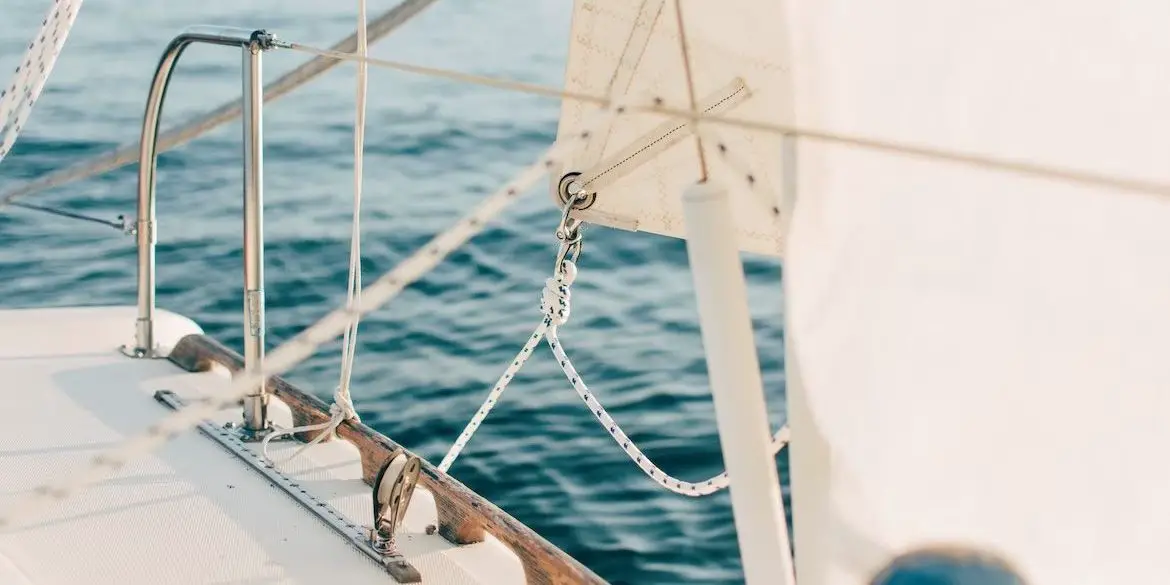
This calculator will help you estimate the total weight of your boat by considering various factors such as dry weight, fuel and water capacity, holding tanks, and more. Please fill in all the required fields and select your preferred units.
Estimated Total Weight:
Please note that the calculated weight is an approximation and may not be completely accurate. Always consult the boat manufacturer for precise specifications.

You Might Also Like
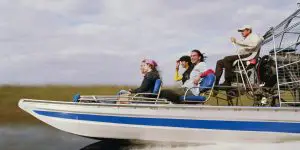
How to Register a Boat in Florida (2023)

Boat Calculators

Service Locator
- Angler Endorsement
- Boat Towing Coverage
- Mechanical Breakdown
- Insurance Requirements in Mexico
- Agreed Hull Value
- Actual Cash Value
- Liability Only
- Insurance Payment Options
- Claims Information
- Towing Service Agreement
- Membership Plans
- Boat Show Tickets
- BoatUS Boats For Sale
- Membership Payment Options
- Consumer Affairs
- Boat Documentation Requirements
- Installation Instructions
- Shipping & Handling Information
- Contact Boat Lettering
- End User Agreement
- Frequently Asked Questions
- Vessel Documentation
- BoatUS Foundation
- Government Affairs
- Powercruisers
- Buying & Selling Advice
- Maintenance
- Tow Vehicles
- Make & Create
- Makeovers & Refitting
- Accessories
- Electronics
- Skills, Tips, Tools
- Spring Preparation
- Winterization
- Boaters’ Rights
- Environment & Clean Water
- Boat Safety
- Navigational Hazards
- Personal Safety
- Batteries & Onboard Power
- Motors, Engines, Propulsion
- Best Day on the Water
- Books & Movies
- Communication & Etiquette
- Contests & Sweepstakes
- Colleges & Tech Schools
- Food, Drink, Entertainment
- New To Boating
- Travel & Destinations
- Watersports
- Anchors & Anchoring
- Boat Handling
- ← Safety & Prevention
Boat Weight Regulations
Advertisement
Portlier passengers have led to new rules from the Coast Guard. Could curvy cruisers be the next to get whipped into shape?
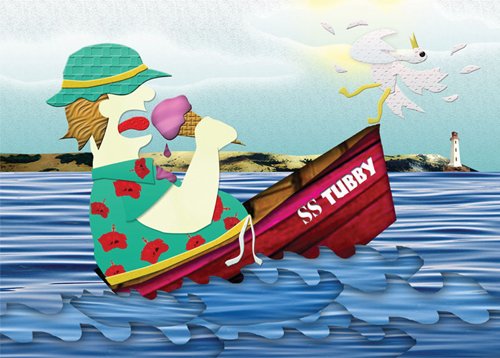
The average American has put on a considerable number of pounds in the past 40 years, so many that the U.S. Coast Guard recently adjusted the federal safety regulations governing the number of passengers that may be carried aboard commercial vessels, such as tour boats, water taxis, and ferries, meaning they're allowed to carry fewer people than before. The Coast Guard is concerned about what might happen if heavy passengers all move to one side, for example, when a ferry docks or an excursion boat moves in to view a migrating pod of whales. Will federal weight capacity regulations for recreational vessels change as well?
"We don't see a need to follow this line of action for recreational boats at this time," said Phil Cappel, chief of the Coast Guard's Recreational Boating Product Assurance Branch. He explained that the "recreational boat persons" capacity equation is based on a family of four — with an average weight per occupant of 165 pounds, and takes into account the variety of different boat types and hull configurations.
"As with all of our safety regulations, they're reactive and not proactive," Cappel explained, "which means we need to have proof that heavier boaters are increasing the number of accidents, injuries, or deaths before we can move forward with regulatory action. We have not seen any proof to that effect in our accident data."
Recreational monohull boats up to 20 feet in length are required to have capacity labels indicating what's safe to carry in terms of engine horsepower, cargo (including gear and engines), and passengers. Hull displacement — the mass of water a hull displaces when floating — is the basis for all weight capacity calculations. "Persons" capacity information includes both the number of passengers who may be carried safely, as well as the total weight of those passengers. It's the most prominent information listed on the capacity label, because people are considered to be the "live load," meaning they can move around inside the boat, affecting stability. Overloading a boat reduces freeboard and increases instability and the risk of swamping in rough weather.
Vessels of more than 20 feet aren't required to have labels, although boats up to 26 feet built to the American Boat & Yacht Council (ABYC) standards adopted by the National Marine Manufacturers Association (NMMA) do. An estimated 94 percent of recreational boats sold in the U.S. are built by 145 companies, all of which are members of NMMA and are required to follow the organization's boat and yacht certification guidelines.
The weight capacity ratings for commercial passenger vessels, which are governed by a completely separate set of federal regulations than for recreational boats, were adjusted in response to a report by the Centers for Disease Control and Prevention (CDC) showing that the average weight of an individual in the United States has increased to 185 pounds, up significantly since the passenger-carrying regulations went into effect in the 1960s, when the average American weighed 160 pounds.
"We realize that there is not always a family of four aboard a recreational boat and that the average weight of Americans has increased," Cappel said. "Recreational boats have a safety factor built into the capacity calculations and can carry much more weight than the maximum weight placed on the capacity label."
According to John Adey, ABYC's technical director and one of the BoatUS Ask The Experts, recreational outboard-powered boats can safely carry a pound of weight — in passengers, cargo, or engine — per five pounds of displacement. On inboard- and stern drive-powered boats, this "fudge factor" ratio goes to one pound of weight to seven pounds of displacement. He added that safe passenger loading is also controlled by the number of "underway seating positions." For example, two slim adults taking four or five small children out for a spin on a boat designed to seat four would be taking a big safety risk, even though the total passenger weight might be well under the boat's stated capacity.
Adey said that ABYC paid close attention when the Coast Guard announced changes to the commercial-vessel passenger-carrying regulations. "Everyone had the perception that [the criteria for determining] recreational boat capacities were about the same as those for commercial vessels." But, he said, the cargo-weight-to-displacement "fudge factor" makes loading recreational boats a bit safer.
Federal weight capacity ratings are not mandatory and are intended as a guide for boat operators. Even so, state boating law-enforcement agencies may hold operators accountable for overloading or unsafe loading.
Float Your Boat
Federal requirements mandate that outboard-powered boats 20 feet and under must be built with enough flotation to keep the passenger-carrying area at or just below the water's surface, in the event of swamping or capsizing. Inboard- and I/O-powered boats' designs warrant less rigorous basic flotation requirements, which allow that one part of the hull remain above the surface of the water. In both cases, a "survival platform" is created where boat occupants can stay until help arrives. If an overloaded boat swamps or capsizes, its built-in flotation may not be sufficient to keep the hull from sinking.
Sailboats, regardless of size, are not subject to flotation requirements — not because they don't sink, but simply because, by Coast Guard calculations, they're not involved in enough accidents to warrant tougher standards.
Weight, Weight — There's More!
Matching the correct horsepower engine to the boat is also an essential consideration that involves weight and safe loading. In addition to persons-weight capacity, boat labels must indicate the maximum horsepower the boat can safely handle. Horsepower capacity deals with two concerns that must be addressed when attempting to match an outboard engine to a boat: horsepower and weight. Too much power can make a boat difficult to control and too much weight, whether "live load" or gear, can lead to stability problems.
Federal horsepower ratings apply only to outboard engine-powered boats less than 20 feet in length. When these regulations were written in the early 1970s, virtually all outboards suitable for smaller boats were two-stroke configurations covering a broad range of horsepower. In the past decade, however, four-stroke outboard engines have broken higher and higher horsepower thresholds, making them viable candidates for installation on more boats. But, due to more complex valve systems, four-stroke engines weigh 10 to 15 percent more than their two-stroke counterparts.
Do boats equipped from the factory with four-stroke engines create a handling and stability risk? Are boaters who retrofit their vessels with four-stroke engines taking a dangerous chance? No, according to John Adey. Once again, the fudge factor that provides a margin of safety when loading passengers gives boat operators some leeway with engines. Plus, ABYC's engine-weight calculations are updated annually to reflect new models and new technology. Will federal standards be rewritten to include four-strokes? "Probably not," Adey says. "Once you achieve a high level of safety, there's no point in backing off.
Counting Calories
The health website, www.WebMD.com , lists the following calculations of calories burned, based on 150 pounds body weight:
Related Articles
The truth about ceramic coatings for boats.
Our editor investigates the marketing claims of consumer-grade ceramic coatings.
Fine-Tune Your Side Scan Fishfinder
Take your side-scanning fishfinder off auto mode, and you’ll be spotting your prey from afar in no time
DIY Boat Foam Decking
Closed-cell foam flooring helps make boating more comfortable. Here’s how to install it on your vessel
Click to explore related articles
Caroline Ajootian
Contributor, BoatUS Magazine
Caroline Ajootian is the former AVP of BoatUS Consumer Affairs.
BoatUS Magazine Is A Benefit Of BoatUS Membership
Membership Benefits Include:
Subscription to the print version of BoatUS Magazine
4% back on purchases from West Marine stores or online at WestMarine.com
Discounts on fuel, transient slips, repairs and more at over 1,200 businesses
Deals on cruises, charters, car rentals, hotel stays and more…
All for only $25/year!
We use cookies to enhance your visit to our website and to improve your experience. By continuing to use our website, you’re agreeing to our cookie policy.
Your browser is out-of-date! You must upgrade to a different browser to experience this site.
All Chapters
- Boating Terminology
- Boat Hull Types & Designs
- Boat Engine Types Explained
Boat Size Classifications
Boat Capacity
- Hull Identification Numbers
- Boat Registration & Titling
- Life Jacket Types & Designs
- Children's Life Jacket Recommendations & Requirements
- PFD Rules & Requirements
- Life Jacket Fitting & Care Guidelines
- Inflatable PFD Types & Tip
- Boat Fire Extinguishers
- Boat Backfire Flame Arrestor
- Boat Ventilation Systems
- Boat Navigation Light Types & Requirements
- Unpowered Boat Navigation Lights
- Visual Distress Signals
- Marine Distress Signals
- Weather Conditions
- Small Craft Advisory
- Boat Maintenance Tips
- Towing & Trailering
- Launching & Retrieving
- Pre-departure Checklist
- Rendering Assistance
- Capsizing/Falls Overboard
- Cold Water Immersion
- Fire Prevention
- Running Aground Prevention
- Accident Reports
This site requires JavaScript. Your browser either doesn’t support JavaScript or you have it turned off.
For this page to function correctly, please enable JavaScript and then refresh the page.
One of the most important things you need to know before setting out on the water is the maximum number of people and maximum amount of weight that your boat can safely handle. Not only is this an important safety concern, it's also the law.
Federal Law mandates that all powerboats less than twenty feet in length need to carry this information in the form of a Capacity Plate.
Each Capacity Plate includes the maximum number of adult persons, the maximum gross load, and the maximum size of engine, in horsepower, that your boat can legally carry.
The next time you're around a boat, look for its Capacity Plate; it should be permanently fastened near the steering area, or the helm.
Before any boat trip, you'll want to make sure that you are not taking more people onboard than is indicated by the Maximum Person number, and that you don't have more total weight than is indicated by the Maximum Gross Load. The Maximum Gross Load is the total weight your boat can handle, including people, equipment, stores, fuel, engine assembly and steering controls. If your boat doesn't have a Capacity Plate, you can calculate the number of people you can safely take onboard using the following equation.
Boat Capacity Calculation
If your boat doesn't have a Capacity Plate, you can calculate the number of people you can safely take onboard using the following equation and calculator.
Number of people = vessel length (ft.) x vessel width (ft.) ÷ 15
First, find out the length and width of your boat in feet, then use our calculator to find out your boat's capacity.
Note that personal watercraft do not have a capacity place. For P-W-C's, always follow the recommended capacity in the owner's manuel and on the manufacturer's warning decal.
Finally, the Capacity Plate will also indicate the maximum engine power for your boat, given in horsepower. This number applies only to boats powered by outboard engines; and it must never be exceeded.
Maximum Person Capacity
There are a number of variables that boat manufacturers consider when determining the maximum person capacity that appears on your Capacity Plate.
One of those variables is the weight of each person.
Boat manufacturers typically use an average weight of about one hundred and fifty pounds per person to calculate maximum capacity. It can be a little more or a little less, but if some or all of your passengers weigh over one hundred fifty pounds, you may have to decrease the number of passengers you can safely take on board.
Remember, the maximum person capacity is a guideline that you have to adjust given the weight of your passengers and the other supplies you are taking on board.
If you are carrying heavy equipment, you may have to further reduce the number of passengers.
Maximum Horsepower
If you don't have a capacity plate on your boat—which may be the case if you're operating a small, flat-bottomed boat—you can calculate the largest safe engine size in the following way.
Maximum Horsepower Calculation: Boat length x boat width = boat square footage
First, find out the square footage of your boat by multiplying its length by the width of the transom.
Then use our calculator and the table here, to find out your boat's maximum horsepower. For example, a twelve-foot boat with a four-foot transom width translates into a maximum engine size of fifteen horsepower.
Overloading or Overpowering
Either overloading or overpowering your boat is extremely dangerous.
Putting an over-sized engine on your boat will cause your boat to sit too low in the stern , and that will make it much more susceptible to being swamped by its own wake or that of a passing boat. An overpowered boat is also hard to control.
What about overloading your boat? Overloading your boat, either with too many people or too many supplies, also makes your boat susceptible to swamping.
Even if you are within the maximum allowable weight, make sure that you distribute the load evenly, focusing the weight in the middle of the boat. This will keep your boat stable in the water and help prevent capsizing or swamping.
Finally, remember that in bad weather, you must be extra careful about how much weight you take in your boat. With higher waves, a heavy boat is harder to control and more susceptible to being swamped. Stay safe. Follow the guidelines for load capacity and always adjust for bad weather.
Beware of bad weather! Take much lighter loads in poor weather conditions to ensure boat stability.
Hull Identification Number

Free US Shipping on Most Orders Over $99 * - Learn More »
ORDERS SHIP NEXT BUSINESS DAY*
60 days return period - Learn more

- Apparel - Board Shorts
- Apparel - Footwear
- Apparel - Hats
- Apparel - Hoodies & Longsleeves
- Apparel - Rash Guards & Sun Shirts
- Apparel - Sunglasses & Goggles
- Apparel - Tanks & Tees
- Boat - Anchor Rope
- Boat - Boat Anchor
- Boat - Boat Ladders
- Boat - Boat Lights & Flags
- Boat - Boat Mirrors
- Boat - Boat Pylons & Booms
- Boat - Buoys
- Boat - Maintenance & Cleaners
- Boat - Pontoon Accessories
- Boat - Propellers
- Boat - PWC Accessories
- Boat - Safety Equipment
- Boat - Trailering Accessories
- Dock - Dock Accessories & Storage
- Dock - Dock Ladders
- Dock - Fenders & Mooring Lines
- Floats and Parks - Inflatable Dock & Swim Platform
- Floats and Parks - Inflatable Water Park
- Floats and Parks - Inflators & Deflators
- Floats and Parks - Pool Floats, Lounges, & Rafts
- Floats and Parks - Water Mat
- Floats and Parks - Water Trampoline
- Gift Ideas - Christmas
- Hydrofoil - Foil Surf Board
- Hydrofoil - Ski Foil
- Hydrofoil - Wake Foil
- Kayak - Kayak Accessories
- Kayak - Kayak Paddles
- Kneeboard Accessories
- Life Jackets - Infant Life Jackets
- Life Jackets - Kid's Life Jackets
- Life Jackets - Men's Life Jackets
- Life Jackets - Non-CGA Comp Vests
- Life Jackets - Paddle Life Jackets
- Life Jackets - Pet Life Jackets
- Life Jackets - Women's Life Jackets
- Ski - Barefoot Skiing
- Ski - Gloves
- Ski - Kneeboards & Multipurpose Boards
- Ski - Ski Bags
- Ski - Ski Bindings
- Ski - Ski Combos
- Ski - Ski Hardware
- Ski - Ski Ropes & Handles
- Ski - Ski Trainers
- Ski - Slalom Water Ski
- Ski - Slalom Water Ski Packages
- Ski - Trick & Jump
- Suits - Drysuits
- Suits - Wetsuit Accessories
- Suits - Wetsuits
- SUP - Paddleboards
- SUP - SUP Accessories
- SUP - SUP Paddles
- Towables - Boat Tubes
- Towables - Inflators
- Towables - Sea Sleds
- Towables - Tow Rope for Tubing
- Towables - Tube Repair Kits
- Wake - Ballasts & Pumps
- Wake - Helmets
- Wake - Kid's Wakeboards
- Wake - Kid's Wakesurf Board
- Wake - Packaged Wakeboards
- Wake - Wake Boots
- Wake - Wake Cases
- Wake - Wake Fins & Hardware
- Wake - Wake Ropes & Handles
- Wake - Wake Shaper
- Wake - Wake Skate
- Wake - Wakeboard
- Wake - Wakesurf Board
EARLY SEASON OUTLET SALE
Save up to 55% off popular gear!
How to Pick a Boat Anchor: The Guide to Types, Sizes & Weights
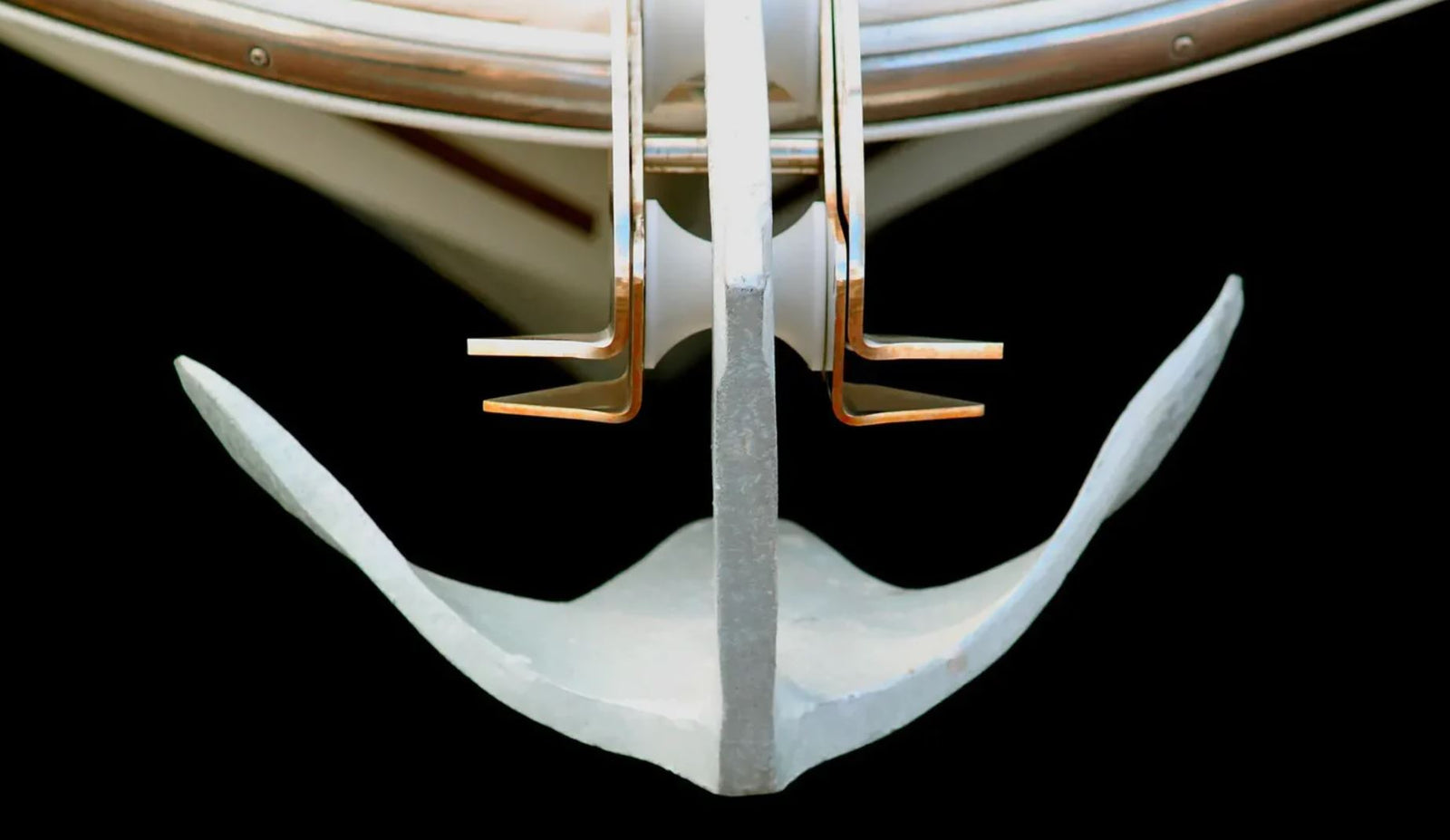
October 20, 2023
Lakes can get choppy, and river currents can drag you along when you'd rather stay put. Having the right anchor on your boat is crucial, especially if you're busy staging for a wakeboard or ski ride .
But what type and size of anchor is best for your setup?
Types of Boat Anchors
Let's look at the most popular types of boat anchors, and look at some charts to figure out what size and weight anchor is right for you.
Fluke Anchors
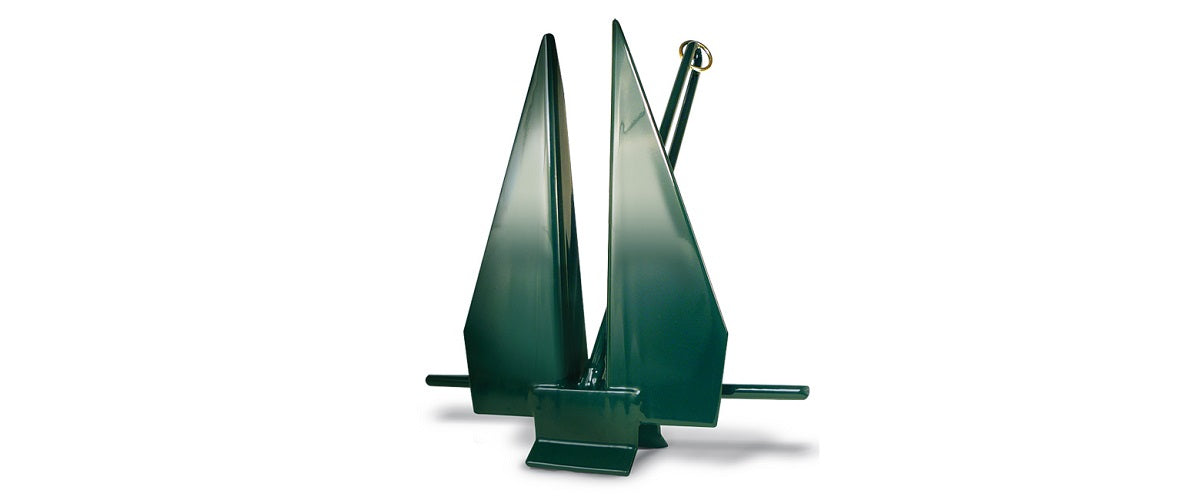
Also known as a Danforth anchor, the fluke anchor is favored by lake and river boat owners for its lightweight design and excellent holding power in soft bottoms.
Fluke anchors have a rotating bar that connects the anchor to the line. Their forward-heavy profile allows the flukes to drive straight down into sand or mud. As line is laid out, the bar swivels into a horizontal position, providing good scope.
- Boat Size: 30 feet or less
- Best For: Lakes, rivers, mud and sand
- Bad For: Rocks, debris, coral, strong currents
Plow Anchors

Also called a delta anchor, the plow anchor is one of the most popular anchors on the boat market. It's simple and effective, capable of providing reliable mooring in all water conditions and most beds.
Plow anchors dig into the surface below and they provide high holding power. They set quickly, which makes them an excellent choice when strong currents and winds could otherwise quickly move your boat.
But plow anchors' large, flat fins can get stuck in debris and large rocks, so it's best to stick to softer bottoms.
- Boat Size: 70 feet or less
- Best For: Sand, mud, grass bottoms, strong winds
- Bad For: Rocky bottoms
Claw Anchors

Also known as a Bruce anchor, the claw anchor is similar to a plow anchor: It sets quickly and digs into soft bottoms, providing good holding power against currents and wind -- though not as well as a plow.
Because claw anchors use smaller pins, they're better suited in gravel and rock, affording a lower risk of catching and getting stuck where a plow anchor might get hung up.
Digger Anchors

The digger anchor excels at providing high holding power in gravel and rocky bottoms, even with strong currents and high wind. It uses a rod that partially rotates, while limiting the angle of the anchor line's scope.
As current and wind pull on the boat, the rod's limited angle pulls on the anchor's claws, pushing them further into the bottom. The digger's thin, long claws work great in virtually all bottom, including gravel and small rocks -- just avoid large debris, as the limited angle of the anchor rod prevents it from being pulled back out of a snag effectively.
- Boat Size: 40 feet or less
- Best For: Sand, mud, grass, gravel, strong winds
- Bad For: Bottoms with large debris
Navy Anchors

The classic, heavy, big navy anchor excels at providing high holding power in all waters and conditions. Its size and shape make it suitable for rocky bottoms and debris fields, as it has little risk of getting snagged.
The only problem with a navy anchor is that its benefits can become problematic for smaller vessels: Because navy anchors are large and heavy, they can be difficult to stow, and they add plenty of weight to the hull.
- Boat Size: 20+ feet
- Best For: All bottoms, currents, and weather
- Bad For: Small, light boats
Mushroom Anchors

The mushroom anchor is made for small vessels in relatively calm waters with soft bottoms. It relies on suction and sinking into sand, dirt, and mud to provide holding power. These anchors are typically found on light, electric motor-powered boats, kayaks, and dingy boats.
- Boat Size: 12 feet or less
- Best For: Soft bottoms free of rock
- Bad For: Large boats, heavy currents, rocky bottoms
River Anchors

Like the mushroom anchor, the river anchor is also intended for small vessels in lakes and rivers -- but with one exception: The river anchor works well in rocky bottoms and beds filled with debris. The wide, flat flukes work best when they can grab hold of objects on the floor. River anchors work well enough in soft bottoms, albeit with less holding power than a mushroom.
- Best For: rocky bottoms and debris fields
- Bad For: Large boats, heavy currents
Choosing The right Size Anchor
When selecting a boat anchor, it's important to consider the following factors:
The size and weight of your boat will determine the size and weight of the anchor you need. As a general rule, the heavier the boat, the larger and heavier the anchor should be.
Water and Weather
The type of weather and currents you encounter will influence your anchor choice. Different anchors perform better in different conditions, so it's important to choose one that suits your boating environment.
Conditions of Water Bed
The floor your anchor rests upon can vary wildly. Some lakes and rivers have rocky bottoms filled with debris, while others have soft silt or sand. Picking the wrong setup could mean you wind up drifting, or worse, cutting line because your anchor got stuck at the bottom.
Anchor Weight vs. Boat Size Chart
The chart above is a general guideline for selecting the appropriate anchor weight for your boat. Conditions on the water, and the weight of your boat -- regardless of its size -- could mean you need a heavier anchor.
Anchor Chain vs. Rope
When it comes to anchoring, you'd think chain is far superior to rope. But chain really only provides two advantages: It adds holding power, helping to keep your boat moored in one spot in rough water and strong currents, and it resists chafing -- it won't suffer damage from being dragged along debris and rocks.
Chain is heavy, though, so it adds weight to your craft when not being used. This isn't a concern on large, sea-going vessels. But you probably don't want that added weight when you're cruising around on the river or lake, especially when towing a wakeboard, tube, or skis.
Chain also rusts, even with regular maintenance, and it's expensive. Nowadays, synthetic anchor rope is tough and abrasion-resistant, and it withstands water and sunlight incredibly well. It's also lightweight relative to its strength, and it takes up much less space than chain.
The most effective setup combines a bit of chain near the anchor, with rope making up the rest of the line. Just a few feet of chain is needed to ensure your anchor is properly seated. This bit of chain also improves the scope of your line. "Scope?" You, say? Read on.
It's All About Scope
Rope alone will provide as much holding power as chain, so long as your scope is correct. Scope measures the ratio of the length of deployed rope (or chain) to the height from the ocean, lake, or riverbed to the anchor point on the boat.
The minimum effective scope you need to properly moor your vessel with any anchor and line is 5:1. That means if the depth from your boat's topside to the underwater floor is 5 feet, you need 25 feet of rope laid out below. This affords about 75% of the maximum holding power of your anchor and line.
A scope of 10:1, laid perfectly flat on the bed below, provides 100% holding power. Using the same 5 foot depth, you'd need 50 feet of anchor rope or chain laid out for max holding power.
Need a new anchor setup? Check out our boat anchors and anchor lines !
Previous Next
SHOP AT BART'S WATER SPORTS:
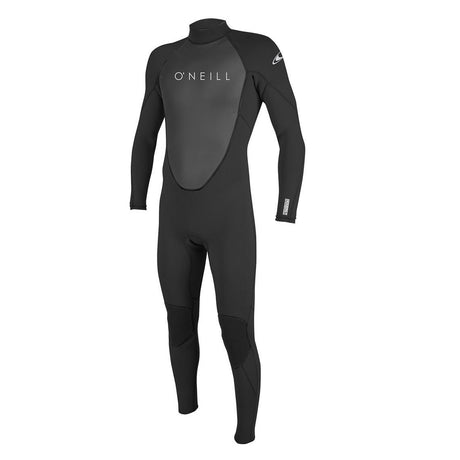
O'Neill Wetsuits
O'Neill Men's Reactor II Full Wetsuit
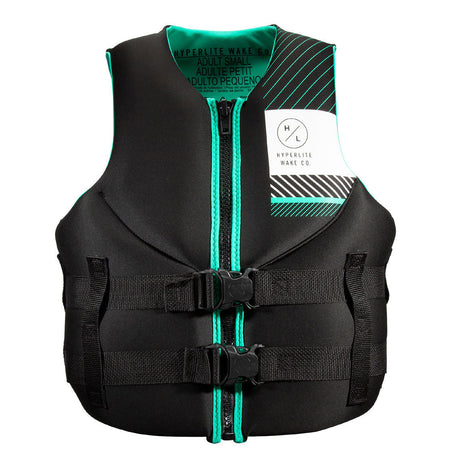
Hyperlite Women's Indy Life Jacket
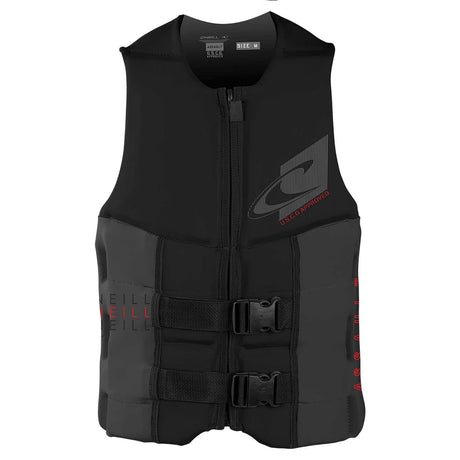
O'Neill Men's Assault Life Jacket

vendor-unknown
Wakeboarder Ornament
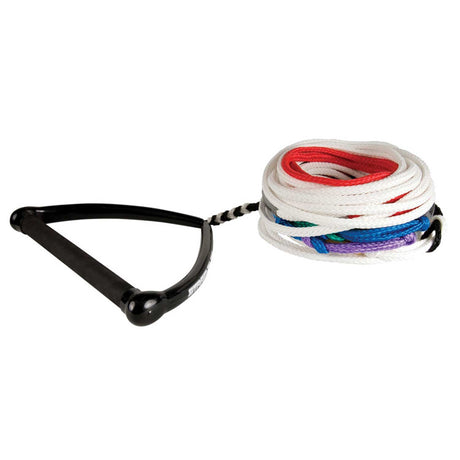
Straightline
StraightLine LE Team Handle w/ 8-Section Heavy Duty Mainline

O'Neill Fluid Drysuit
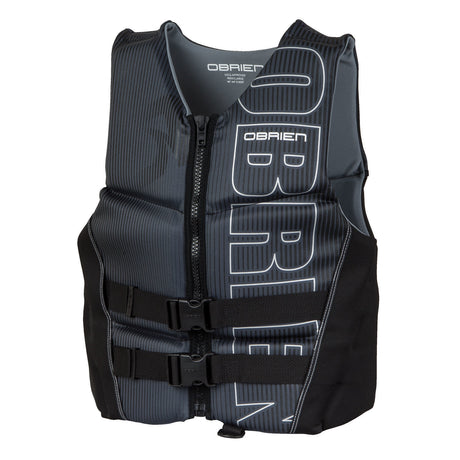
O'Brien Watersports
O'Brien Men's Flex V-Back Life Jacket
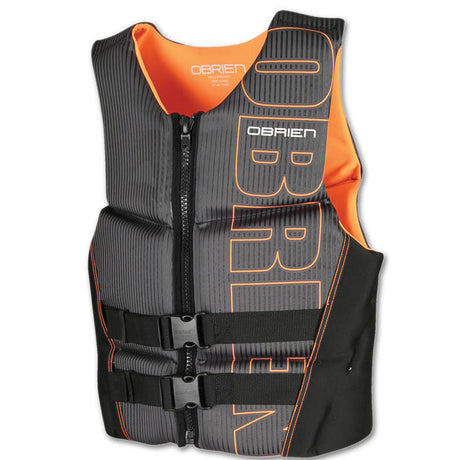
Your cart is empty
Subtotal:$0.00 USD
Experts on Staff
Customer service 7 days a week
Fast Shipping
Usually ships by the next business day
America's Favorite Water Sports Store
Price-match guarantee
Our promise to you
Choose options
- Weird But True
- Sex & Relationships
- Viral Trends
- Human Interest
- Fashion & Beauty
- Food & Drink
trending now in Lifestyle

Chick-fil-A making changes to its famous chicken

Europeans can't get over certain things Americans accept as...

Dear Abby: My boyfriend wants to marry me — but he's ugly

I had sex with the boss, now she's pursuing me - what do I do?

Dear Abby: I discovered my daughter and son-in-law's sexual...

I'm a hospice nurse — this is what happens in the distressing...

I work on a cruise ship — this is what we hate about some...

I'm an ex-cruise ship worker — here's the shocking reason we...
A look at the splashiest yachts at the palm beach international boat show.
- View Author Archive
- Get author RSS feed
Thanks for contacting us. We've received your submission.

Spectacular multi-million dollar yachts — check! Balmy, waterfront location — check! Family-friendly exhibitions and fun — check!
Then it must be the 42nd annual Palm Beach International Boat Show, which cruised into West Palm Beach this week. The city’s waterfront Downtown was transformed into a yachters’ haven, filled with ultra-luxurious yachts and cruisers and a seemingly endless range of yachting-inspired activities.
This year some 800 boats and yachts participated in the show, which is expected to lure over 55,000 total visitors along with 600 brands. In total, the four-day show is anticipated to pump over $1 billion into the economy of the Palm Beach area, which has seen both its population and popularity surge since the pandemic.

“Beyond its economic significance and standing in the industry, the Palm Beach International Boat Show holds a special place in the hearts of local residents, revered as one of the region’s must-attend events,” said Alyssa Freeman, executive director of the Marine Industries Association of Palm Beach County (MIAPBC).
The show supports a series of satellite events such as the Winward VIP Club, with an open bar, gourmet dining and special pop-up activations. The Super Yacht Show Palm Beach at Palm Harbor was where the show’s most glamorous — and truly gargantuan — superyachts are on display. At the AquaZone, which is presented by Nautical Ventures, guests can enjoy a “show within a show” via an interactive experience featuring a wide range of water sports and cutting-edge, marine-related products.
“The Palm Beach International Boat Show holds a special place in the hearts of local residents.”
As always, the Show delivers an exceptional array of culinary experiences, including world-class cocktails provided by sponsors such as Goslings Rum. The Show also includes a series of education seminars that appeal to visitors of all ages, including the Hook the Future’s Kids Fishing Clinics with Captain Don Dingman, who demonstrates various fishing techniques while showcasing a wide variety of fish species. Participants get a free Hook the Future x Carolina Skiff rod and reel combo.
But it’s really all about the boats. Here are five of the most unique, intriguing and eye-popping vessels on display.
The lucky charm

Few yachts at this year’s show are as jaw-dropping as Talisman C. Designed by London-based interiors aces H2 and manufactured by Turkish master yacht-builders Proteksan Turquoise, it’s currently listed for sale by British yachting firm Burgess for a cool $59.7 55 million. Spanning just over 231 feet long, it features six full-sized cabins that can sleep up to 14 guests, including a sprawling owner’s suite with its king-size bed and crystal chandelier, massive walk-in closet and grand library (which can easily be converted into an additional cabin).
Upstairs, the yacht’s sundeck features a large glass-encased Jacuzzi, sun beds and dining area under the sun or stars. A chic swim platform allows for easy access to the azure seas while the nearby aft deck area includes a fully equipped bar with club seating as well as a full-size dining area capped by a glass-threaded chandelier.
The vessel is powered by a pair of 2,447hp Caterpillar diesel engines, which provide a top speed of 18 knots, a cruising speed of 15 knots and a transatlantic range of 7,000 nautical miles.
The emperor

Reaching just under 300 feet in length, the Nero is, without doubt, one of the most eye-catching vessels at the entire Palm Beach show. Although completely contemporarily designed and manufactured, the Nero embodies the look and aesthetic of classic boats from yachting’s golden age during the 1930s. Fully overhauled in 2021, the Nero — which is currently on the market for just under $500,000 per week via Burgess — was designed in the spirit of Corsair, a yacht launched in the 1930s that belonged to legendary Wall Street financier J.P. Morgan.
Inside, it could not be more luxurious. On the top deck is a world-class gym fitted out with equipment by Technogym, while a few steps beyond is a beauty salon, which comes with an in-house beautician and masseuse.
There are six cabins with room for 12 guests — along with an on-board Jacuzzi, pool and waterslide. Throughout, veteran yacht designer Laura Pomponi has updated and upgraded the Nero’s look, introducing a range of new handmade carpets, along with hardwood floors, new sofas and elegant art-works. Pomponi has also lent her hand to Nero’s distinctive 30-foot Corsair custom-built tender that has been refitted so guests can arrive in impeccable style.
The secret agent

As its name suggests, the 236-foot Casino Royale brings a large dose of Bond-like elegance and intrigue to West Palm Beach. Constructed by Italian master shipbuilder Tankoa in 2018 and given a top-to-bottom retrofit in 2022, Casino Royale includes six cabins for 12 passengers and has been awarded a slew of industry accolades for its innovative and forward-thinking technology and aesthetic. Nearly two dozen crewmembers tend to those lucky voyagers, which luxuriate in an on-board circular swimming pool and access the ship via a helicopter port.
The yacht’s primary suite is nothing if not grand, featuring 180-degree views from its king-size bed along with its own study and al fresco terrace with private sunbed and Jacuzzi. There are five additional guest suites — all with their own private baths. Just beyond is an open-air living layout complete with a range of bespoke contemporary furnishings across the boat’s nearly half-dozen passenger decks.
Outside the amenities are just as abundant and include an onboard beach club with a lounge, bar, sauna, terrace and hammam/shower. All are ideal locations to rest and recharge after a workout in the yacht’s wellness center. On the main deck, there’s a nearly 20-foot-long infinity pool, while that helipad can easily convert into a dance floor.
The love boat
View this post on Instagram A post shared by Edmiston & Company (@edmistonyachts)
Completely futuristic and totally cool, the 180-foot-long Come Together is the ultimate example of stealth wealth on the high seas. Completed just two years ago by the Dutch firm Amels and currently on the market for a cool $65 million, Come Together features an unmistakable architecturally styled exterior reminiscent of a city-center skyscraper.
The boat can house up to 14 guests and 13 crew members within its unmissable steel hull and an aluminum-clad super structure — all cruising at a top speed of 15.5 knots.
The boat’s expansive master suite is set within its main deck and features sprawling storage space, a dressing room as well as his and hers bathrooms. There are an additional VIP cabin, two double cabins and two further cabins that can operate as twins or doubles. Up top, there’s a fully equipped gym and Jacuzzi — while a set of Jet Skis, water skis and hover-like Seabob watercraft keep the fun going just off deck. Come Together’s unique underwater lighting system also delivers a strong dose of excitement come nighttime and is the perfect way to enjoy an after-hours swim.
Want more? Then don’t forget about the on-board wakeboards, paddleboards and snorkeling equipment. And, when the moment strikes to head from the boat to land, travel could not be easier thanks to an easy-access 30-foot Limo Tender.
The cordial cruiser

The aptly named Hospitality ticks off the right boxes when it comes to superyacht bells and whistles. This twin-engine beauty can house up to 16 passengers along with 11 crew at a maximum cruising speed of 24 knots. Built back in 2011 by Westport Yachts here in the US, Hospitality — which is currently on the market for just under $30 million — underwent a comprehensive retrofit in 2021.
Along with all of the requisite yachting toys — Jet Skis, Seabobs and paddleboards — Hospitality includes a grand private owner’s suite with its own private relaxation balcony, seven cabins along with a relaxation room that can be used as a gym or spa and meticulously designed public spaces across is handful of decks. There’s also a handy tender for quick — or, not so quick — jaunts to the shore for dining and shopping.
Hospitality mostly cruises the Caribbean to New England, making the most of Northern Hemisphere winters.
Share this article:

Advertisement

IMAGES
VIDEO
COMMENTS
The weight of a boat can vary a lot mostly depending on the length of the boat and the materials used for the boat. There are also many other factors such as size/amount of engines, size of the fuel tank, amount of gear on board, size of the cabin, and much more. ... On average, yachts that are 55-65 feet long weigh around 75,000-100,000 pounds ...
1. Luxury Yacht. Yachts are normally classified as any watercraft that can be used for pleasure or sport and can range from 30 ft to over 100 ft. While a yacht can be as small as 30 ft. long, a yacht is often considered a cabin cruiser until it is 39 ft. or more, then it is considered a proper yacht.
Here are some general boat weights to consider before we get into the details: Type of Boat. Average Weight. Aluminum Fishing Boats. 300 - 500 pounds. Bow Rider. 3,000 - 3,500 pounds. Cabin Cruiser. 12,000 - 16,000 pounds.
Boat-Specs.com is an interactive database that allows you to discover and compare various sailboats and sailing yachts through their specifications. The multi-criteria search engine helps you to find exactly the boat you are looking for. Sailing boats (1605) Sailboat builders (93) Sailboat designers (150) Sailboat ranges (47) Sailboat ...
Boat weight: Boat type: Average boat weight: Vehicle for transportation: Skiff: 300 to 900 pounds (135 - 410 kg) Car, crossover: Sailboat ... 13.7 m) long yacht weighing 9,000 to 16,000 pounds (4,000 - 7,250 kg) on average. It is like a mini portable house you can use on the water with enough inside space for sleeping when necessary.
Aluminum Fishing Boats. Aluminum fishing boats usually fall in the 16 feet to 20 feet range. They are steered from a center console, and the seating can either be benches or seats. Depending on the design, they may include live bait wells or other extra bells and whistles. The weight of an aluminum fishing boat largely depends on the size of ...
Keep in mind, the weight of a boat differs based on hull material, mast type, and many other factors. Dinghies (less than 12'): 100 to 200 pounds. Small Sailboats (15' to 20'): 400 to 2,500 pounds. Medium Sailboats (21' to 25'): 2,500 to 5,000 pounds. Cruising Sailboats (27' to 32'): 7,000 to 12,000 pounds.
Pontoon Boat. 3,100 lbs. Big SUVs & Trucks. 7. Small Fishing Boat. 1,700 lbs. SUVs & Trucks. Remember that these boat types show only their dry weights. Up to 2,000 lbs can be quickly added by the weight of the trailer, fuel, and other pieces of equipment.
They can range from small recreational boats to large yachts. The weight of powerboats can vary significantly depending on their size, hull construction, and the number of engines. Smaller powerboats may weigh around 1,000 to 5,000 pounds (454 to 2,268 kilograms), while larger offshore powerboats can exceed 30,000 pounds (13,608 kilograms) or ...
The weight of a boat varies greatly depending on the type and size. Small sailboats can weigh between 400 to 800 pounds (181 to 363 kg), while large yachts can weigh up to hundreds of thousands of pounds (tens of thousands of kilograms).. The weight is a critical factor to consider for towing and for assessing which types of cars or trucks are equipped to handle the load.
Boat Weight Estimates. ... Cabin cruisers are sometimes described as mini yachts, which is the best way to think of them. The average cabin cruiser is somewhere between 8,000 and 8,700 pounds. Smaller models like the Larson Cabrio 274 are 2,000 pounds lighter (weighing in at approximately 6,000 pounds) while larger models like the Rinker ...
Boat weight is an important factor to consider for any boat owner or captain. Knowing the total weight of your boat, including both the dry weight and wet ... The greater the total surface area and internal capacity, the heavier the dry weight is likely to be. A 50-foot sport yacht will have a much higher dry weight than a 25-foot center ...
Boat Comparison & Benchmarking made easy! Benchmark your boat versus the "competition" or simply compare side-by-side. Spot differences easily among many boats and benchmark performance ratios! Full specifications database for boats, sailboats and yachts. Search and compare multiple boats, performance ratios etc. Benchmark your boat.
A 40-foot yacht can weigh anywhere between 8,000 and 10,000 pounds. The weight will depend on the materials used in construction and the size of the vessel. Heavier yachts will have a higher displacement, meaning they will sit lower in the water.
Here's a basic breakdown of average weights by boat type: Aluminum Fishing Boats: Typically range from 300 - 500 pounds. Bow Riders: Usually weigh around 3,000 - 3,500 pounds. Cabin Cruisers: Often weigh between 12,000 - 16,000 pounds. For larger vessels, the weights can significantly increase.
A tandem or triple-axle trailer is necessary for these boats. Yachts (30,000+ lbs, 40-100+ feet) Yachts are the epitome of luxury on the water. Due to their massive size and weight, they typically require professional transport, either by water or by specialized land trailers. ... The weight of a boat can vary greatly depending on its type ...
Understanding the exact weight of your vessel can be an interesting exercise from time-to-time. ... High Seas Yacht Service has the load cell scale equipment to weigh vessels up to 200,000 pounds. In order to weigh a boat it is necessary to haul with a travel lift to place the boat on a scale on hard ground.
©2022 Boats and Yachts Detailed Data And Technical Specs (Dimensions, Prices, Weight and Engine Power) ...
This calculator will help you estimate the total weight of your boat by considering various factors such as dry weight, fuel and water capacity, holding tanks, and more. Please fill in all the required fields and select your preferred units. Unit System: Imperial (lbs, gallons)Metric (kgs, liters) Dry Weight: Fuel Capacity: Water Capacity: Holding Tanks/Bait […]
An estimated 94 percent of recreational boats sold in the U.S. are built by 145 companies, all of which are members of NMMA and are required to follow the organization's boat and yacht certification guidelines. The weight capacity ratings for commercial passenger vessels, which are governed by a completely separate set of federal regulations ...
8,700 lbs. Trucks. *PWCs. 850 lbs. Cars, Vans, Trucks and SUVs. Keep in mind that these average weights are the dry weight of these boat types. The weight of fuel the fuel, trailer, and other accessories can add up to 2,000 lbs to these average weights which can highly impact their ability to be towed.
Number of people = vessel length (ft.) x vessel width (ft.) ÷ 15. First, find out the length and width of your boat in feet, then use our calculator to find out your boat's capacity. Note that personal watercraft do not have a capacity place. For P-W-C's, always follow the recommended capacity in the owner's manuel and on the manufacturer's ...
Fluke anchors have a rotating bar that connects the anchor to the line. Their forward-heavy profile allows the flukes to drive straight down into sand or mud. As line is laid out, the bar swivels into a horizontal position, providing good scope. Boat Size: 30 feet or less. Best For: Lakes, rivers, mud and sand.
This is the strange fruit that can be your weight loss gamechanger Woman stunned to learn $15 Goodwill dress has star-studded past ... This year some 800 boats and yachts participated in the show ...